2023 DUCATI DIAVEL V4
TESTED: 2023 SUZUKI GSX-8S
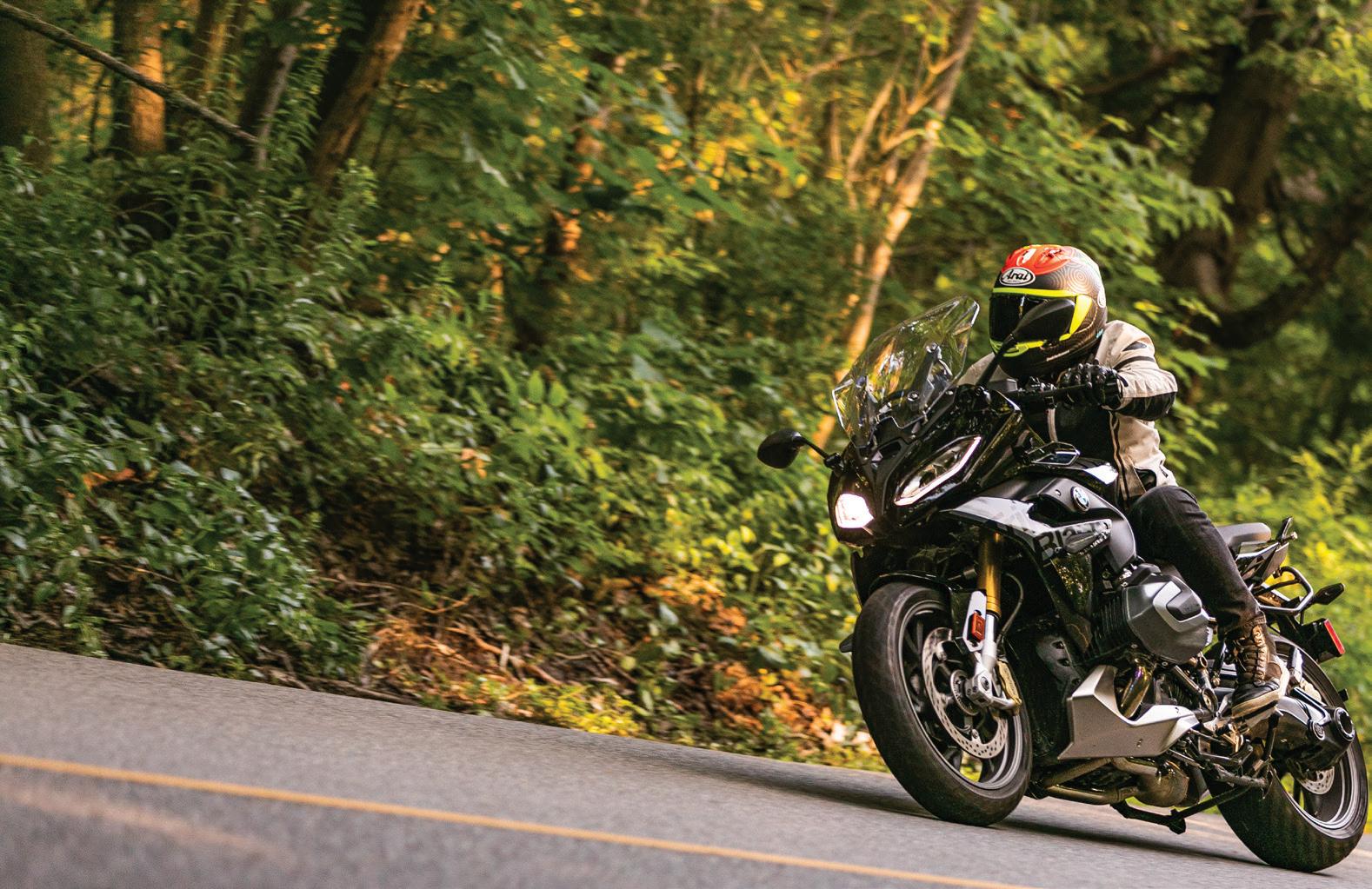
INSIDE TOURING: EXPLORING VANCOUVER ISLAND
RAPID CLASSICS: SUZUKI’S GAME CHANGING RG500
CANADIAN MOTORCYCLE HALL OF FAME: CLASS OF 2023
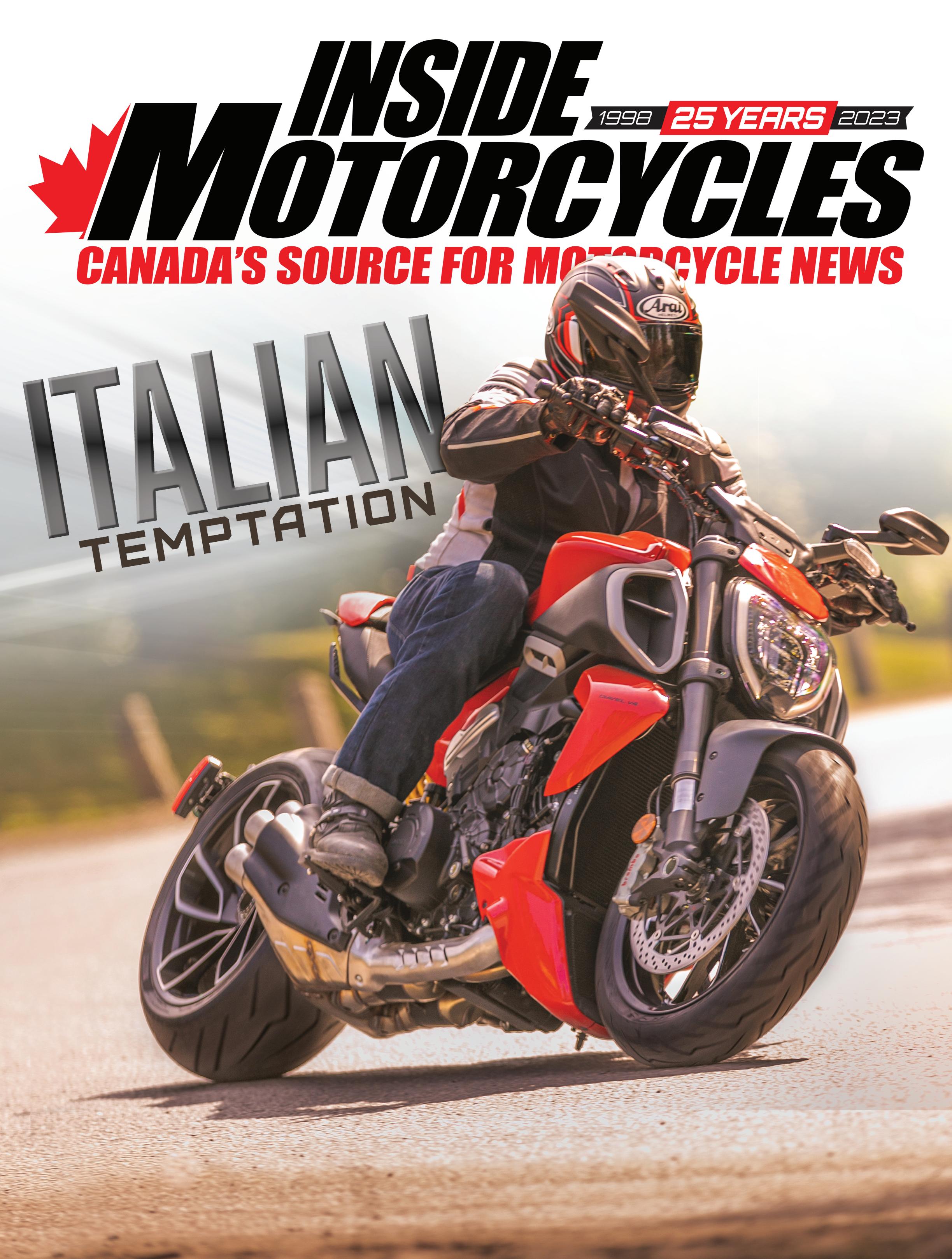
TIPS AND MORE
SPORT TOURING WITH STYLE
2023 BMW R 1250 RS
DISPLAY UNTIL NOVEMBER 17, 2023 • VOLUME 26, ISSUE 03 • $7.95
INDUSTRY NEWS, TECH
OCTOBER 2023 PM#40023793 R310661 CAN $7.95 • USA $7.95
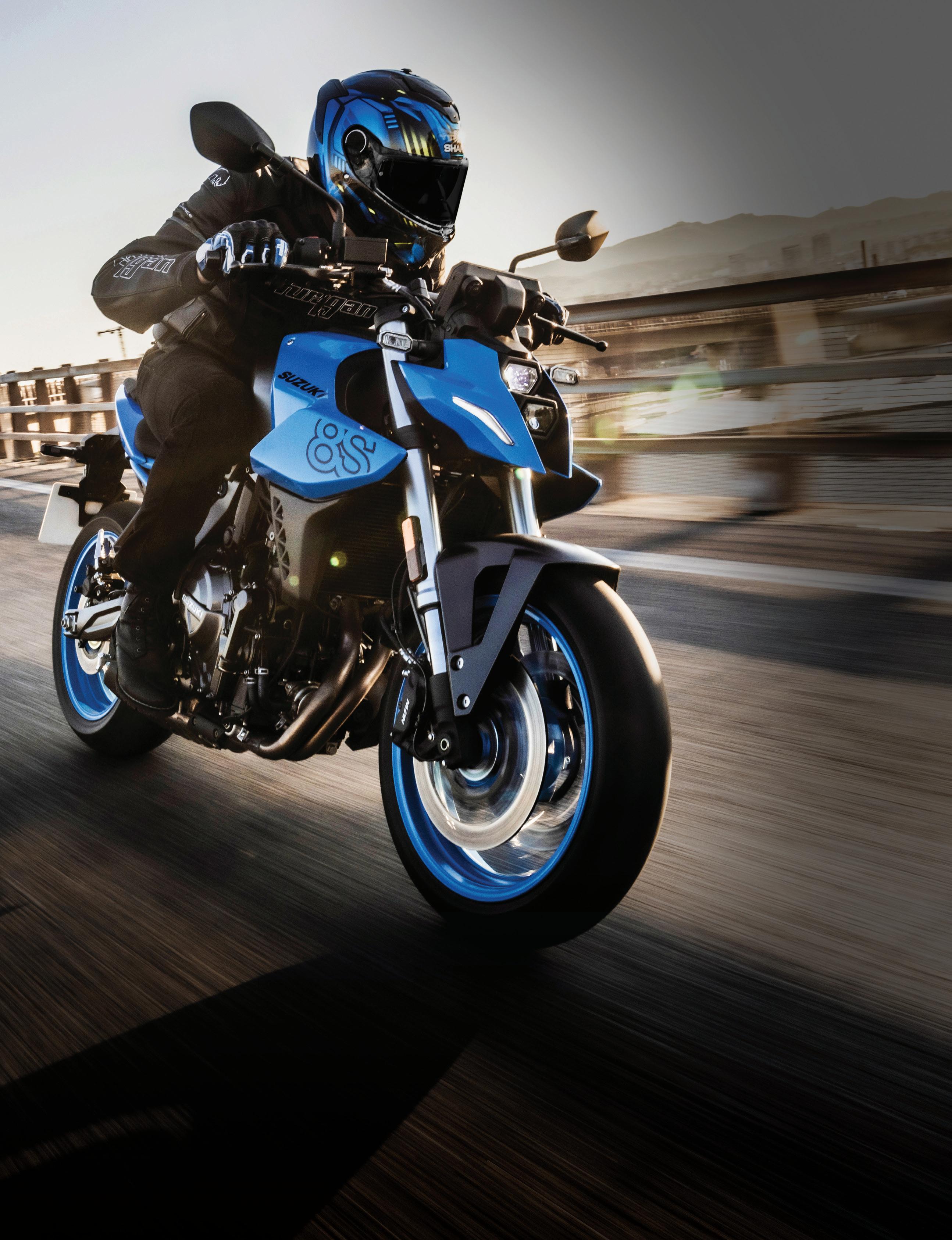



suzuki.ca/find-a-dealer @suzukicanada INTRODUCING THE STUNNING ALL NEW GSX-8S L IMITED SUPPLY Contact your dealer today! S TOP DREAMING . START RIDING . CUTTING EDGE STYLE MEETS HIGH-TECH PERFORMANCE Always wear approved protective gear and ride responsibly. Availability may be limited in some regions. Contact your local authorized Suzuki dealer for details. Actual product may vary from image shown
On the Cover: Since its introduction in 2011, the Ducati Diavel has represented the company’s interpretation of the modern-day power cruiser. For 2023, the Diavel gets a major upgrade in performance as the latest model to receive Ducati’s V4 engine. Senior editor Jason Thorpe’s review of the Diavel V4 begins on page 20.

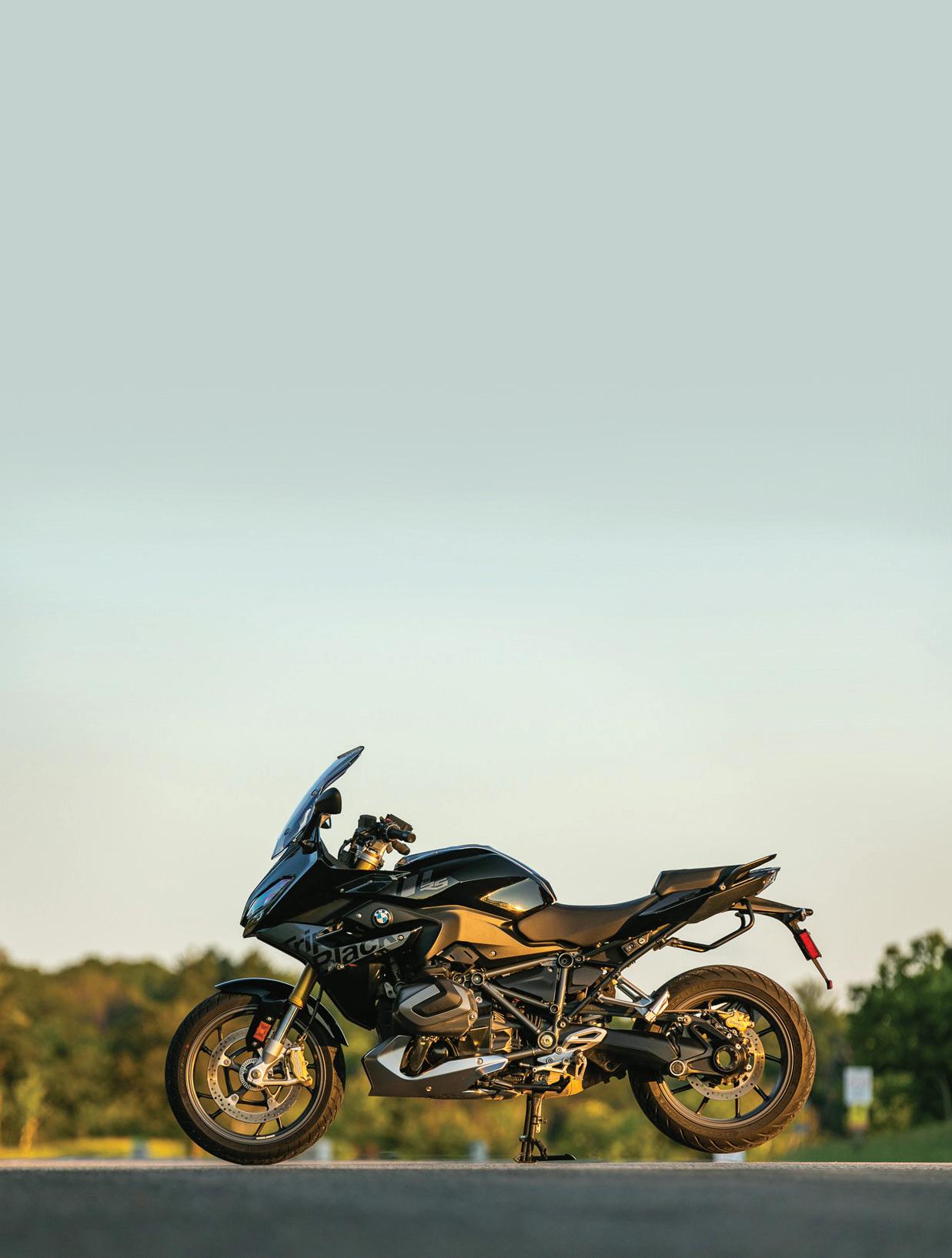
Cover Design: Dawn McClintock




Opinions
Inside Line | Patrick Lambie
On The Pipe | Mark Dzikowski
To The Limit | Brett McCormick
The Sharp Edge | Toni Sharpless 52 Frankly Speaking | Frank Wood 54 Road Race Reality | Colin Fraser
Impressions
Devil In Disguise 2023 Ducati Diavel V4
Top Shelf Sport Tourer 2023 BMW R 1250 RS
The New Middleweight Challenger 2023 Suzuki GSX-8S
Tech
Long Distance Touring Prepping for the road
Features 38 Canadian Motorcycle Hall of Fame The Class of 2023 42 Inside Touring Riding Vancouver Island 48 New Kid On The Block Jordan Decarie
Competition 58 Competition News News from the motorcycle racing world 68 Rapid Classics Suzuki’s GP game changer: the RG500 square four Also INSIDE 6 IM Zoom 10 Inside News 14 Inside Products 66 MotoGuide
TABLE OF CONTENTS INSIDE
8
16
18
19
INSIDE
20
26
32
INSIDE
56
INSIDE
INSIDE
Visit us online: Twitter Facebook Instagram www.insidemotorcycles.com @inside_motorcyc facebook.com/ InsideMotorcycles inside_motorcycles _magazine September/October 2023 Volume 26 Issue 03 InsideMotorcycles.com 3
Photos by Ben Quinn
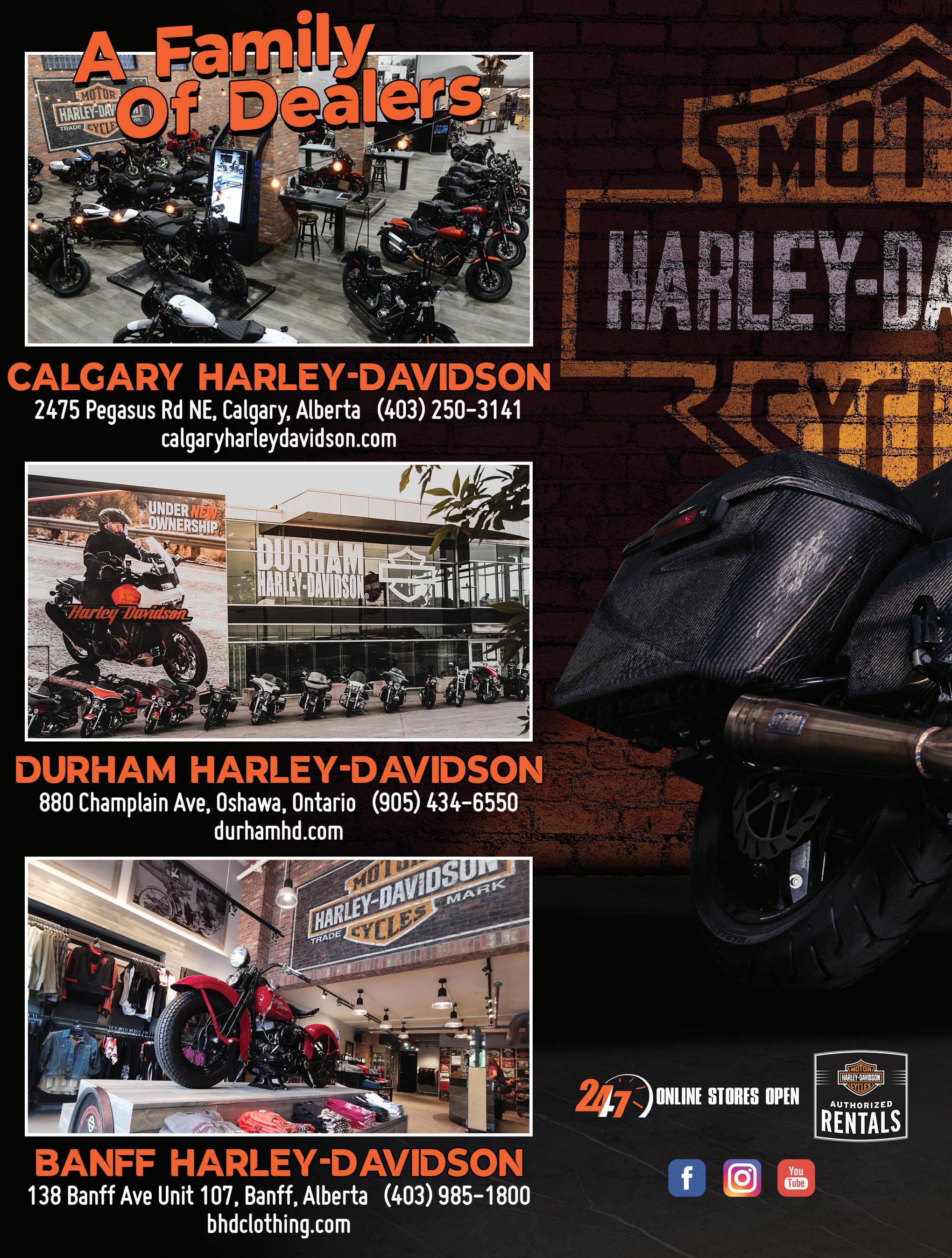

ZOOM
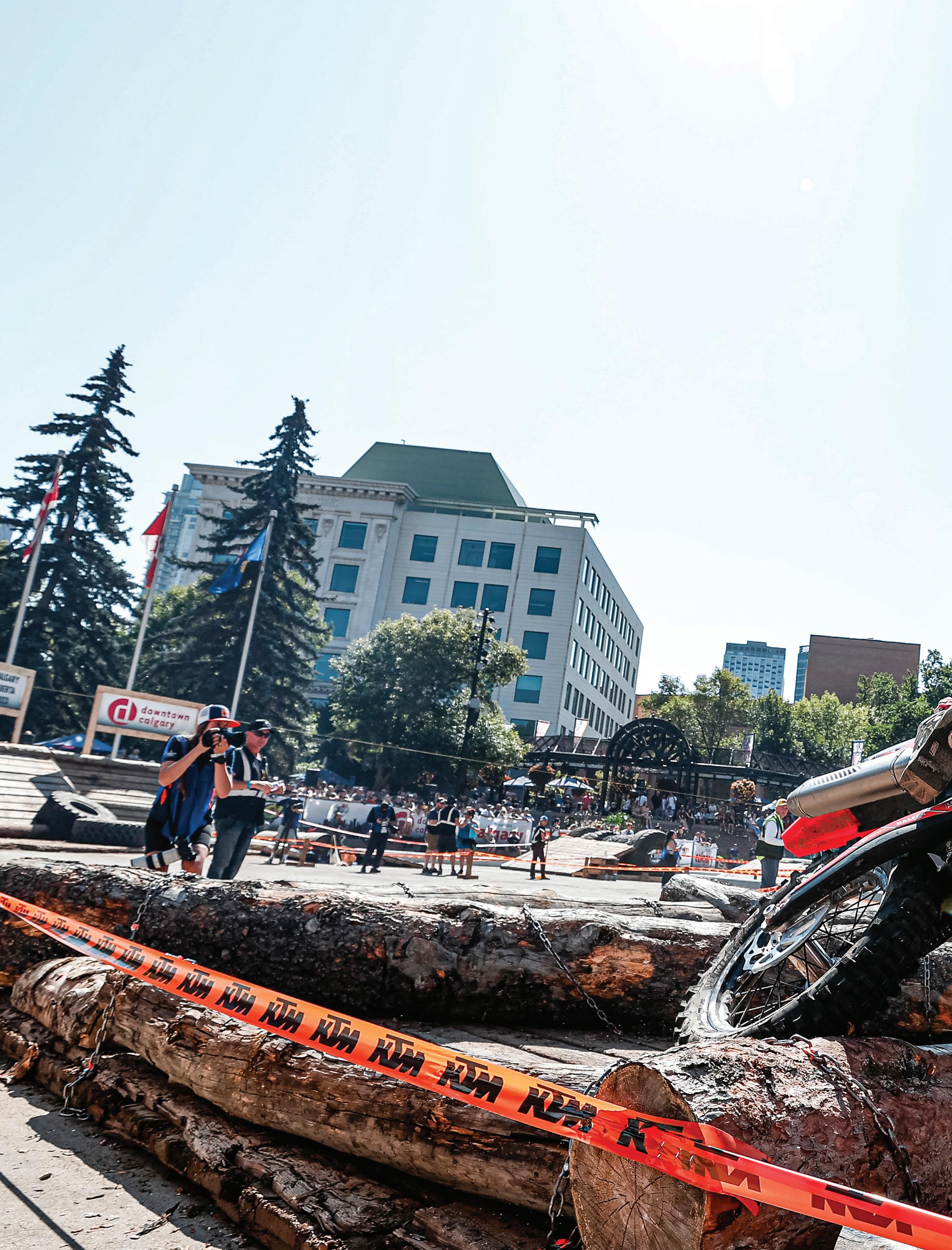
6 Inside Motorcycles
BIG CITY MOTO
Downtown Calgary was once again transformed when Red Bull brought the fourth round of the FIM Hard Enduro World Championship to Canada this August. With gleaming office towers providing a backdrop of glass and steel, local amateurs along with the best professional enduro racers in the world took on the custom track to determine staging for the following day’s main event in the Alberta Badlands. Complete results from the 2023 Red Bull Outliers can be found on page 60.

InsideMotorcycles.com 7
PHOTO: RED BULL CONTENT POOL..
BY PATRICK LAMBIE
It takes a village
While each of us has our own group of friends we ride with, or local shops we frequent for parts and service, the reality is that the Canadian motorcycle community is a large and sometimes complicated collection of individuals, companies and organizations, each with different abilities to enhance and strengthen our passion for life on two wheels.
With a desire to record and celebrate these types of contributions, Bar and Hedy Hodgson created the Canadian Motorcycle Hall of Fame in 2006. By recognizing the individuals and organizations who have made significant contributions within the industry and helped build the competitive spirit and culture of motorcycling, the Hall of Fame represents the history of motorcycling in Canada. If you haven’t taken the time to explore the Hall of Fame online at www. cmhof.ca, I encourage you do so. You can also learn about the Hall’s latest inductees starting on Page 38 of this issue.
It would be impossible to talk about the Hall of Fame without mentioning the Sharpless family. Amongst his many accomplishments, Bill Sharpless (class of 2009) encouraged, taught and supported far too many motorcyclists to count, but his three favourite proteges would have to be his children: Blair (class of 2006), Todd and Toni (class of 2011).
After decades of representing Canada in national and international competitions, working as a journalist and inspiring multiple generations of riders, Toni’s passion remains as strong as ever. During the last two years, Toni dedicated herself to the creation of a program focused on returning Canadian road racing to the global stage, culminating with this season’s inaugural FIM MiniGP Canada championship. Her efforts will see the 2023 champion, ten-year-old Michael Galvis and runner-up Ben Hardwick, represent Canada at the FIM MiniGP World Final this November in Valencia, Spain.
You can read all about the FIM MiniGP Canada season and more in the expanded version of Inside Competition starting on page 58.
Of course, creating the next generation requires more than developing new racers. It also requires those who create and organize the rides, rallies, bike shows and events, as well as those who advocate for the safety and awareness of motorcyclists. While he may be best known as the driving force behind Canada’s national Superbike series, IM’s Colin Fraser – who will be inducted into the Hall of Fame this year – has also utilized his career as a journalist to help build and strengthen Canada’s motorcycle community. While it was recently announced that Colin has sold his Professional Motorsports Productions company to new CSBK boss Ross Millson, the good news is that Colin will remain involved with the CSBK and continue to play a role in the future of motorcycling in Canada.
Reflecting on the legacy of people like Toni and Colin, it becomes hard to imagine what motorcycling would be without them. Hopefully it also inspires each of us to do our part. No matter the size of your riding community, we all have opportunities to contribute to its future. When your turn arrives, please accept the challenge. It could be the best thing you ever do. IM
Inside Track Communications, Inc.
PO Box 370, Brights Grove, ON N0N 1C0 (Administration) 78 Airdrie Road, East York, ON M4G 1M2 (Editorial) 416-962-RACE (7223) • Fax: 416-962-7208 • www.insidemotorcycles.com
EDITOR
Patrick Lambie patrick@insidemotorcycles.com
SENIOR EDITORS
Colin Fraser colin@csbk.ca
Toni Sharpless tojam39@gmail.com
Jason Thorpe jason@insidemotorcycles.com
Andrew Trevitt andrew.trevitt@gmail.com
Frank Wood motor.mouth2131@gmail.com
David Weber david@insidemotorcycles.com
Lindsey Broad lindsey@insidemotorcycles.com
PRODUCTION MANAGER
James Neilson james@insidetracknews.com
OFFICE ADMINISTRATION
Isabel Weber isabel@insidemotorcycles.com
Ethan Weber admin@insidemotorcycles.com
CUSTOMER SERVICE/ SUBSCRIPTION INQUIRIES

Lindsey Broad lindsey@insidemotorcycles.com
SUBSCRIPTION INQUIRIES subscriptions@insidemotorcycles.com
GENERAL MANAGER
David Weber david@insidemotorcycles.com
TECHNICAL EDITOR

John Sharrard acceltech@sympatico.ca
OFF-ROAD EDITOR
Mark Dzikowski mark.dzik.moto@gmail.com
COPY EDITORS
Andrew Trevitt Elisa Ward
SENIOR PHOTOGRAPHERS
Ed Gatner, Ben Quinn, Tim McGill
Mike Galipeau mike@insidemotorcycles.com
DESIGN & PRODUCTION
Dawn McClintock
Lindsey Broad
SUBSCRIPTION RATES (CANADA)
1 Year (8 issues): $24.99
2 Years (16 issues): $39.99
WHERE TO FIND INSIDE MOTORCYCLES
You can find us at finer news outlets like: Chapters-Indigo Shoppers Drug Mart

Walmart Loblaws
Alternatively, you can pick up a copy at your favourite motorcycle retailer or insidemotorcycles.com.
Inside Motorcycles is published 8 times a year by Inside Track Communications, Inc.
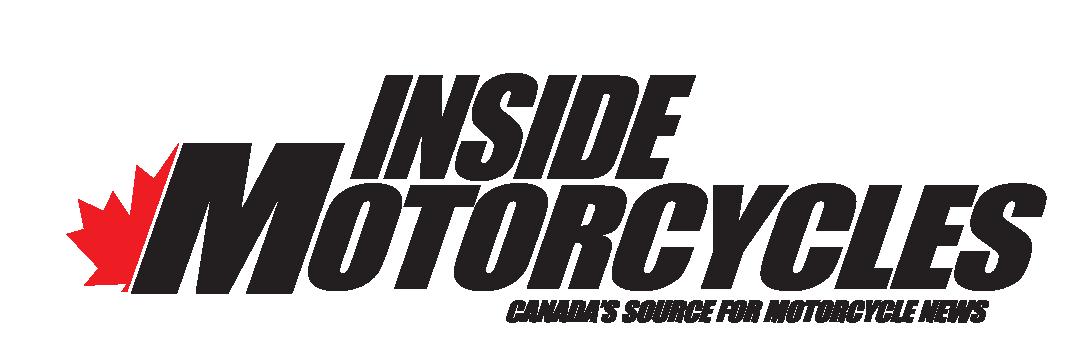
PRESIDENT: Greg MacPherson greg@insidemotorcycles.com
SECRETARY: Mike Galipeau mike@insidemotorcycles.com
CONTRIBUTORS
Graham Clayton, Lee Martin, Dawn McClintock, Brett McCormick, Suzanne Pelletier, Bruce Thomas, Shelby Turner, Todd Vallee.
PHOTOGRAPHERS
Graham Clayton, Richard Coburn, Don Empey, Shelley Gamm, Les Kalman, Rob MacLennan, Tim McGill, John Meaney, Bill Murphy, Outlaw Productions, Paolo Pedicelli, Karolina Pelc, Bill Petro, Bob Szoke, John R. Walker.
MAIL PREFERENCES We may make our mailing list available to other carefully screened organizations. The material sent to you is reviewed by us before our mailing list is released to ensure the company is reputable and their materials are appropriate. If you would prefer NOT to share your information, write to Privacy, c/o Inside Track Communications, PO Box 370, Brights Grove, ON N0N 1C0 or email: privacy@insidemotorcycles.com.
COPYRIGHT
All rights reserved. Reproduction in whole or in part of this publication without prior written permission of Inside Track Communications Inc. is strictly prohibited.
VICE PRESIDENT & TREASURER: David Weber david@insidemotorcycles.com

FOUNDING PARTNER: Rob Morton
EDITORIAL CONTRIBUTIONS
Editorial contributions should be preceded by a query letter. Inside Track Communications Inc. assumes no responsibility for loss or damage to materials. Letters are considered “for publication,” unless otherwise indicated, and may be condensed.
DISCLAIMER
All content within this magazine is provided for general information, educational and resource purposes only. Inside Motorcycles is not responsible or liable for any action that a reader takes in connection with the demonstrated exercises, instructions and riding advice provided in this magazine. Please note that certain activities described in this magazine may be dangerous, especially if proper safety equipment and clothing is not used.
RIDE SAFE
All riders pictured and contributing to Inside Motorcycles are trained riders, riding in safe conditions. Please take care in riding and wear all safety equipment.
RETURN UNDELIVERABLE CANADIAN MAIL TO: PO Box 370, Brights Grove, ON N0N 1C0
ISSN 1480-0187
Publications Mail Agreement #40023793
INSIDE LINE
8 Inside Motorcycles
PUBLISHER
CIRCULATION/OFFICE ART/PRODUCTION SALES/MARKETING EDIT
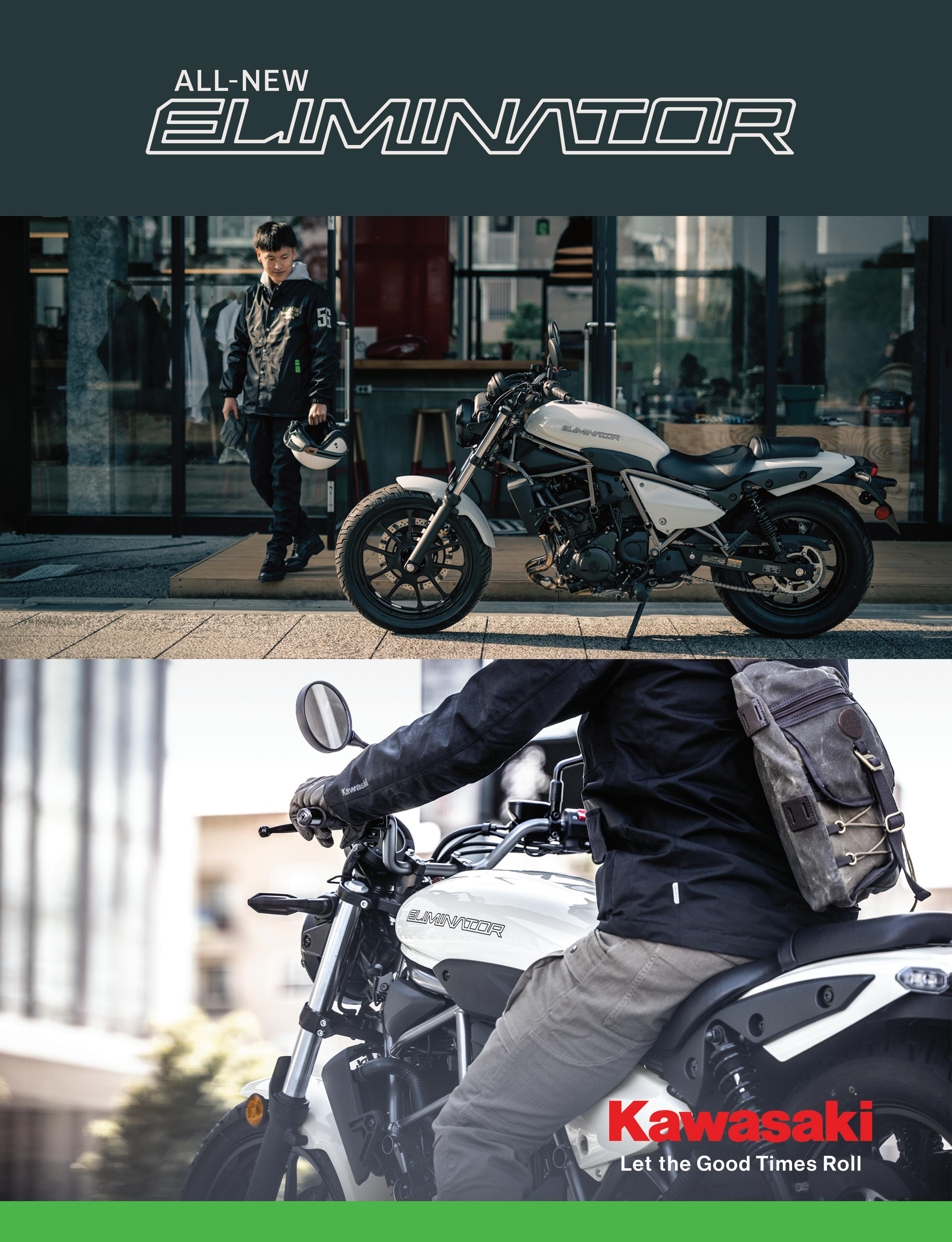

GasGas Goes Big for 2024
With a full 16-bike lineup including two dual sport motorcycles, GasGas comes into 2024 with its largest offering to date.
On the motocross front, GasGas provides options for every level of riding with 125 cc and 250 cc two-stroke models as well as 250 cc, 350 cc and 450 cc four-strokers. For 2024 the two-stroke models gain electric start allowing them to keep up with their four-stroke counterparts and all of the motocross models receive new engines mounted inside of new frames.

New bodywork throughout the GasGas Enduro lineup confirms membership in the 2024 lineup and also incorporates increased contact areas providing riders with better grip. In addition to the all-new competition-ready EC 450F, GasGas has also unveiled two street legal dual sport machines for 2024 with the ES 350 and ES 500.
Cross country enthusiasts aren’t forgotten in the 2024 GasGas lineup either with each of the five models receiving complete upgrades. Of the changes for 2024, one of the most noticeable is the move to the all-new WP Xact closed cartridge spring fork providing improved performance across the entire 2024 cross country lineup.
The 2024 GasGas motocross and cross country models are available on showroom floors now with the enduro and dual sport models anticipated to be available in October.
Visit www.gasgas.com/en-ca for complete information of the entire 2024 GasGas lineup. IM
Ownership Change at CSBK
After more than four decades of involvement with Superbike racing in Canada since its Mosport debut in 1978 and over 27 years operating the series, Inside Motorcycles columnist and 2023 Canadian Motorcycle Hall of Fame inductee Colin Fraser has made the decision that the time is right to hand over the reigns of his Professional Motorsports Productions to new ownership.

Founded in 1994 by Fraser and David Hatch, Professional Motorsports Productions started out producing television coverage of the Canadian National Superbike Series and two years later was asked to take over all operations of the national superbike tour. Now, 27 years later, former Pro racer Ross Millson has assumed ownership of Professional Motorsports Productions and the operations of the Bridgestone CSBK series.
For Fraser, who will remain involved as an executive producer with the CSBK national championship tour, the decision to sell revolved around finding the right individual to continue and grow the series: “It is important to me that the history and legacy of the 43 years of the CSBK tour is recognized, supported and ongoing, and Ross is the right person for that challenge.”
For Millson, who started working as part of the CSBK team in 2015, the task ahead will be both challenging and rewarding. “I have known Colin Fraser since I started road racing at Shannonville Motorsport Park more than 20 years ago and appreciate the efforts he and his team have made to keep the series alive, especially during recent COVID events. We aim to take things to the next level, with the help of our competitors, stakeholders and dedicated staff.”
The 2023 Bridgestone CSBK season will conclude on September 17 at Shannonville Motorsport Park. Visit www.csbk.ca for the latest CSBK news and information including race results and championship standings. IM
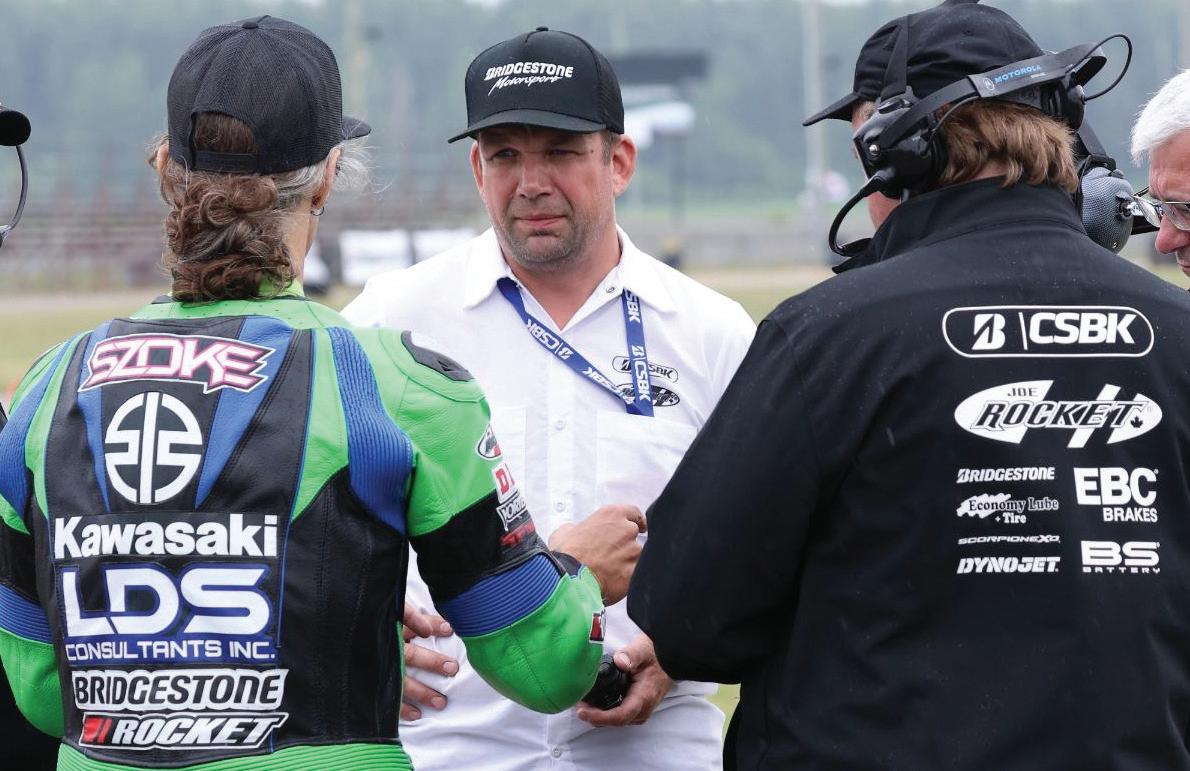
10 Inside Motorcycles
The street legal GasGas ES 350. PHOTO COURTESY GASGAS CANADA.
Ross Millson (centre) speaking with 14-time CSBK champion Jordan Szoke (left) and tech official Fred Benjamin (right) at Grand Bend Motorplex. PHOTO: ROB O’BRIEN / CSBK.
BMW Motorrad Expands Electric Lineup
Following on the introduction of its all-electric CE 04 scooter in 2022, BMW Motorrad is introducing its latest electric-powered motorcycle with the CE 02. Defined by the company as an eParkourer, BMW is targetting a young urban based market with this allnew model.
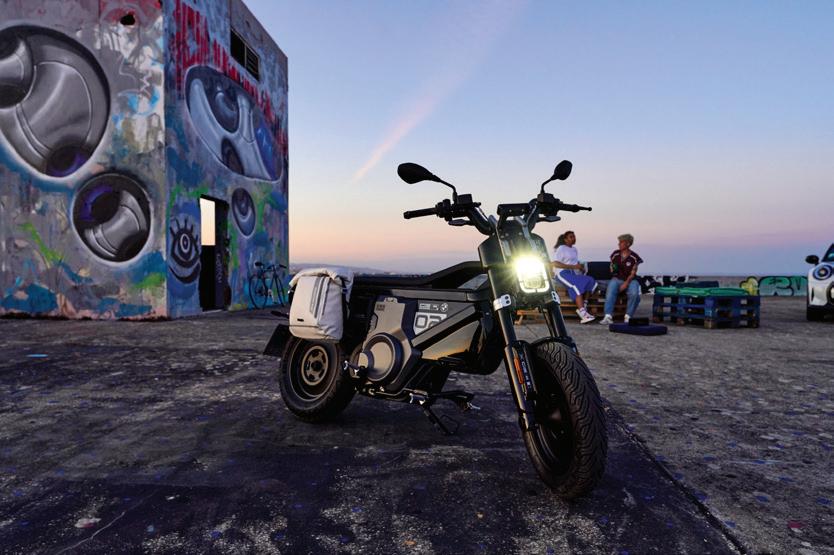
Featuring a manageable 29.5 inch seat height and 120 kg weight as well as standard ABS, reversing aid and the capacity for two-up riding, the CE 02 will appeal to riders focused on inner city commuting. At the same time the 15 horsepower and 40.6 ft-lb of torque produced by the air-cooled synchronous electric motor accommodate the top end speed of 95 km/h required for occasional forays out of the city.
The CE 02 includes a wide array of technology with keyless ride, LED lighting, a 3.5-inch TFT display, selectable ride modes and smartphone connectivity. Claimed recharge time is 2 hours 40 minutes from 0 to 100 percent and 90 minutes when charging from 20 to 80 percent.
The CE 02 is listed on the BMW Motorrad Canadian website with an MSRP starting at $10,095. Visit www.bmw-motorrad.ca for more information. IM
Can-Am 2024 Lineup
In the midst of celebrating its 50th anniversary, Can-Am has unveiled the lineup of vehicles that will form the company’s on-road lineup for 2024. With a focus on technology and what the company references as a “more immersive riding experience,” each of the three-wheeled Spyder models will receive a major upgrade in the form of a 10.25-inch colour touchscreen and the inclusion of Apple CarPlay as standard equipment.
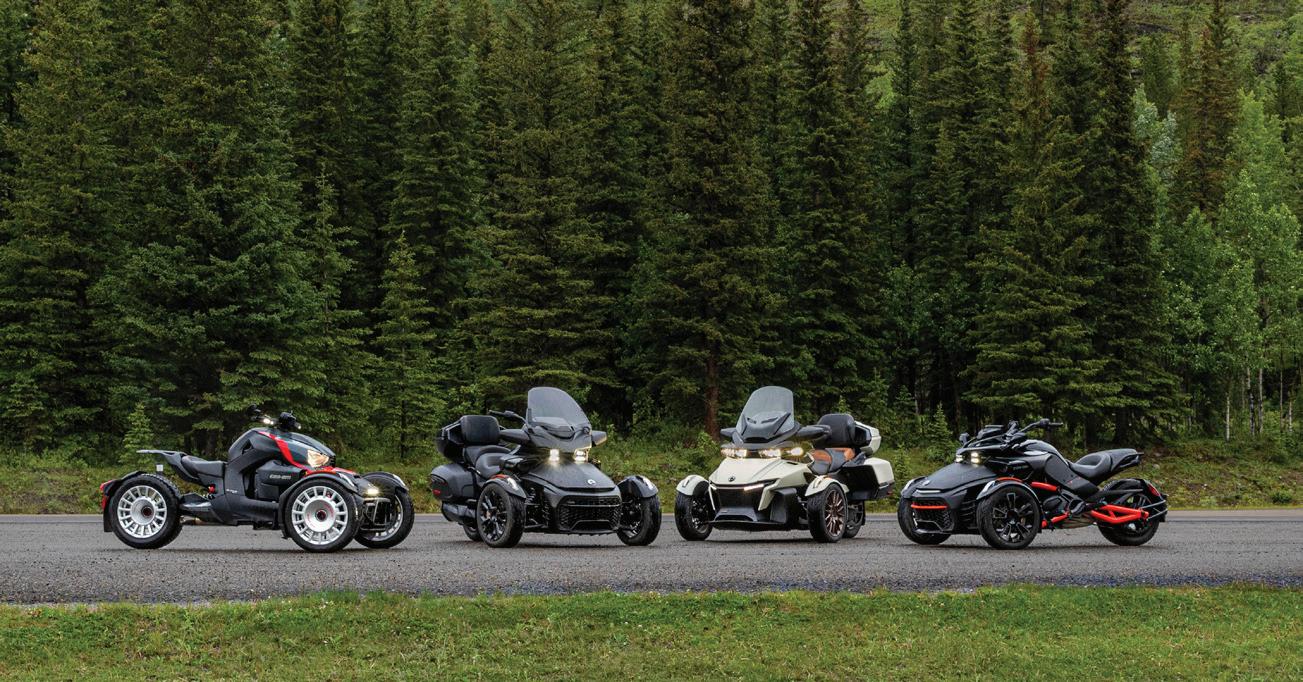

Additional upgrades for 2024 include updated LED headlights on all of the Spyder F3 models as well as a new super sport grill on the F3-T and F3 Limited models. A variety of new colourways are being introduced along with the 2024 lineup including an all-new Vegas White Satin paint scheme on the company’s flagship Spyder RT Sea-to-Sky model.
Visit can-am.brp.com/on-road/ca to learn about the complete Spyder and Ryker lineups for 2024. IM

InsideMotorcycles.com 11
The all-electric 2024 BMW Motorrad CE 02.
PHOTO COURTESY OF BMW PRESSCLUB CANADA..
Can-Am’s 2024 on-road lineup on display.
PHOTO COURTESY OF CAN-AM/BRP.
Yamaha Tracer 9 GT+
The Yamaha sport touring range receives a boost in technology for 2024 with the introduction of the Tracer 9 GT+.

Featuring radar-linked adaptive cruise control, riders will now benefit from the additional safety as the system, when activated, controls acceleration, deceleration and cruising speed to maintain a pre-set distance away from vehicles directly in front of the motorcycle. The Tracer 9 GT+ will also use the radar information to support the new unified braking system which assists rider braking when the motorcycle closes in too close to an obstruction in front.
Additional technology on the Tracer 9 GT+ is found in the latest KYB Actimatic Damper System which supports the semi-active suspension system. The electronic suspension setup also works in conjunction with the adaptive cruise control and unified braking systems.
The Tracer GT 9+ also incorporates the latest generation of Yamaha’s quick shifter, accommodating clutchless up and down shifts. The quick shifter is also integrated with the adaptive cruise control allowing gear changes to be made while the cruise control remains engaged.
A new seven-inch full-colour TFT display features three different screen layouts and supports the free Yamaha Y-Connect app which allows rider to access a variety of functions from their smartphone. Additionally, the Garmin Motorize app will allow riders to access and display full-screen turn-by-turn navigation on the TFT display.
Canadian MSRP for the 2024 Tracer 9 GT+ is $20,699. Full details are online at www.yamaha-motor.ca IM
Points of View
Dear Mr. Lambie,
In the most recent edition of your magazine, there is a test of the CFMoto 700. Regardless of the merits of the machine, a bike made in China should not appear in your publication. Canada and China have very different interests. The Chinese government shows little or no interest in conforming to international norms. As a result, I see no value in buying Chinese made goods. In Canada, I am free to express this opinion. Elsewhere, this basic right is not honoured.
Sincerely, Peter Rochus
Hello Peter, thanks for taking the time to write. We absolutely appreciate and welcome your right to express your opinion. At Inside Motorcycles our goal is to provide the latest motorcycle-related content to our readers, and allow them the freedom to choose for themselves which products and companies to support. Ed. IM


In the fall of 2013, KTM was making waves with the Austrian manufacturer intent on taking a larger piece of the burgeoning adventure touring market with their allnew 1190 Adventure. Anxious to take on fellow European manufacturers Ducati and BMW, the 1190’s larger displacement engine compared to the company’s previous 990 Adventure and a more road friendly design marked KTM’s move into a segment that remains equally hot ten years later.
The same issue saw the IM team take the latest version of the Can-Am Spyder out for a ride. While other companies were fighting for market share, Can-Am’s introduction of the Spyder six years earlier in 2007, was an example of thinking outside the box to create a new market. With Can-Am’s intention to combine a return to manufacturing motorcycles with electric motor technology, it appears they aren’t planning on slowing down.
A profile of Finn Motorsports in the October 2013 issue of Inside Motorcycles provided insight into not only the world of mini road racing but also the realities of life in a military family. As 10-year-old Jonathan Finn and his younger brother Matthew were gearing up to contest the 2012 season, their father Shawn was preparing for a one-year deployment to Afghanistan. In a true testament to the power of family and the community of racing, Finn Motorsports went on to enjoy their best season yet in 2012.
Fast forward to 2023 and the same enthusiasm and focus that built Jonathan’s road racing career is evident as the now 20-yearold Jonathan has moved onto competing in the FIM Bajas World Cup series where he is currently in fifth place in the overall points standings. IM
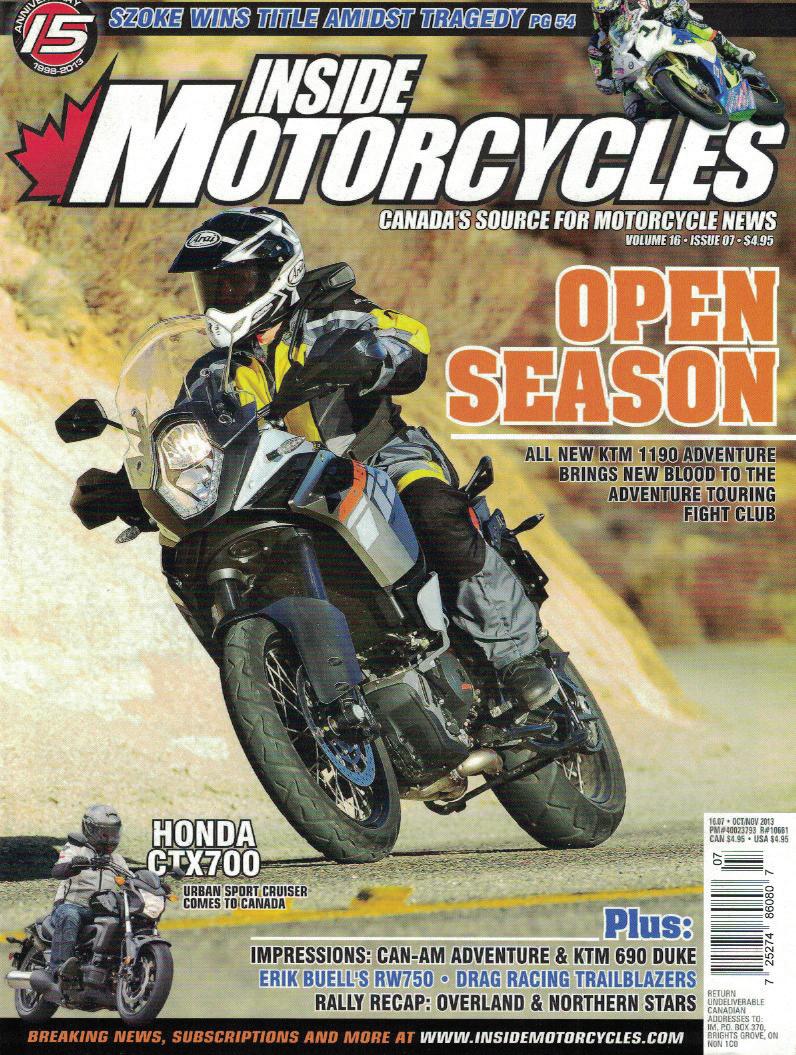
12 Inside Motorcycles
PHOTO COURTESY OF YAMAHA MOTOR CANADA.
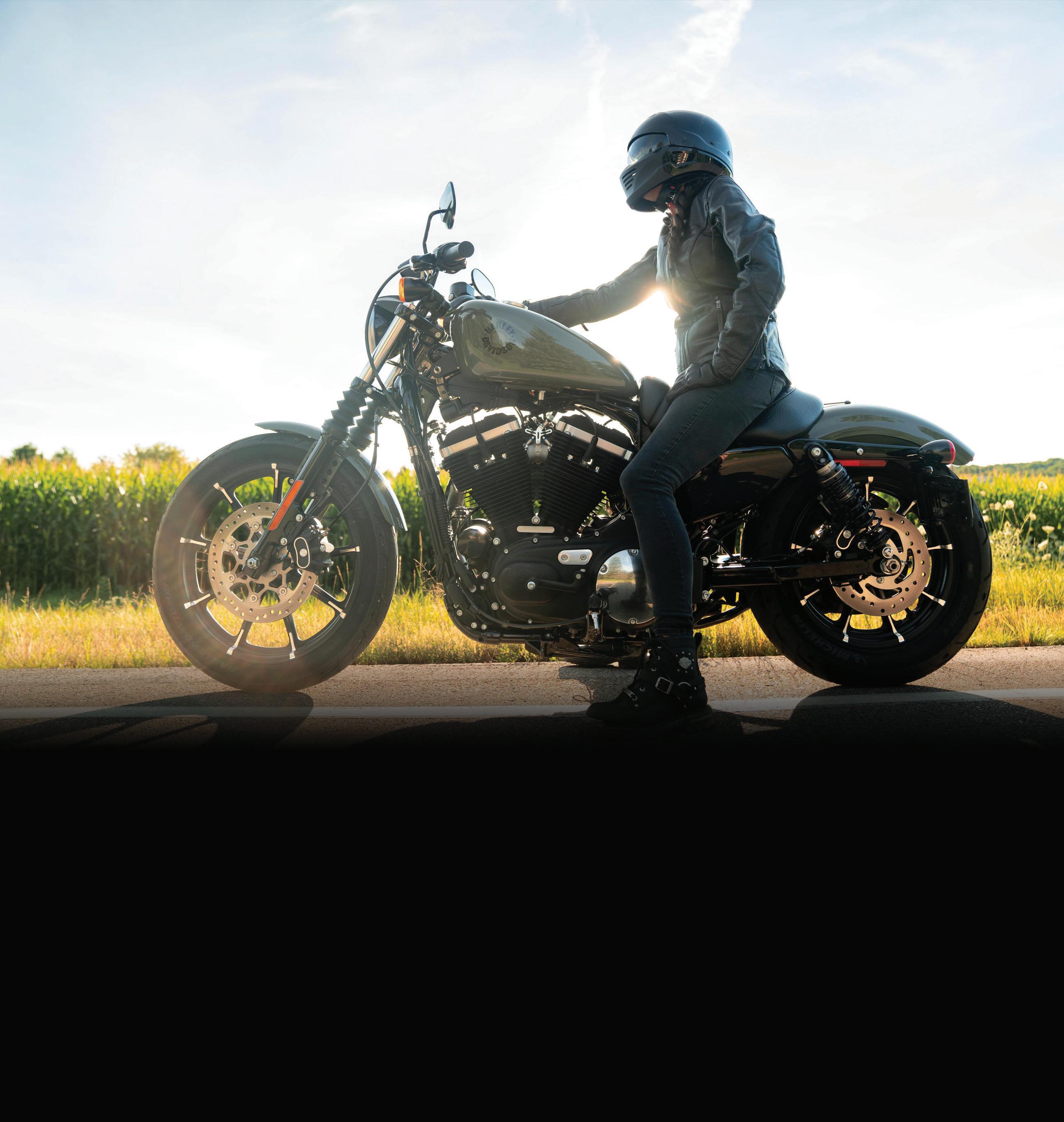
HARLEY-DAVIDSO N ®
Leatt Hydration Moto HydraDri WP 2.0
By Mark Dzikowski
I have been testing the Leatt HydraDri WP 2.0 hydration pack for about a year now, and after almost two riding seasons of use, I am impressed with this offering from the South African manufacturer. I have been a fan of the “belt-less” harness design hydration packs since I got my first USWE pack in Europe in 2012, thus I was excited to test Leatt’s offering that has a similar harness design but with a waterproof pack. Having a full seam-welded waterproof design that is paired with an insulated bladder pocket and the proven stable harness looks to be a winning formula.
While I like the USWE harness, the fully adjustable Leatt version is more comfortable for me. I find the Leatt harness to fit better over my chest protector and not rub against my neck when riding standing up. With the shoulder straps being made of soft mesh, I would forget I am even wearing the pack and the stability of the pack and lack of bouncing that is the signature of this design was on point.
The version tested comes with the two-litre-capacity Cleantech bladder. While early reports of the model talked about issues with the bladder, I did not have problems with it leaking or getting mouldy over time. I exclusively run pure water in my bladders as I found that no matter how “mould-resistant” bladder designs are, any product containing sugar is an enemy to having a crispy fresh bladder. The bite valve worked great until I ripped it off on a tree branch and had to replace it with an off the shelf version. There are two routing paths for the tube, one out the top and the other out the bottom.
The pack comes with five litres of storage as well and well-thought-out pocket locations. The pockets on the front portion of the harness are great for quick energy snacks and a phone pocket. I found the phone pocket a bit small as it doesn’t fit my iPhone. With Leatt being synonymous with safety, it’s no surprise that the pack is Level 1 CE protection certified and comes with a safety whistle in the front harness pocket. Pretty cool.
After my test period, this hydration pack is now a goto part of my kit for enduro and adventure riding. The Hydration Moto HydraDri WP 2.0 retails for $279.99 and further details can be found by visiting www.kimpex.ca.
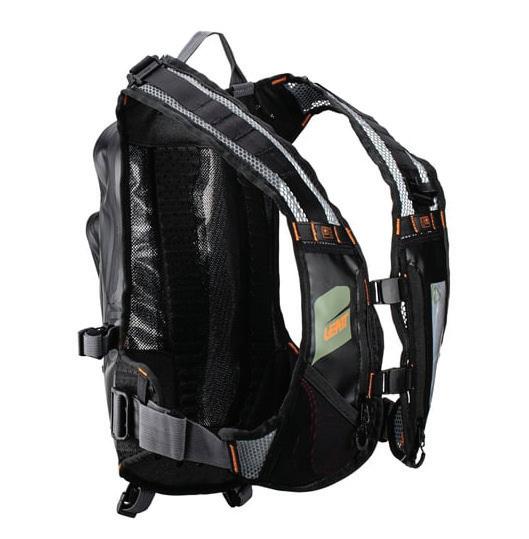
TCX Infinity 3 Mid WP Boots
Pros
– Comfortable harness
– Built-in safety features
Cons
– Small phone pocket
– Relatively expensive
By Patrick Lambie
In the interest of full disclosure, I have to acknowledge that I am a long-standing fan of boots from TCX having enjoyed the company’s products on the racetrack and street. When the opportunity to test TCX’s Infinity 3 Mid boots coincided with a planned dual sport trip, it was too good to pass up.
Out of the box, the boots are of sturdy construction with a combination of engineered fabrics and leather, with additional protection in the toe and heel areas as well as a Groundtrax sole that features an aggressive tread pattern. Capturing attention is the external lace running along the outside of each foot up to the ankle and the dial that secures and tightens it.
Slipping into the boots is straightforward as a 90-degree counter-clockwise turn of the dial releases the lace and the Velcro-secured top panel opens to provide easy access. Fit proved to be accurate, directly matching my regular boot and shoe size. Thanks to the dial system which secures the outer lace, the boot adjusts perfectly to each individual’s foot shape.
As denoted by the “Mid” portion of the product name, the boot covers approximately 6 to 7 inches of your leg with the top closure panel providing extra protection to the shin area. While aggressive off-road rides would benefit from fuller shin and calf protection, the Mid design is more than sufficient for occasional off-road adventures.

Out on the road, the Infinity felt very comfortable, although the T-Dry waterproof membrane that gives rise to “WP” in the boot’s name, limits air flow, which resulted in sweaty feet during this summer’s unusually hot days. On the flip side, the membrane kept my feet perfectly dry when riding through a major thunderstorm. These same wet conditions also verified the topshelf slip resistance of the sole. As an added bonus, the sole provided a lift of about an inch which is always welcome by the vertically challenged on tall adventure style bikes.
All of this quality does come at a price and in the case of the TCX Infinity 3 Mid WP boots, the MSRP of $499.95 may be a hard pill to swallow for some. However, if you are in search of a quality footwear option that will keep you safe and dry when riding off-road with the ability to pull double duty on the street, these boots come highly recommended. Visit www.motovan.com for further details and the complete lineup of TCX products.
Pros
– Solid construction
Cons
– Waterproof membrane limits ventilation
– Lace system ensures perfect fit
14 Inside Motorcycles
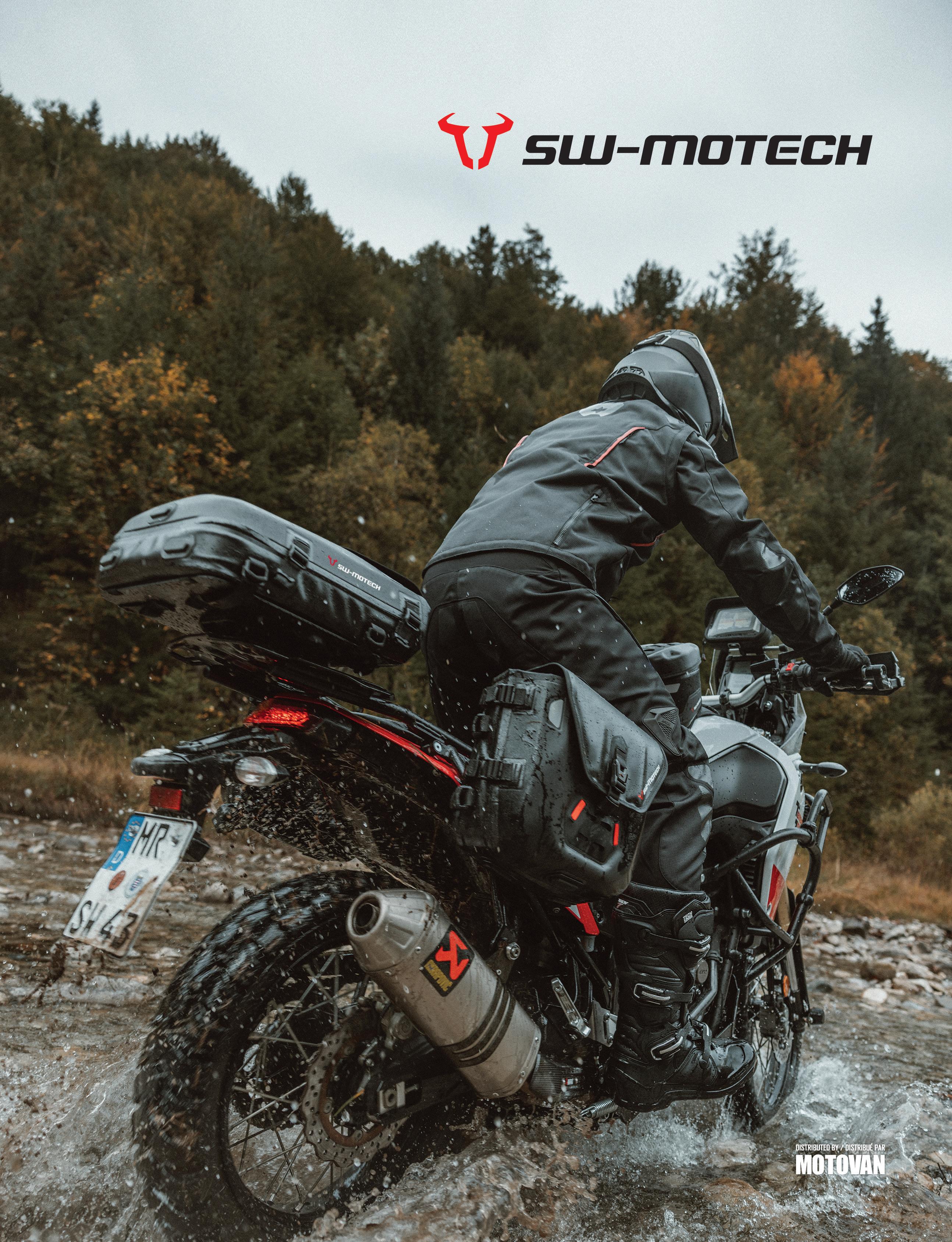
Remembering a local off-road legend
When our time finally comes to leave this planet, how do you know if you are going to leave an impact on your family, friends, work associates and people you cross paths with, and how will you be remembered? I know, it’s a morbid thought, but living a good life and trying to leave a positive wave in my wake as I go through life is one of my fundamental goals. I don’t always succeed, but I try. This deep philosophical dilemma has been crossing my mind more recently than before. This could be due to me getting older, but I also think it’s because I’ve been impacted by the recent passing of an Alberta off-road legend, David French.
David has been synonymous with Alberta’s off-road scene for decades. From sponsoring many amateur and professional riders through his powersports dealership over the years, to putting in countless hours volunteering by organizing off-road races and various events and engaging with the community near his home in Brooks and all over Alberta. How do you judge the reach of Dave’s involvement in our sport? It’s not easy, but here is an example I recently

encountered.

While on an extended magazine test of an adventure bike a few months ago, my friend and I stopped in Coleman in Crowsnest Pass, AB, at a coffee shop to avoid some rain and replenish our depleted energy reserves. A 15- or 16-year-old kid working the floor approached us and asked if we were enjoying our ride in the area. The conversation grew into off-road racing, and the kid was proud to proclaim that he races in the Junior category in local hare scrambles and cross-country races. We started talking about old races in the 2000s that my friend and I used to race, and the kid replied, “Oh yeah, I heard all about those races. John Bader and Dave French classics!” Here is a kid who wasn’t even born when the said races were happening but who is keenly aware of the legends that put them on. It is from him that I learned that Dave once again wasn’t doing well and was in the hospital. I vowed to send a get-well text message to Dave when I got back from that trip, but I forgot. The next news I heard two weeks later was that Dave had passed away, and I never got the chance to send that text.
I didn’t know Dave very well. We first crossed paths around 2010 when I started getting more into enduro racing, and he, at the time, was the Husaberg dealer in southern Alberta. Since I was racing a Husaberg at the time, I started to see Dave more often. Then, in 2012, while training for ISDE tire changes, I reached out to him wondering if I might buy a scrap wheel off of him to practice on. Without even batting an eye, he replied, “I got one for ya. Pop by the shop, and you can take it.” He didn’t even want to entertain the idea of me paying him for it.

Once I switched to the journalistic side of the sport, we started talking more about the race promotion end of things and how difficult it is these days to put races on with all the red tape out there. And of course, we bonded over suspension tuning. Once Dave sold his powersports dealership a few years ago, he still retained his suspension tuning business that he was so passionate about. We bonded over the tricky science of the craft since I also love to dabble in suspension optimization. This led to the collaboration on the Inside Motorcycles suspension article in 2019, where he shared his tips and tricks on suspension tuning and provided a re-valve of my fork and shock for me to evaluate on my KTM 350 XCF. He didn’t want any recognition; he just wanted to talk shop and share tips free of charge. Whenever I would call and ask him a technical question about anything related to suspension or bikes in general that I bought from him, he always found time for me. That is how passionate Dave was about motorcycles, racing, customer service and powersports in general.
Even though I didn’t know Dave as well as all his close friends, his passing hit me. I regret immensely that I didn’t send that one last text of good wishes to him before he passed away. But his passing strengthened my belief to always strive to be better and try to leave a more positive impact in my wake. While thinking of his family, rest in peace David. You will be missed. IM

ON THE PIPE MARK DZIKOWSKI
16 Inside Motorcycles
Dave French in his happy place, in the shop, tinkering on motorcycle suspension.


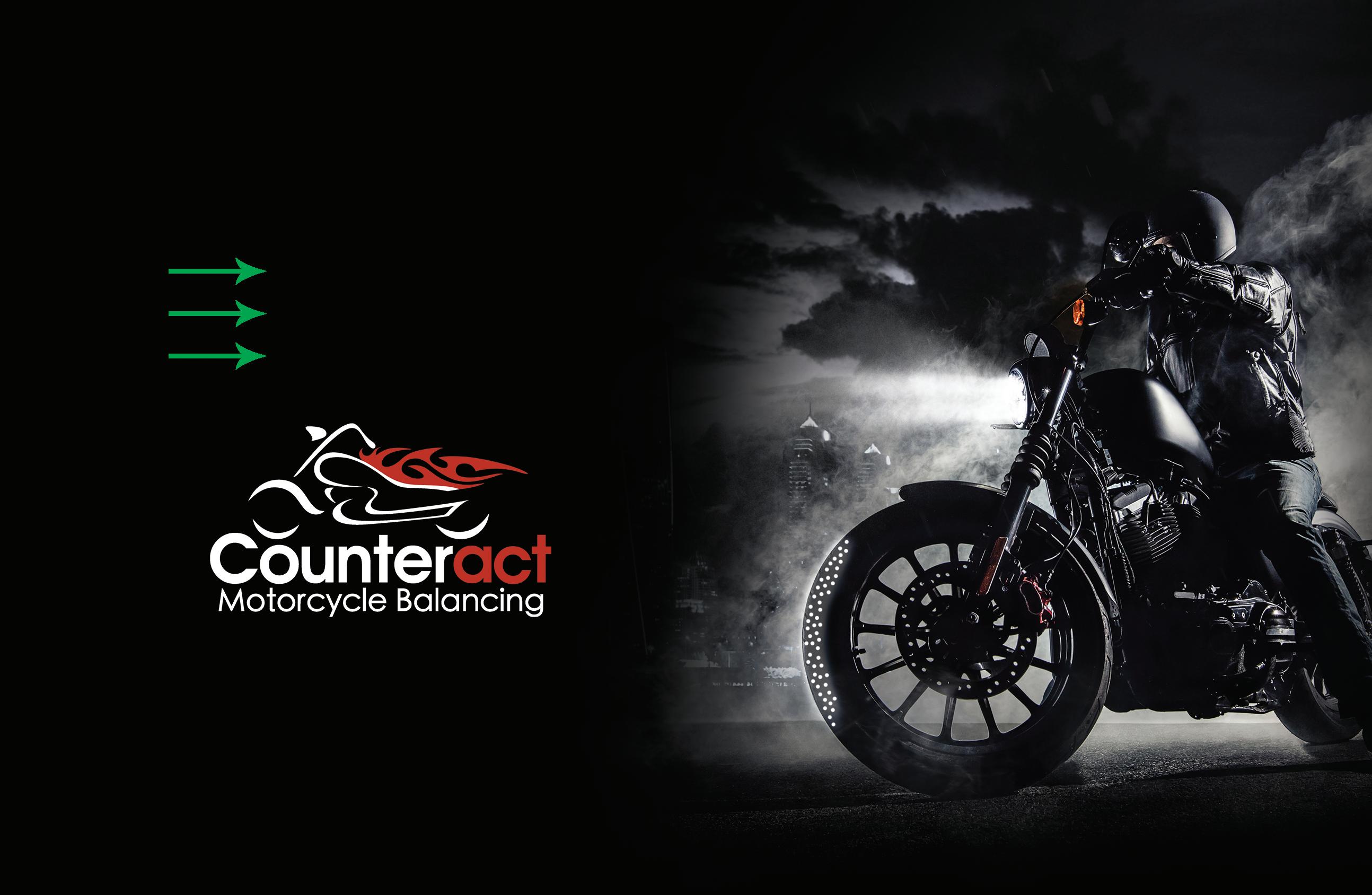

InsideMotorcycles.com 17
Mosport


Canadian Tire Motorsport Park, also remembered by many as Mosport, is an iconic track for Canadian Superbike racing. It has been the focal point of so many moments in my racing career, and I know many other racers can say the same thing. Depending how your year is progressing, it can either be a weekend to look forward to or a weekend to dread from a racing perspective – but usually a weekend enjoyed by everyone regardless, because of the massive crowds that always show up.
If you’re at the sharp end of the grid and setting the pace for the season, this can be one of the most frustrating race tracks. If, on the other hand, you’re a touch off the pace and looking for more, this track can be a blessing. A tight pack in the race using the draft up the back straight can make it impossible to get away, and really easy to stay in tow. Nightmare for the leader, and a dream come true for the guy looking for half to three quarters a second per lap. The track isn’t overly technical either, so it makes it easy to get a tow from a faster rider in front of you.
Going fast at Mosport is an incredible feeling. I’ve ridden tracks all over the world and still nothing compares to it. Every track
has a signature section, but I don’t know another track that has something special in every section like Mosport.
Turn one is a fast, blind entry downhill, having to use brake markers to remember your turn-in and throttle chop spots. A corner with some room for error, but when you get your exit perfect, heading up the hill to turn two will put a smile on your face. Turn two is scary, no other way to put it. You climb up from turn one into a completely blind entrance of turn two, and once you crest the hill your knee has to be on the ground in third gear for a two-story vertical drop left. Get to the bottom flat out in third, maybe grab fourth to climb the hill into turn three. Huge stress on your shock when you finish your descent and transition to climbing wide open on the throttle.
Turn three is a nice spot on the track to grab your breath because it isn’t a blind entry, but it’s still important to get right for your lap time. The exit of turn three might be one of the best spots in the country to slide the rear end of a Superbike, so much fun lighting the tire up in third gear and grabbing fourth to get to turn four. Another blind entry to the left hand downhill, which is the scariest part of the track, no doubt.
Many seasons have been ended in turn four, and I don’t think anyone tips in there without a serious amount of pucker. Fourth gear is close to flat out on a Superbike, you can miss your apex by some pretty big margin at those speeds. You finish turn four with another massive descent flat out in fourth gear, and it’s instantly back uphill at twice or three times the slope, braking to first or second gear. Mosport gets interesting in turn 5A and 5B, because this is the only part of the track that is “slow,” and it requires some specific suspension setup. The G forces you and your bike feel at that uphill instant are massive, and normally where you set your suspension limits for.
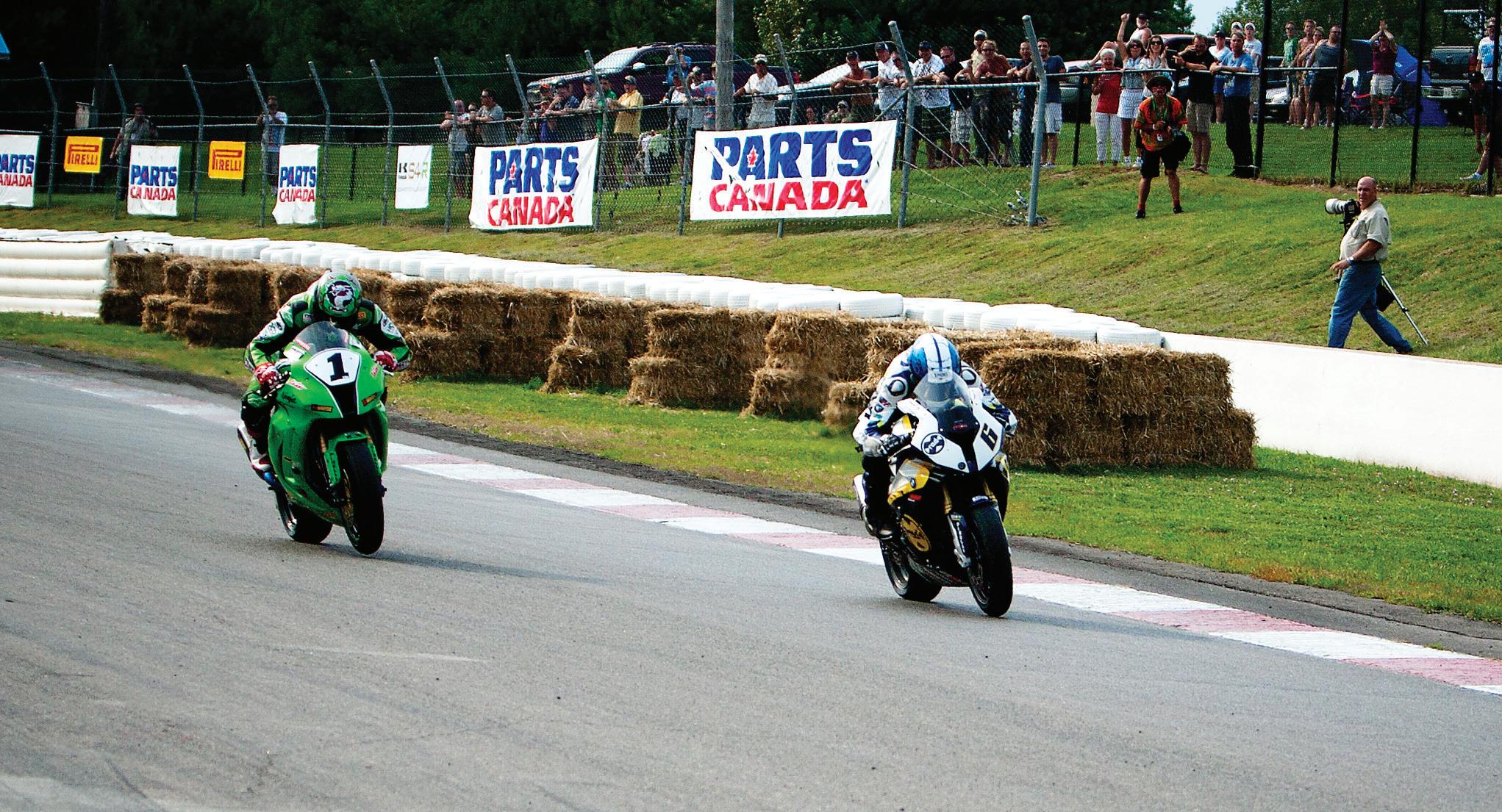
Turn five can be maddening, because it feels like a lifetime that you’re between 5A and 5B just waiting for the perfect time to get into the throttle for a drive up the massive back straight climb. This is pivotal for your lap time. All the way from first or second gear up to sixth gear, you’ll crest the hill on the back straight at around 285 km/h with either your head over the windscreen, or foot hammering the back brake to keep the front tire on the ground. Crazy. Then you dip down a little bit and crest one last rise into the braking zone.
Down to third gear for a fast right hand turn eight sweeper. Important to get right so you can execute turn nine and ten correct, then finish the lap off. They’re simple corners, but popular places to make passes in the race. Turn ten propels you back onto the front straight towards the finish, and is always an exciting section to watch on the last lap.
I’ve won championships at Mosport, and lost them just the same. I love riding Mosport, but for me, racing it all depends on what you need out of the weekend. Not a great track to be setting the pace at and trying to check out in a race, but a great track to try and stay latched onto the fast guys. One thing you can’t question, it makes for exciting racing that spectators love – and always brings a ton of them out! IM

TO THE LIMIT BRETT MCCORMICK
18 Inside Motorcycles
Turn 10 at Canadian Tire Motorsport Park, a.k.a. Mosport.
“Moments into memories” Part 2

In the previous column I wrote about my friends Mike and Michele Bell of Bellistic Films and how their videography hobby developed from taking pictures of their activities to share with their disabled brothers, Chris and Jeff, to making films capturing motorcycle moments into memories.
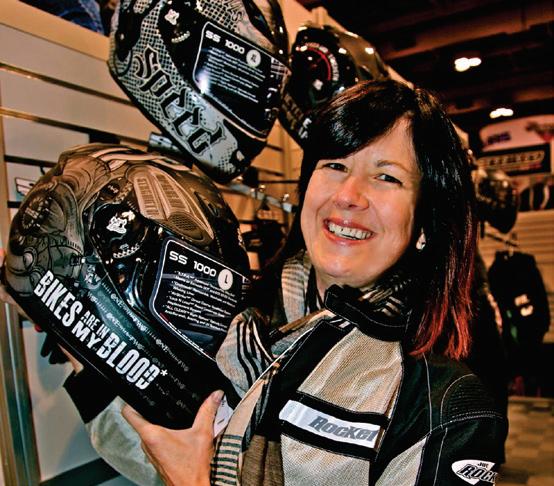
To recap, Mike and Michele (nickname MnM) are an inseparable pair since meeting in high school in 1983. There are a multitude of interesting projects and exploits on motorcycles that I could write about this couple like their motocross years or travels to the Western Continental Divide, Mexico and South America where Michele rode with broken ribs from the incident in the Andes southwest of Mendoza 2600 miles to El Calafate, Argentina where she had emergency surgery for a punctured lung. Or I could write about their car racing years beginning with kart racing then on to larger wheels racing in the Canadian Automobile Sport Club’s CASC-OR series and Targa Newfoundland series. Or I could write about the evolution of their videography and their contributions to Canadian motorcycling. I chose the latter.
If you ask MnM where they prefer to ride it’s the roads of Mexico for the ultimate weather, the authentic food, warm people and culture. If they aren’t with customers, “Our favourite is going for a ride in Mexico discovering areas, villages and people that others would never see.” Mike says. This pair doesn’t sit around by the pool, but when they do it’s usually editing film footage or planning their next project. Their Mexico project last winter was helping the natives in isolated communities easily reached by two wheels not four, who are struggling for resources like a quality water supply – a challenge from the effects of modernization around them. This is one example of an MnM vacation.
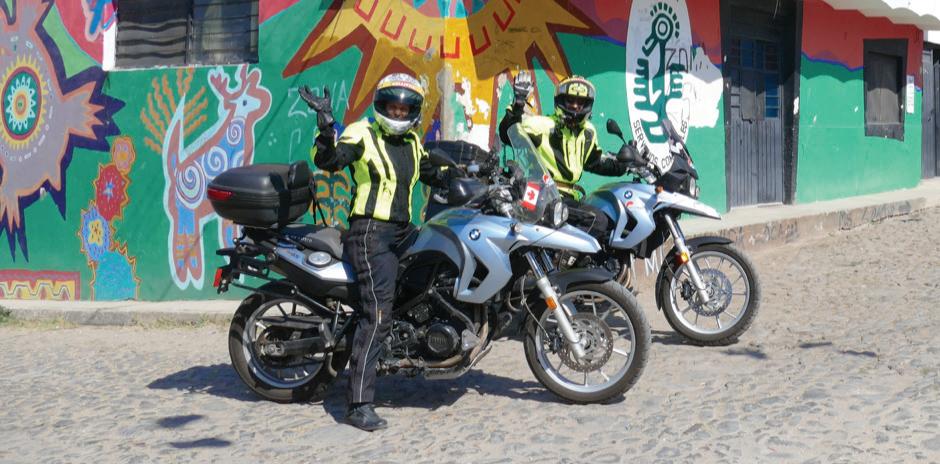
Following the development of Bellistic Films from the previous column it was in 2014 when MnM jumped in to see what they could do to promote the Corduroy Enduro
off-road event, ‘Canada’s Toughest Race.’ After a year or two Bellistic produced the first Cord Movie on the big screen at the Roxy theatre in Uxbridge during the Moto Movie Matinee event. The event was well attended, and the feedback very positive. Typically, off-road events like an enduro do not make for great spectating as the riders are hidden in the woods covering hundreds of kilometres making it impossible for a fan to follow. Somehow, Bellistic was able to capture the event and bring it to life on the big screen.
The 2022 Corduroy event is now an hour-long broadcast show on RevTV. Event organiser Blair Sharpless says, “The production value was so good from Bellistic that RevTV took it straight to air.” Blair went on to describe what MnM bring to his event: “There has not been any better coverage of an off-road event anywhere. Mike and Michele use 33 cameras to film, edit it all down to a show, with no sound editor, no film editor, no producers, no graphic artists. Mike does it all and Michele is the organizer who keeps notes for the storyline and the project on track as well as handling the social media and the website. Together, they are a big part of the team and a big part of the Corduroy.”
Doug Kent, head official of timing and

scoring for the Cord event said to Mike one year, “This work you and Michele are doing will last forever.” Mike took Doug’s comment to heart and has expanded his skills to digitizing all the old photos of the 60-yearold event to preserve its rich history. The Canadian Motorcycle Hall of Fame (CMHOF) caught wind of this and asked Bellistic to submit their work for historic keepsake.
The snowball continued in 2016 when the OCMC club asked Bellistic to help celebrate its 50th anniversary. MnM responded by making a movie, interviewing past and present club members then digitizing hundreds of photos dug up from shoeboxes. In the film they commemorate the OCMC founder, Bill Lishman, a national calibre sculptor and ‘father goose’ depicted in the film acted by Jeff Daniels called Fly Away Home, who used an ultralight plane to help migrating birds from Great Slave Lake, NWT to the state of Georgia. During that project Bill gave Bellistic a suitcase full of 8 mm footage he took from the making of the movie and MnM digitized it all. Mike says, “There are stories to be told from every shoebox and suitcase of photos. All that stuff should be made available for people to make update videos as we are losing people that have made a huge difference to motorcycling and we need to capture that.” IM
THE SHARP EDGE TONI SHARPLESS
InsideMotorcycles.com 19
“Our films are not a money venture; they are my writings on the cave wall.”

INSIDE IMPRESSION | 2023 DUCATI DIAVEL V4 20 Inside Motorcycles
DEVIL IN DISGUISE
2023 Ducati Diavel V4
BY JASON THORPE PHOTOS BY BEN QUINN
I’ve always looked askance at the Diavel. Ducati, so my thinking goes, is a manufacturer of purpose-built motorcycles – bikes that are designed to do a specific thing. Obviously, the company’s sport bikes are designed to go really fast around a track and win races. The Multistrada is a world-class sport tourer. The Monster and the Streetfighter? Well, they’re naked sport bikes with a humane riding position. You get my drift? But the Diavel? Oh sure it’s cool looking and all, but what’s it really for? I’ve consistently failed to come up with a good reason for this bike. I’ve been curious about it, that’s for sure. But it’s always confused me with its impractical power-cruiser vibe and laid-back riding position. Well, now is the time to figure this thing out.
I picked up the new-for-2023 Diavel V4 from Ducati’s Canadian headquarters in Ajax, ON, without having spent much time researching the bike, as I wanted to approach the bike with an open mind.
The Diavel is, absolutely, oh so cool looking. Styling touches abound. There are illuminated red outlines around the handlebar controls. The huge rear wheel highlighted by the single-sided swingarm, those four stubby little exhaust pipes, the underseat brake lights and that red, red lacquer in which the bike is drenched, all coalesce into a motorcycle that just demands to be looked at, more so than any bike of my experience since the MV Agusta Dragster 800 RR.
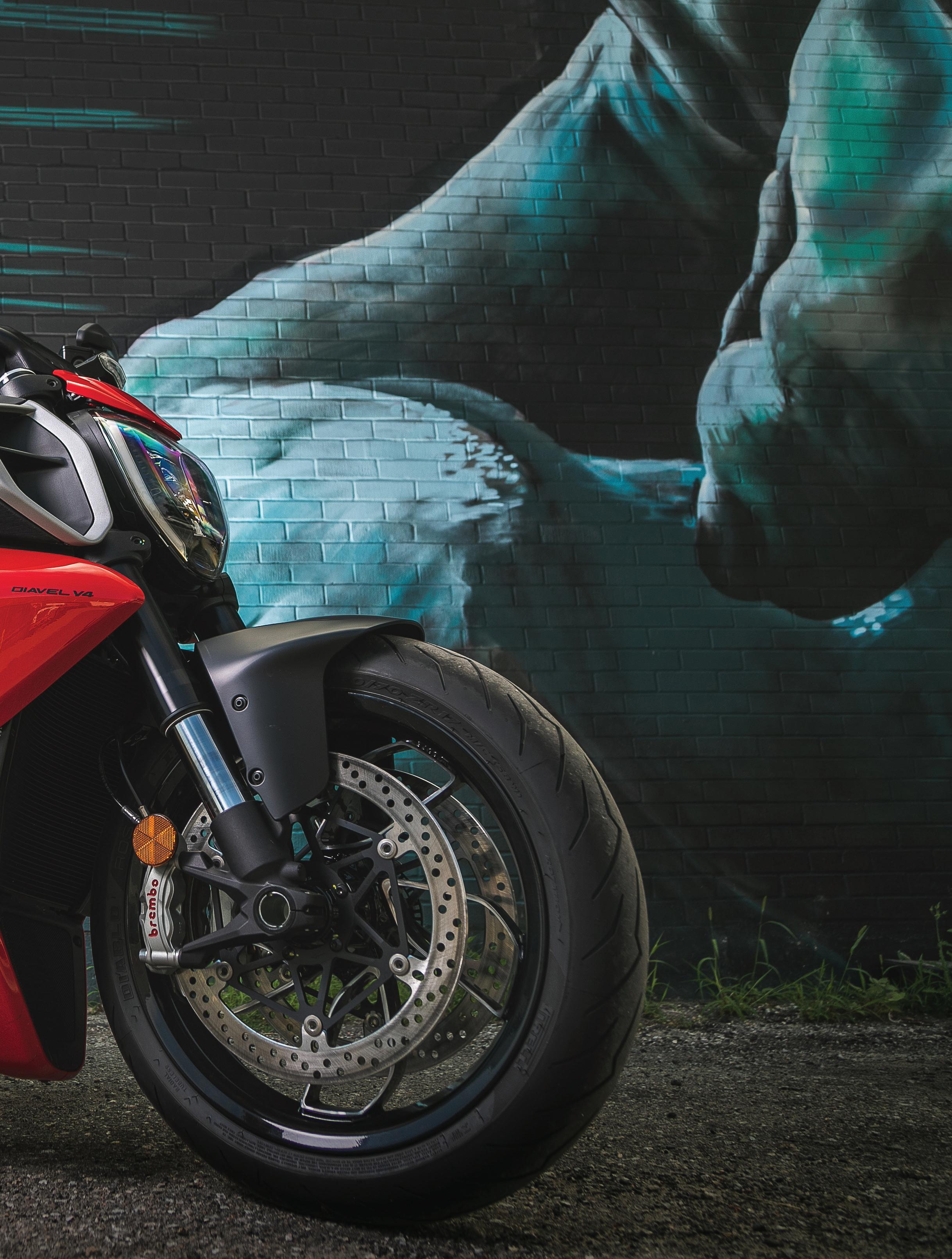
InsideMotorcycles.com 21
The previous-generation Diavel was powered by the Testastretta DVT 1,262 cc two-cylinder engine. The V4 ups the cylinder count but actually displaces slightly less at 1,158 cc. The power differences aren’t huge, with the old two-banger cranking out 157 hp and 95 ft-lb of torque, and the V4 chugging out 168 hp and 93 ft-lb. That said, the V4 is the technological peak of Ducati’s engine game, and there’s a ton of tech contained in this bike.
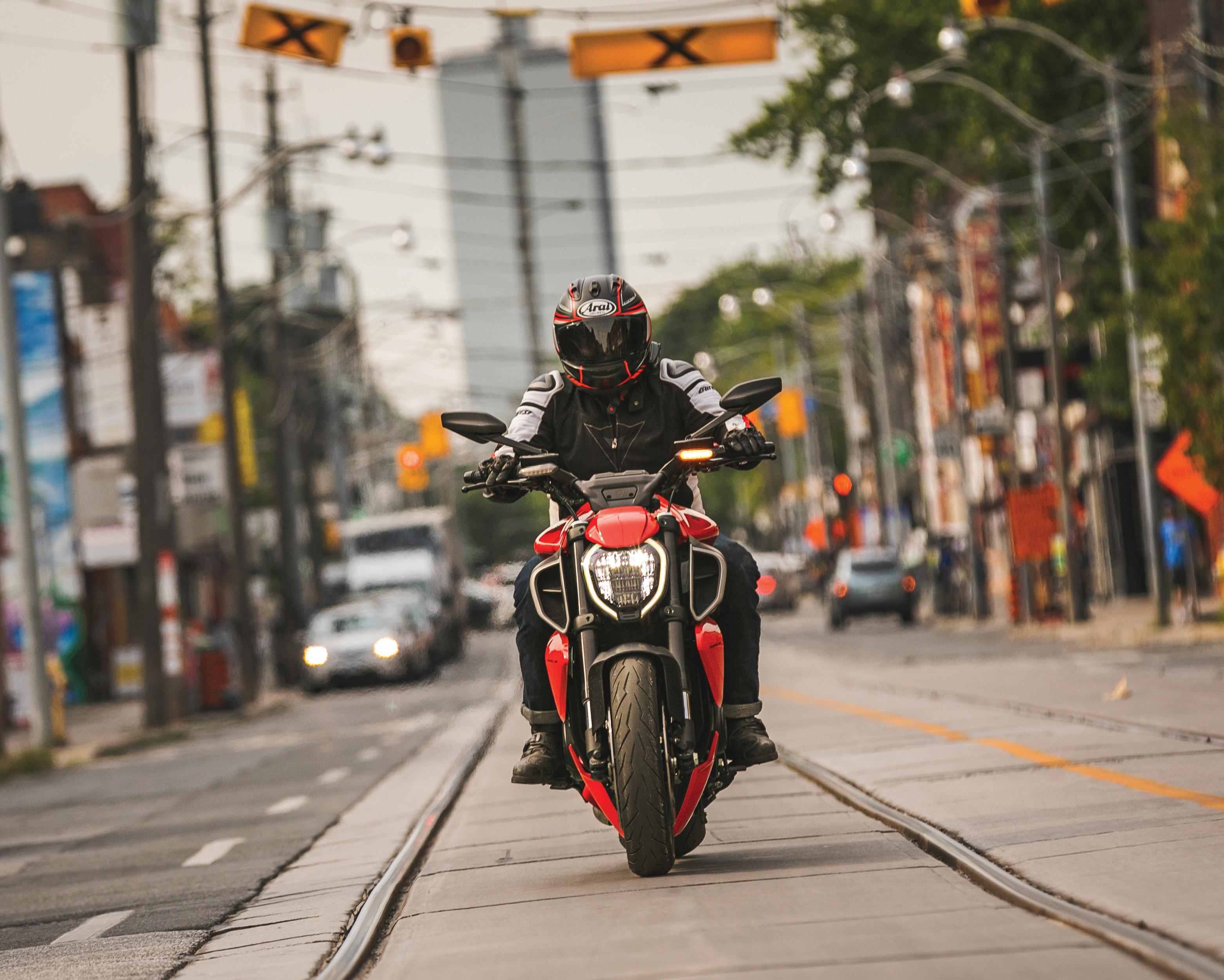
The Diavel V4 engine is built around a detuned version of the Desmosedici Stradale motor, the same engine that powers Ducati’s Panigale. In this configuration – the Granturisimo in Ducati-speak – valve actuation is via springs rather than the Panigale’s desmodromic complication. Worthy of note is Ducati’s maintenance schedule for this bike – valve adjustments are called for at 60,000 km. In a break from tradition, the Diavel V4 is constructed around an aluminum monocoque frame rather than the steel trellis of the 1260.
This Diavel V4 is equipped with a chunky, fully adjustable 50 mm fork and a fully adjustable shock. Brakes up front are massive 330 mm discs with top-notch Brembo calipers. There’s a bunch of electronic agents working behind the scenes to keep you safe: multiple riding modes, lean-sensitive traction control and ABS, quick shifter both up and down, and – very important
for this test rider – wheelie control. The Diavel is also armed with Ducati Power Launch, which I was not really willing to investigate because of the potential legal ramifications. In short, this is high-end sport-bike equipment, and it didn’t take much saddle time to realize that the Diavel is, at its essence, a topnotch sport bike with an odd riding position.
On slinging a leg over the bike, my first reaction was one of surprise at how light the Diavel felt. Approaching the bike for the first time, the Diavel presents as long, large and bulky. The visual muscle cruiser vibe is full-on raging with this bike. The fat, 240-series rear tire, which was designed specifically for the Diavel by Pirelli, combined with the four-barrel exhaust and bulbous side scoops, makes the bike look much heavier than it actually is. Consulting the specifications, I was startled to see that the Diavel weighs only 236 kg (520 lb) wet. Just going by appearances you’d be easily forgiven for thinking the Diavel clocks in at 45 kg (99 lb) heavier than this.
About that riding position. I’ve always preferred to have my feet under my hips rather than way the heck behind me or – even worse – underneath my elbows in the C-clamp cruiser contortion. So, while I was definitely looking forward to the Diavel experience, the concept of the power-cruiser riding position
22 Inside Motorcycles
didn’t exactly thrill me. Colour me surprised! The Diavel’s footpegs are only just slightly forward of centre, and the wide, flat seat is deceptively comfortable. Combine this with a reasonable, non-slammed seat height and my hips, knees and lower back were all surprisingly happy. The wide handlebar reaches back quite far and its height feels appropriately chosen, so all in all, the Diavel is quite a welcoming place of business.
All that said, there’s no wind protection, so the slightly reclined riding position renders highway speeds a touch fatiguing. However, the bike leaves the rider in clean air, and a back-road ride at around 100 km/h isn’t anywhere near as tiring as I’d anticipated. I took the Diavel for a ride from Toronto to Collingwood, about a two-and-a-half-hour ride by back-roads, and I arrived surprisingly fresh, only having stopped once for gas. The ride back home I didn’t stop once, and again, the Diavel was totally comfortable given its ostensible power-cruiser identity. That said, if this were my bike, I’d add a flyscreen in short order, aesthetics be damned.
My quibbles about ergonomics faded real quick when I let out the clutch. At reasonable throttle openings the Diavel felt utterly sophisticated and user friendly. As I said earlier, the Diavel is essentially a featherweight, and beyond that it carries its weight very low, so the transition from standstill to feet up was completely effortless. Clutch takeup is smooth as is throttle response, and the copious torque meant the bike acted like it was riding itself. At all speeds the Diavel felt outrageously nimble – almost flickable – which resulted in, for the first half hour of saddle
time, a sense of cognitive dissonance as my mind attempted to reconcile what visually presented as a huge lump of a motorcycle with its almost sport-bike handling.

I know, you’re not reading this to hear about low-speed handling. I’m guessing you want to know what happens when you twist the loud handle. Well, I’d wager it’s no surprise that the Diavel is horrifyingly fast. Of course it is. With 168 hp pushing a fairly light bike, the Diavel is obviously really, really fast, with the nut of it being that it’s essentially impossible to plumb the full depths of its performance while riding on public roads. On the occasions where I held the Diavel at full throttle, I had little opportunity to really rev it out much past its 7,500 rpm torque peak or – God forbid – to its 10,750 rpm horsepower peak.
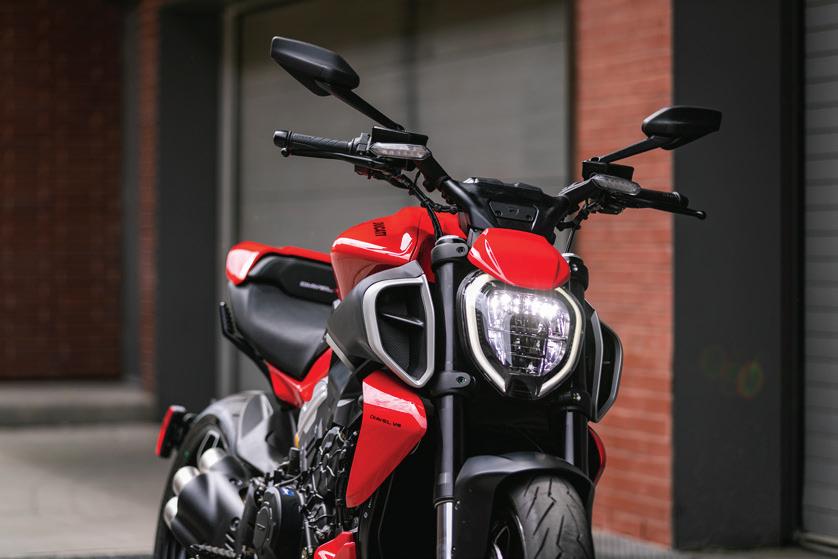
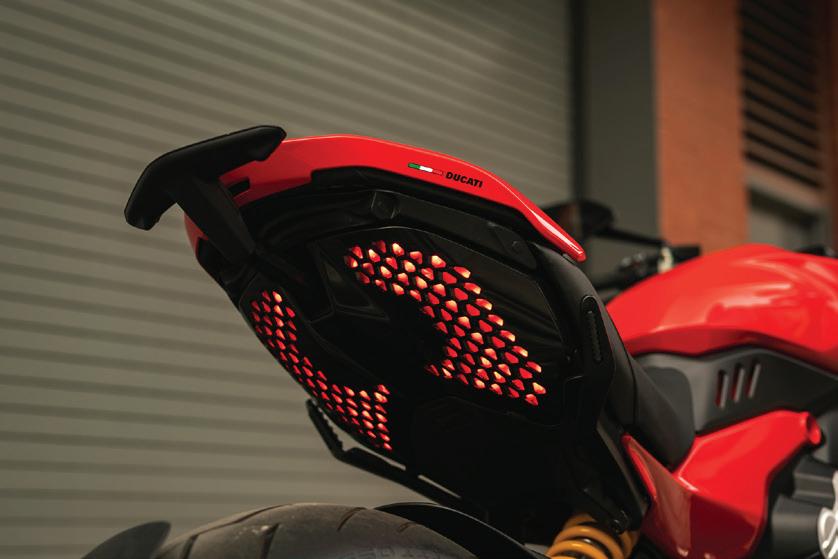


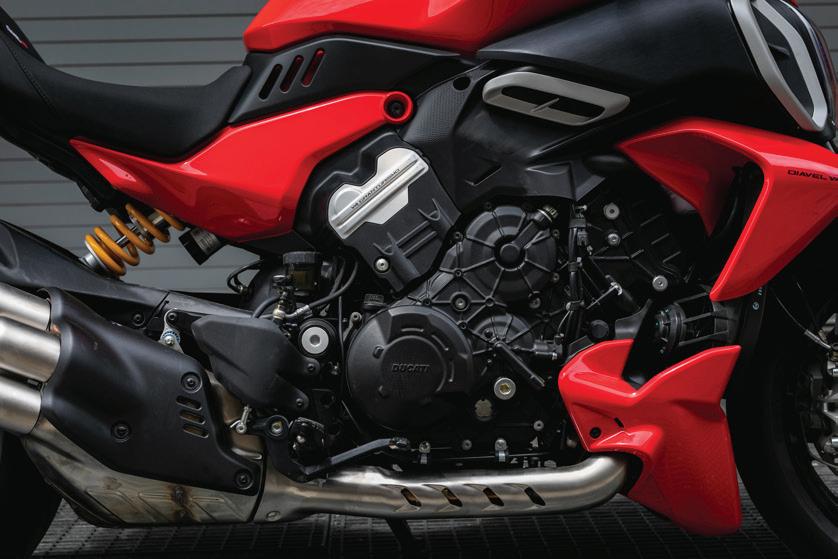
Still, the large, Superbike-derived motor has an almost unbearable charm. The magic middle, between 4,000 and 7,000 rpm, is an unqualified joy. The Diavel squirts ahead like a missile, the light weight and high power combining to deliver instantaneous, effortless acceleration.
The Diavel’s transmission feels like a precision instrument. Lever effort is a touch on the high side, asking for, but not really demanding a firm prod. There were zero false neutrals during my week with the bike, and I fell in love with the feeling of positivity as the lever engaged each gear. Likewise, the hydraulic clutch, with what I consider a perfect lever feel and wide engagement point. There’s a two-way quick shifter on board, and it’s very slick. I’m an old-fashioned clutch chap, but I did have fun playing with the quick shifter, shaking my head in amuse-

InsideMotorcycles.com 23
The latest edition of Ducati’s Diavel power cruiser is built around the company’s V4 engine (above left). Other features include Brembo brakes and large 50 mm inverted front fork (above centre) as well as a distinctive quad exhaust (above right). The unique tail light design highlights the rear of the motorcycle (below left), while large air intakes dominate the front visual (below centre). A full colour TFT display conveys information to the rider (below right).
ment at how very well it works.
Gearing is a touch high overall. First is fine, given the bike’s prodigious torque, but there’s a fair gap between first and second, which means I hunted between the first two gears in traffic. The Diavel revs at around 4,000 at 100 km/h. Any slower in top gear and the engine feels like it’s lugging and prefers that you shift down to fifth. So again, I found myself hunting a bit between the top two gears on country back-roads. A couple of extra teeth on the rear sprocket would likely tighten up the overall feel of the gearing.
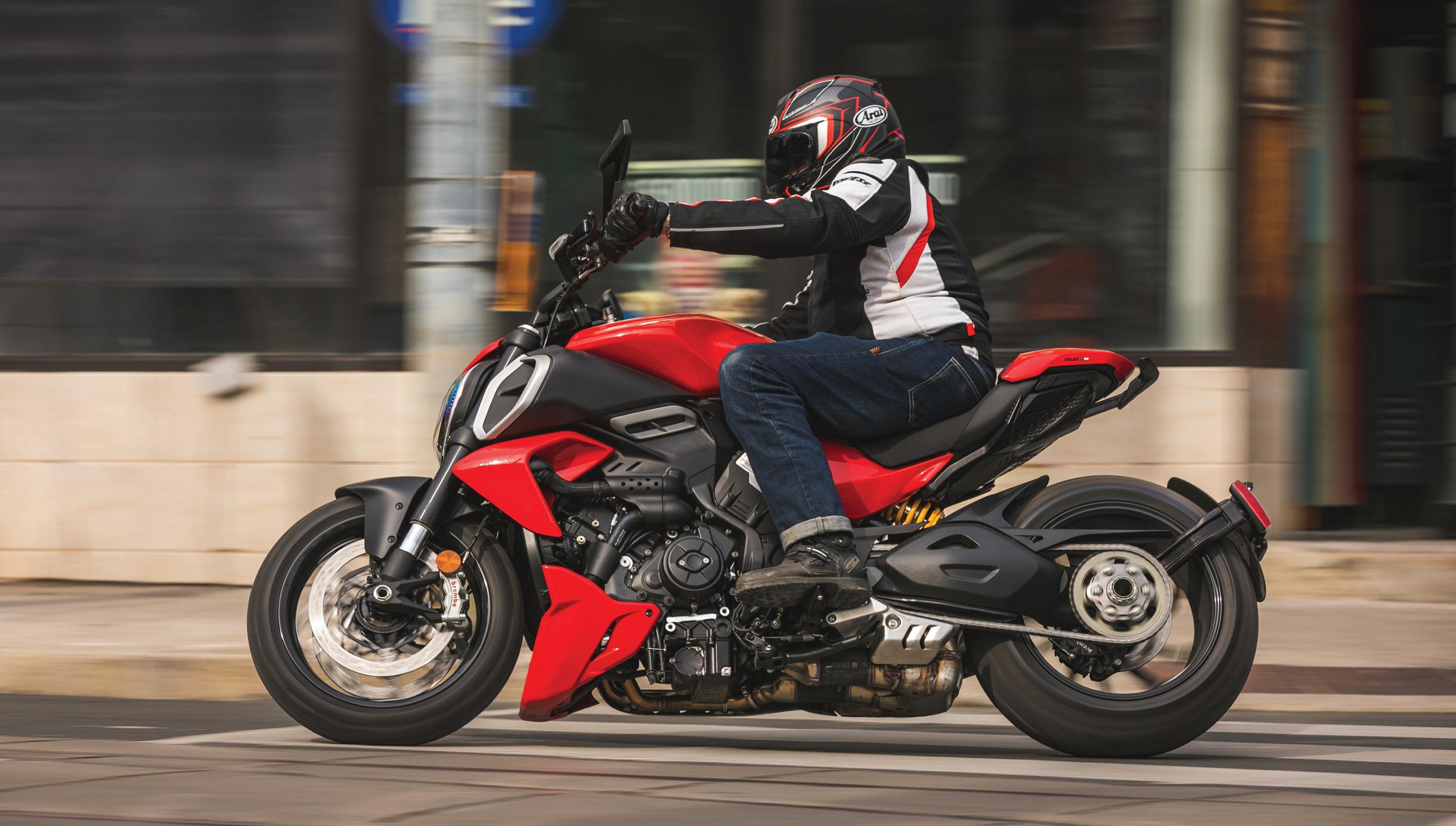
Those gigantic front discs rapidly haul the Diavel down from speed without drama. Again, lever feel is superb. The rear brake is very powerful, and I felt the ABS cycle in several times on dry pavement during hard stops.
Slow speed cornering is, for the most part, stable and free of drama except for one oddity. The bike’s length, and the seating position being so far back, leads to a slight feeling of disconnection between the bar and the front wheel. Nothing untoward ever occurred during hard cornering, but I couldn’t help but feel that the front wheel was somewhat detached from the rest of the bike in these situations, and that felt a teensy bit unsettling. Fast sweepers and switchbacks were a non-event in this regard – the bike provided superb feedback through the bar.
Turn-in was the biggest surprise here. With that fat 240-series rear tire, I expected the Diavel to fight me somewhat as I settled into turns, but, c’mon man, this is a Ducati, right? The company’s bread and butter is its handling prowess. And somehow they’ve made a motorcycle that feels like you’re sitting on a tractor drop into turns like a sport bike. Who knew that was even a thing?
Highway stability is likewise excellent. The Diavel feels like it’s riding on rails, and the high-quality suspension and cruise control combine to make the long drone almost painless. Almost painless. Both ends of the bike supply high-quality damping. The front fork is superb, and delivers excellent feed-
back and compliance. The rear end is – within its limits – excellent also. However, there’s not quite sufficient travel to deal with sharp-edged Torontonian expansion joints at highway speeds. I ended up having my ass whomped a few times, after which I tried to anticipate significant events and take the weight off my butt to mitigate such indignities.
Holding 20 litres, the Diavel’s steel fuel tank is surprisingly copious, especially considering how narrow the bike feels between the knees. I encountered the fuel light after 190 km of mixed city and back-road driving, including a significant amount of downtown congestion, at which point the bike sucked back 15 litres of premium – not bad given that I wasn’t babying the throttle.
It’s always a relief when I ride a test bike and immediately feel a connection, a sense of appreciation. It makes the week just fly by, and it makes the act of writing the review a pleasure. I really enjoyed my time with the Diavel. This bike works, as a whole, far better than it has any right to, and man, oh man, does it look the business.
At one point, as Ben Quinn was shooting static photos of the Diavel, I was standing back in the shade watching him work. We were outside of a Starbucks and three young teenage girls – about the same age as my daughter – were walking past, each being led along by their smartphones, like bulls being pulled by ropes threaded through rings in their noses. One of the girls looked sideways at the Diavel over the top of her phone, turned to me and said, “Nice bike.”
This might not seem like an event significant enough to warrant mention in this review, but I know how difficult it is for real-world events to penetrate the Matrix in which today’s youth is immersed.
That young lady’s nod to the Diavel mirrored my own appreciation. With this bike, Ducati has managed to shoehorn a wonderful sport bike into an utterly cool, space-age, laid-back package. It’s rare for a bike to be as much fun to ride as it is to look at. The 2023 Diavel V4 accomplishes this difficult task with ease. IM
24 Inside Motorcycles
2023 DUCATI DIAVEL V4
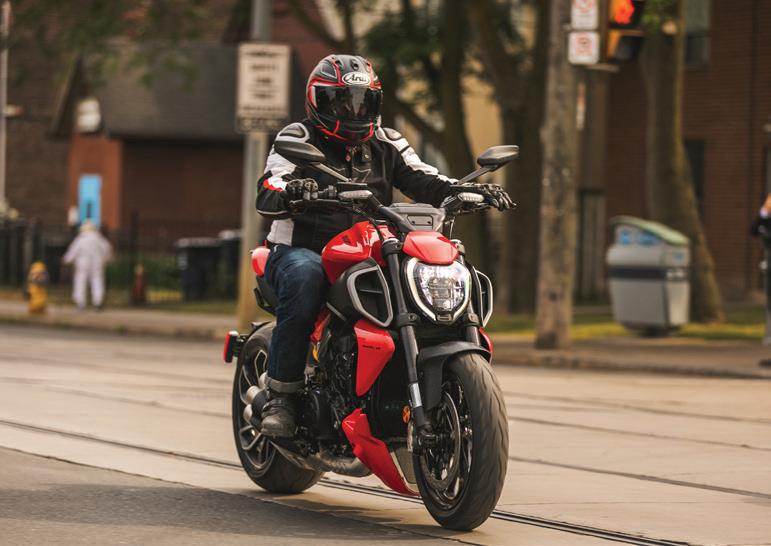
PROS:
+ Outrageous motor
+ Surprisingly comfortable
CONS:
- Rear travel a bit skimpy
- Gearing a touch tall
Suggested Retail:
$30,995
Colours: Ducati Red, Thrilling Black

Engine: V4, liquid-cooled
Displacement: 1,158 cc
Bore & Stroke: 83 x 53.5 mm
Compression Ratio: 14.0:1
Power: 168 hp @ 10,750 rpm
Torque: 93 ft-lb @ 7,500 rpm
Fuel Delivery: Fuel injected
Final Drive: Chain
Weight: 236 kg (520 lb) wet
Transmission: Six speed
Frame: Aluminum monocoque
Wheelbase: 1,593 mm (62.7 in)
Seat Height: 790 mm (31.1 in)
Suspension (front): 50 mm inverted fork, adjustable for preload, compression and rebound damping
Suspension (rear):
Single shock, adjustable for preload, compression and rebound damping
Tire (front):
Pirelli Diablo Rosso III 120/70 ZR 17
Tire (rear):
Pirelli Diablo Rosso III 240/45 ZR 17
Brakes (front):
Dual 330 mm discs, Brembo radial-mount monoblock four-piston calipers, cornering ABS
Brakes (rear):
Single 265 mm disc, Brembo two-piston floating caliper, cornering ABS
Fuel Capacity: 20 L
InsideMotorcycles.com 25
SPEC TABLE
Top Shelf Sport Tourer
BY PAUL PENZO PHOTOS BY BEN QUINN

We all know BMW typically produces motorcycles with a unique flair, attention to detail, good and easy to use tech, plus in a manner that also generally gets the job done well. So, if that sounds appealing and you are looking for a sport touring motorcycle that leans marginally more towards “sport,” this bike may be exactly what you are looking for.
I press the keyless power button where a key would normally go, the start button, and am pleasantly startled by a sudden thundering yet subdued rumble coming from its large EU-5 compliant chrome exhaust. This is BMW’s 2023 R 1250 RS, which has received its first major upgrade since the 1,254 cc liquid-cooled horizontally opposed flat-twin boxer engine was introduced in 2019 with ShiftCam intake technology. BMW has used the RS designation to label its sport touring models now for over 40 years.
As the bike warms up, the blend of a wide old school boxer engine partially wrapped by an upper fairing, combined with a very narrow modern-looking tail section perched above a single-sided shaft drive swingarm delivers an appealing “fat-skinny design contrast.” Nice to see how the famous boxer is used as a stressed member nestled in a black steel tube frame, with dark silver tail section for subtle contrast.
While available in three colour combinations that affect frame, subframe, bodywork, and caliper colours, this is the new Triple Black version with looks that are easily enjoyed. Even the radially mounted four piston Brembo brake calipers up front and two piston caliper in the rear are in gold for contrast and the silver used on the centre tank highlight flows into the fairing’s grey gauges section.
 2023 BMW R 1250 RS
2023 BMW R 1250 RS
INSIDE IMPRESSION | 2023 BMW R 1250 RS
26 Inside Motorcycles
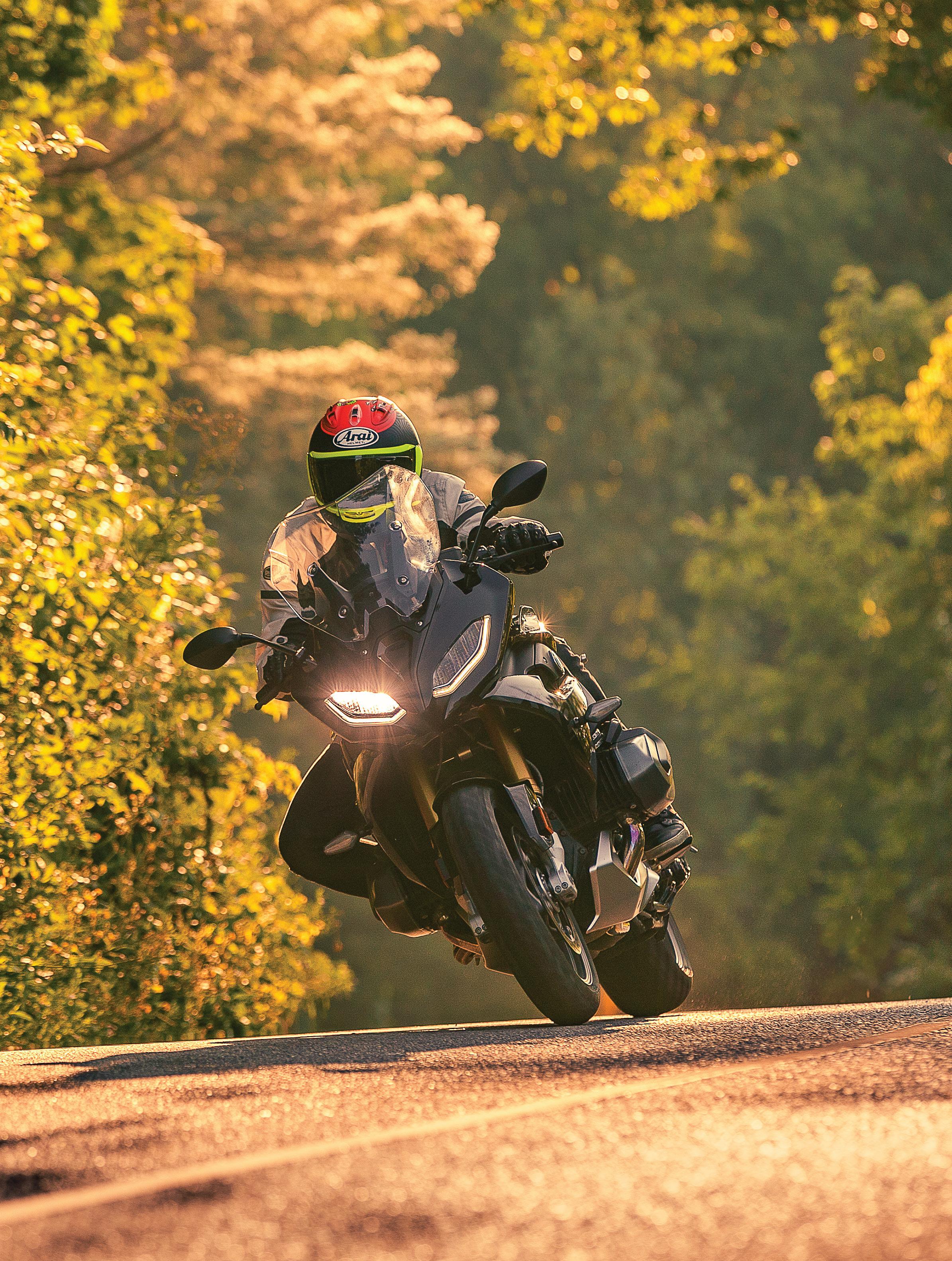
InsideMotorcycles.com 27
A new ECO power mode has also been added to help riders con serve fuel and ride more conservatively thanks to a softer throttle map. While still too warm to test, the rider’s heated seat and grips now have five heat level options. The RS also sports new LED blinkers and there are now two USB ports rather than one.


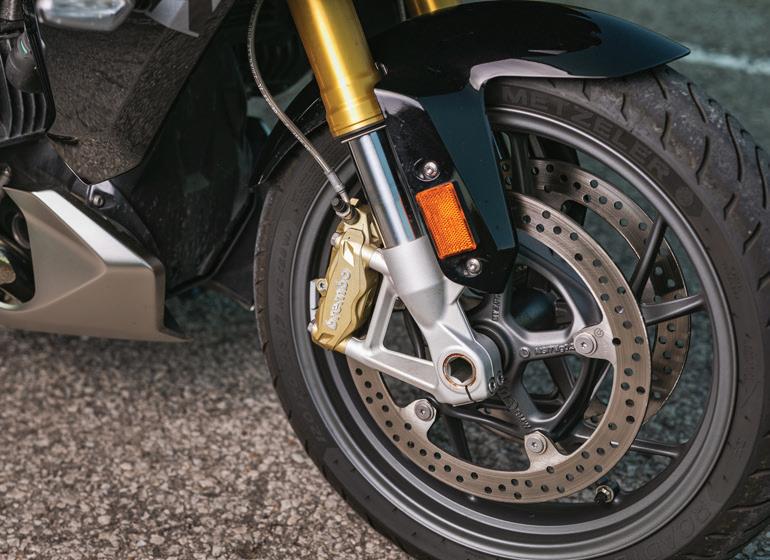
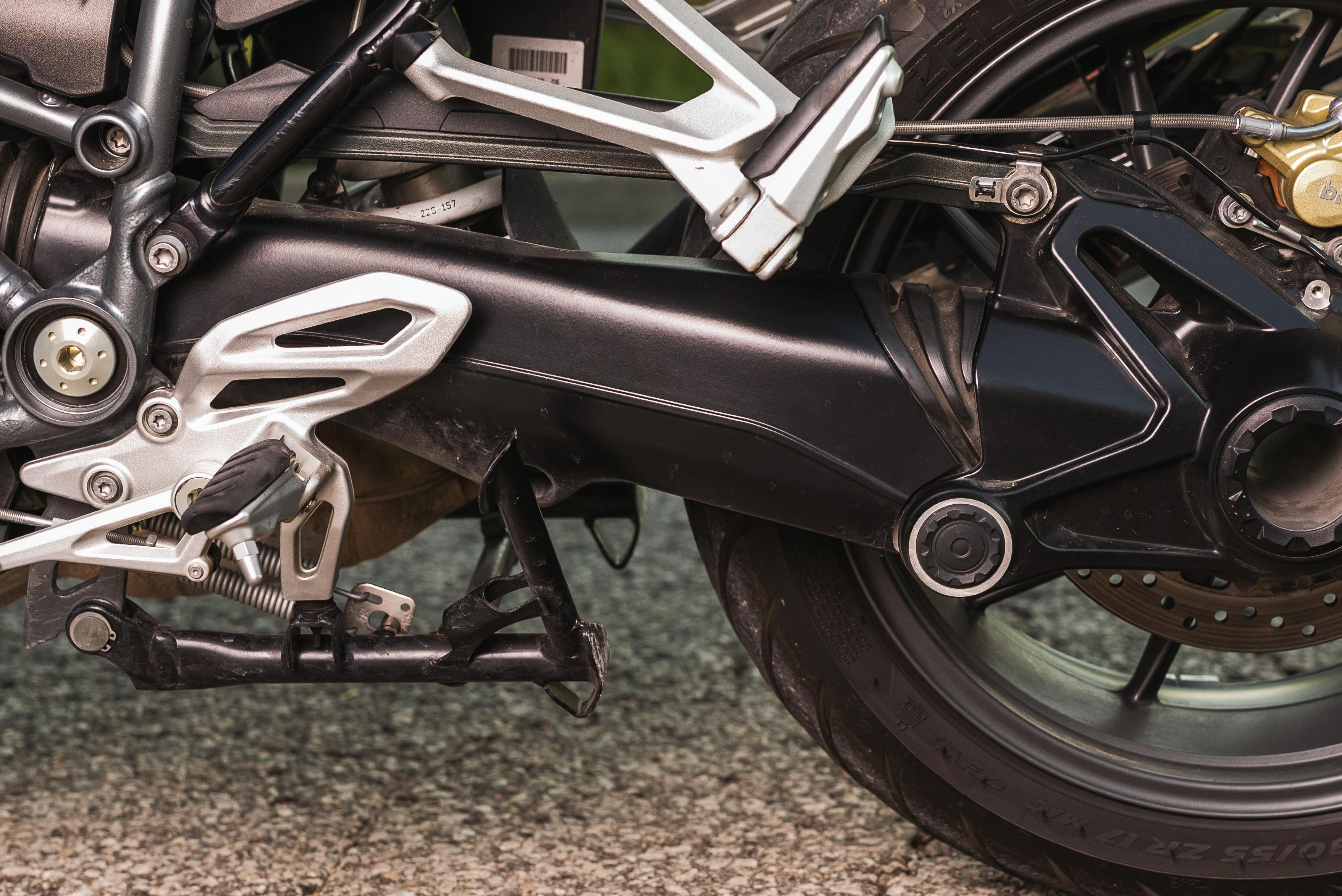
This RS has the Dynamic package installed, so both the inverted 45 mm fork and rear BMW Paralever shock are electronically controlled. Intuitive handlebar controls plus a large TFT display even those who need reading glasses will surely see at speed indicates I should be able to make adjustments while riding. The need for tools or understanding the fine art of motorcycle set up are presumably outdated; simply select the ride mode and enjoy.
I get on the bike, twist the throttle a bit now that it is warm, and the bike sways just a little to the left and then back to centre, its two large pistons showing subtle effects of internal centrifugal force. I appreciate this about similar twin cylinder configurations (whether in a BMW, Moto Guzzi, etc.), and it feels a bit like getting together with an old friend that has lost weight, gotten into shape and looks better than ever.
Pulling out over the first curb at low speed, I hear a minor rattle which repeats sporadically over other small bumps of sorts. It bugs me, so later when parked, I tap around to see what it may be –small rattles can be heard from the upper fairing, plastic rad hose covers, as well as part of the tail section. Nothing is ever perfect, right? It should be interesting to see what else comes up… My job is to find and then tell you about the good, the bad, and the ugly in a way you find interesting. Lets hope that that works out.
Time to give ’er, except I am still in the city. The ride starts in Rain mode where power delivery is smooth but too subdued for dry asphalt, so Road is selected for the first smooth city/highway
Plus, it helps to begin getting me acquainted with the TFT display setting options, power shifter, power curve, as well as how it handles. But please do not judge me by the large chicken strips of unused tire along the sides in the pictures, if visible. It has about 4,000 km on the odometer when static shots are taken; they get scrubbed out once leaned over for the first time at speed.
The first fun test is on one of those relatively deserted remote roads that weave through innumerable lakes and bodies of water. This almost 140-kilometre asphalt route has almost perfectly cambered and countless curves, with sporadic straights of varying lengths in between. But it is a rarely used public road rather than a racetrack, and so there are bumps and such to help keep things real while living the dream.
My butt slides from side-to-side with corresponding knee still far from but approaching the ground, while getting thrusted backwards on the straights while tucked in below the windscreen. It feels like a plush solo seat compared to those of race bikes from years past, and the bike sways from side-to-side with ease and stability. The suspension works well on the smooth stuff while also absorbing bumps, but standing on the pegs over bigger ones under acceleration sometimes helps.
The strong yet docile powerplant delivers linear torque that is easy to ride and enjoy throughout the rev range and peak output has been improved this year to a claimed 136 hp and 105 ft-lb, meaning that getting on it now delivers a progressively stronger propulsion. While it will wheelie in first gear under acceleration, this is not its forte. This RS is more about what happens smoothly with force anywhere from about 4,500 rpm onwards where true joy can be experienced. It is just smooth
28 Inside Motorcycles
BMW Motorrad’s focus on combining style with performance is evident throughout including the gold Brembo calipers (above left). As part of the touring package, our test model included the optional GPS unit to complement the standard equipped TFT display (above centre). On the performance front, the latest edition of the company’s 1,254 cc boxer engine (above right) produces a claimed 136 horsepower and 105.5 ft-lb of torque, while suspension adjustments can be made utilizing the controls located by the left hand grip (above opposite page).
and docile below.
I slow down on longer straights and give ’er as the corners approach, and it loves being under constant throttle mid-corner followed by getting on it aggressively from exit onwards. The bike is set to the manually configurable Dynamic Pro mode that automatically sets rider preload based on weight and riding conditions. While not truly hammering it, that together with the now standard DTC, Integral ABS Pro, and DBC all just work in almost imperceivable ways while travelling at a brisk “sport” pace.
The slipper (or anti-hopping) clutch combined with the quick shifter (Gear Shift Assistant Pro) work seamlessly together, regardless of where in the rev range the systems are used. Upshifting works best from second gear onwards, and it has a light-throw clutch lever to make using it easy between first and second. Downshifting is more forgiving about gear selection and where in the rpm range; the automatic throttle blips work well, and sound great going down through the gearbox.
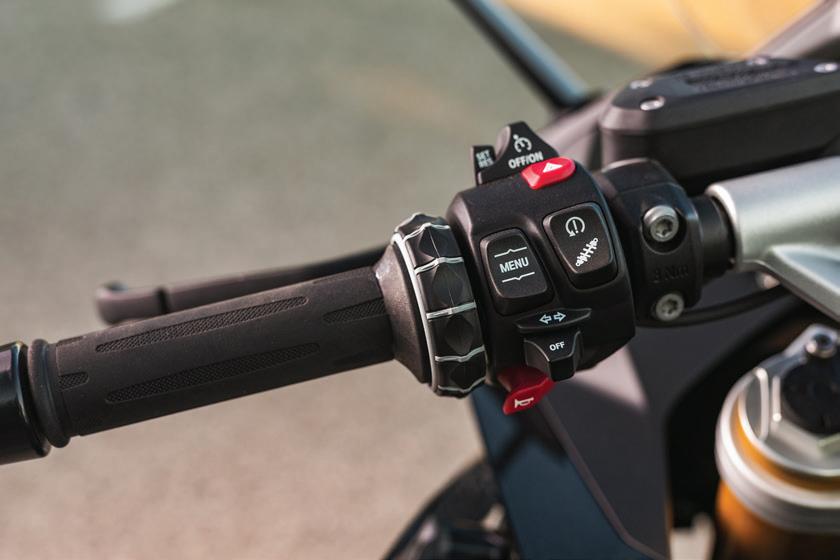

Not sure about you, but I tend to lose track of everything except the road, environment, sense of acceleration, handling and feeling of being alive while riding like this. To avoid having its rider begin looking for a gas station in a panic when returning from nirvana, the bright TFT colour display lights up with an unavoidable warning banner – getting gas is easier than ever; the keyless gas cap helps too.
This test model comes with the Touring Package that includes prep for GPS, cruise control, centre stand and luggage case brackets. While there are no luggage bags provided (which are splash –rather than water-proof), a BMW GPS is installed. It is set to avoid major highways, and clearly tells me where to turn
via a very large, easy to see matched full colour display – it is the best one I’ve used so far.
About 50 people from my wife’s side of the family plus close friends rent out most of a cottage resort every year. So, I admire the RS for days while parked as we go boating, hiking and just enjoy time together. When it is time to move on, my teenaged daughter asks if she can get on the back for a ride, which turns out to be the absolute best part of this test.
We do that same road, albeit at a reduced pace, and then wander about taking the very long way through winding but more heavily travelled roads. It starts to drizzle a bit, so I raise the adjustable screen while riding and stay dry. We stop where her mother and I got married to show her the lakeside resort for the first time, share memories and make new ones. But the bike conversation over lunch goes to how much our butts now hurt, and the painful thought of two more hours on that seat before the day is done. My butt is still sensitive, now days afterwards.
You may remember how I mentioned BMW’s R 1250 RS might just be perfect for you if looking for a quality sport touring motorcycle that leans just marginally more towards “sport.” I said this because of the seat, non-adjustable handlebar and almost complete lack of storage space. The RS seems perfect for aggressive rides shorter than about 90 minutes, but is less so over longer, calmer rides.
So, to be more specific, you should consider BMW’s R 1250 RS if you are the type of person who enjoys sport-oriented rides that last however long you please, as well as shorter more subdued ones alone as well as with the occasional passenger; especially if you also enjoy a quality motorcycle and being a bit different. IM

InsideMotorcycles.com 29
2023 BMW R 1250 RS

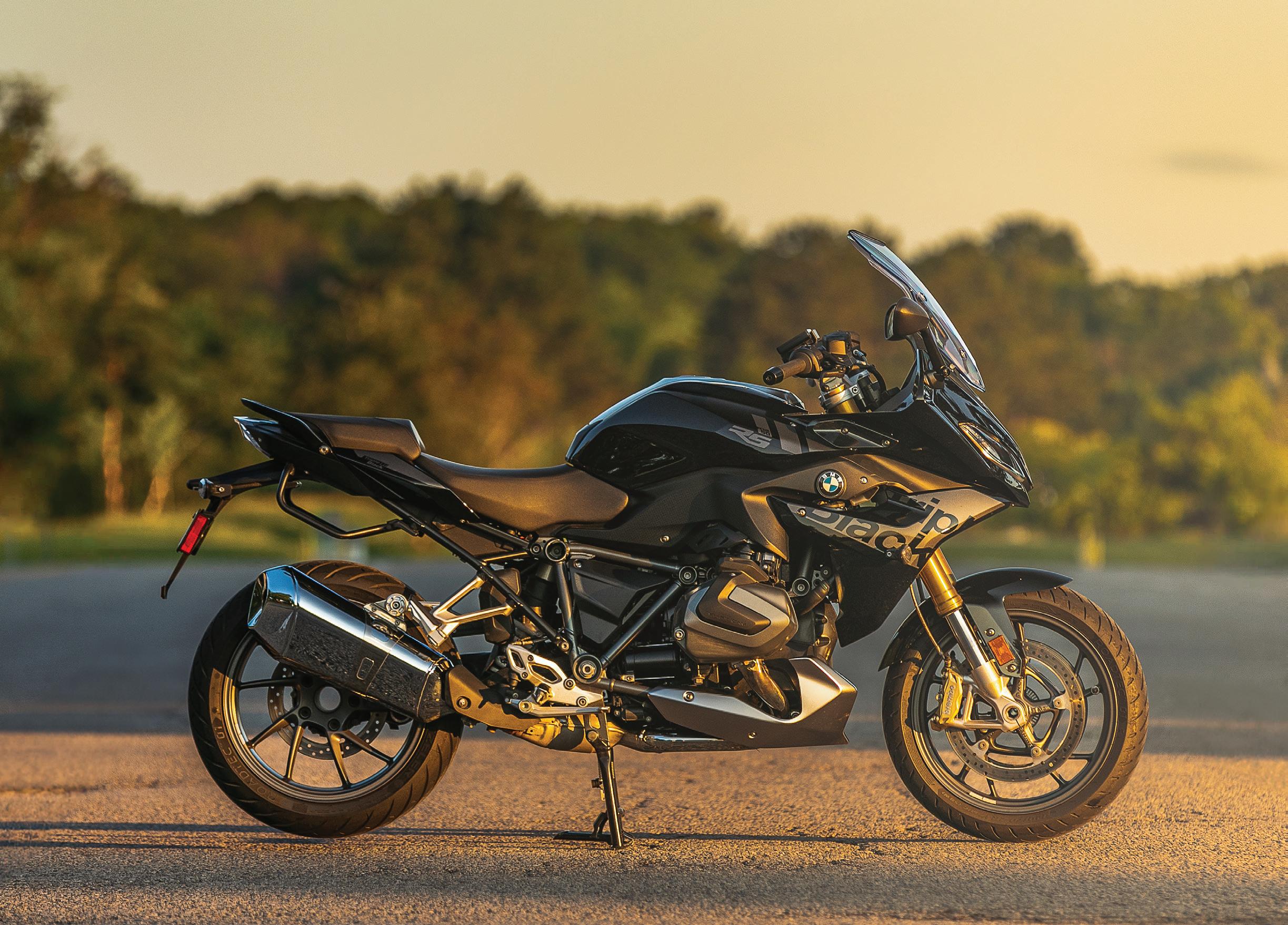
PROS:
+ The strong boxer engine, smooth power delivery and gearbox + The unique style, attention to detail, and overall quality
CONS:
- Small rattle at low speed
- Seating position becomes increasingly uncomfortable after first hour of touring
Suggested Retail: Starting at $18,195
Colours: Light White, Sport, Triple Black Engine: Air/liquid-cooled, two-cylinder boxer engine
Displacement: 1,254cc
Bore & Stroke: 102.5 x 76 mm
Compression Ratio: 12.5:1
Power: 136 hp @ 7,750 rpm
Torque: 105.5 ft-lb @ 6,250 rpm
Fuel Delivery: Fuel injected
Final Drive: Shaft
Weight: 243 kg (536 lb) wet
Transmission: Six speed
Frame: Steel tube with load-bearing engine
Wheelbase: 1,527 mm (60.1 in)
Seat Height: 818 mm (32.2 in)
Suspension (front): Inverted 45 mm fork
Suspension (rear): BMW Paralever, rear spring/shock with preload and rebound adjustment and travel-dependent damping (WAD)
Tire (front): 120/70 ZR17
Tire (rear): 180/55 ZR17
Brakes (front): Dual 320 mm floating discs, 4-piston radial-mount calipers
Brakes (rear): Single 276 mm disc with 2-piston floating caliper
Fuel Capacity: 18 L
30 Inside Motorcycles
SPEC TABLE


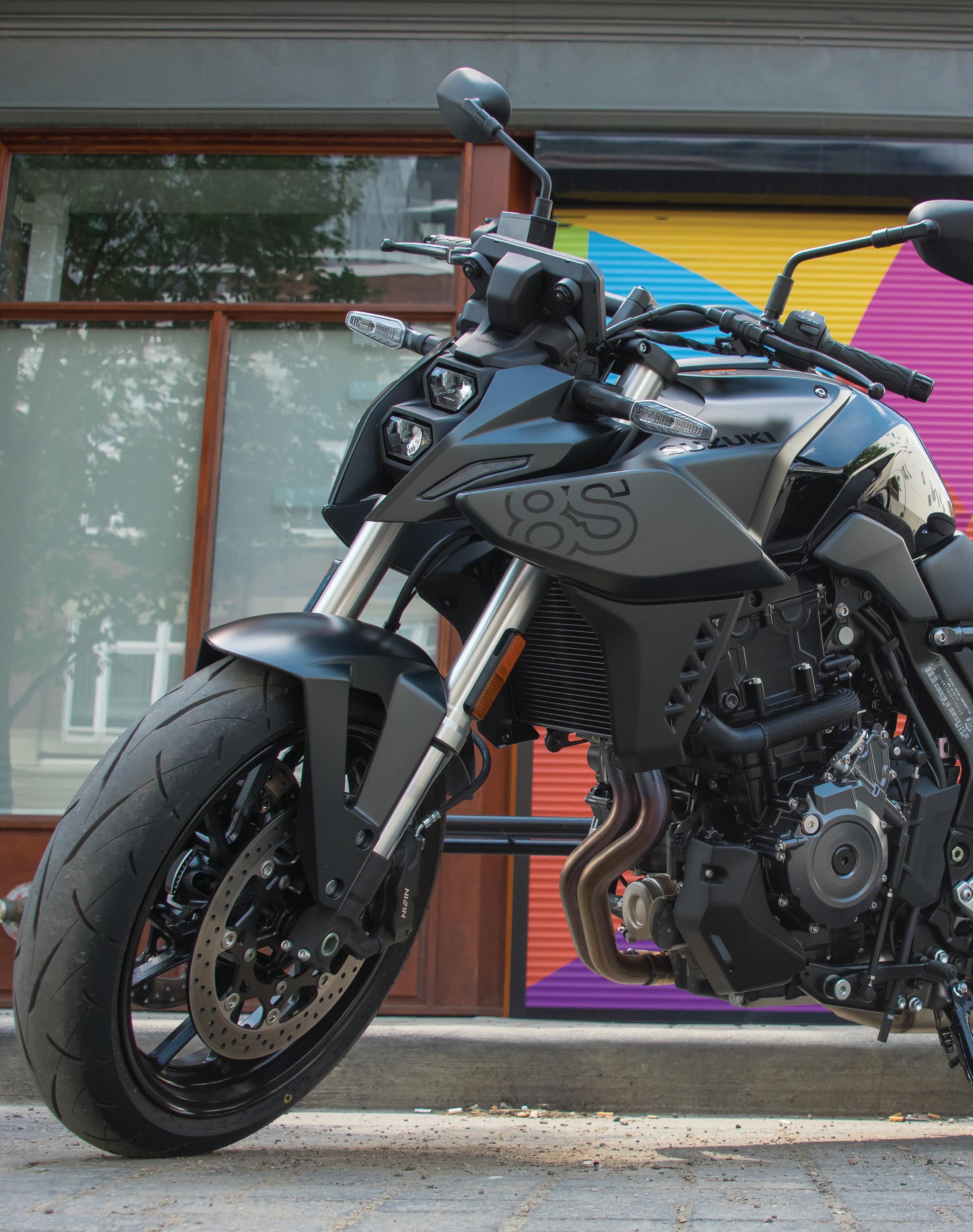
INSIDE IMPRESSION | 2023 SUZUKI GSX-8S 32 Inside Motorcycles
THE NEW MIDDLEWEIGHT CHALLENGER
BY PATRICK LAMBIE PHOTOS BY ANETT MESZAROS
When Suzuki announced their all-new 776 cc parallel-twin engine, the introduction of the V-Stom 800 DE was the dominant headline. Of course, adventure enthusiasts revelled in the arrival of this new dual sport machine while debating if it could still be a V-Strom even without a V-twin engine. Although this new V-Strom deservedly so garnered attention, there was another side to the story of Suzuki’s new parallel-twin engine.
Coinciding with this product unveiling, although seemingly lost in the shadow of the V-Strom, the 2023 Suzuki GSX-8S also made its way onto the stage as the newest member of Suzuki’s family of street bikes. Where the V-Strom 800 DE is sure to satisfy riders in search of dual-sport and long-haul capabilities – or at least to look the part at Tim Hortons on Sunday morning – for riders who spend all of their time on asphalt surfaces and rarely undertake multi-day motorcycle trips, the 2023 Suzuki GSX-8S is ready to provide a sporty take on this all new platform.
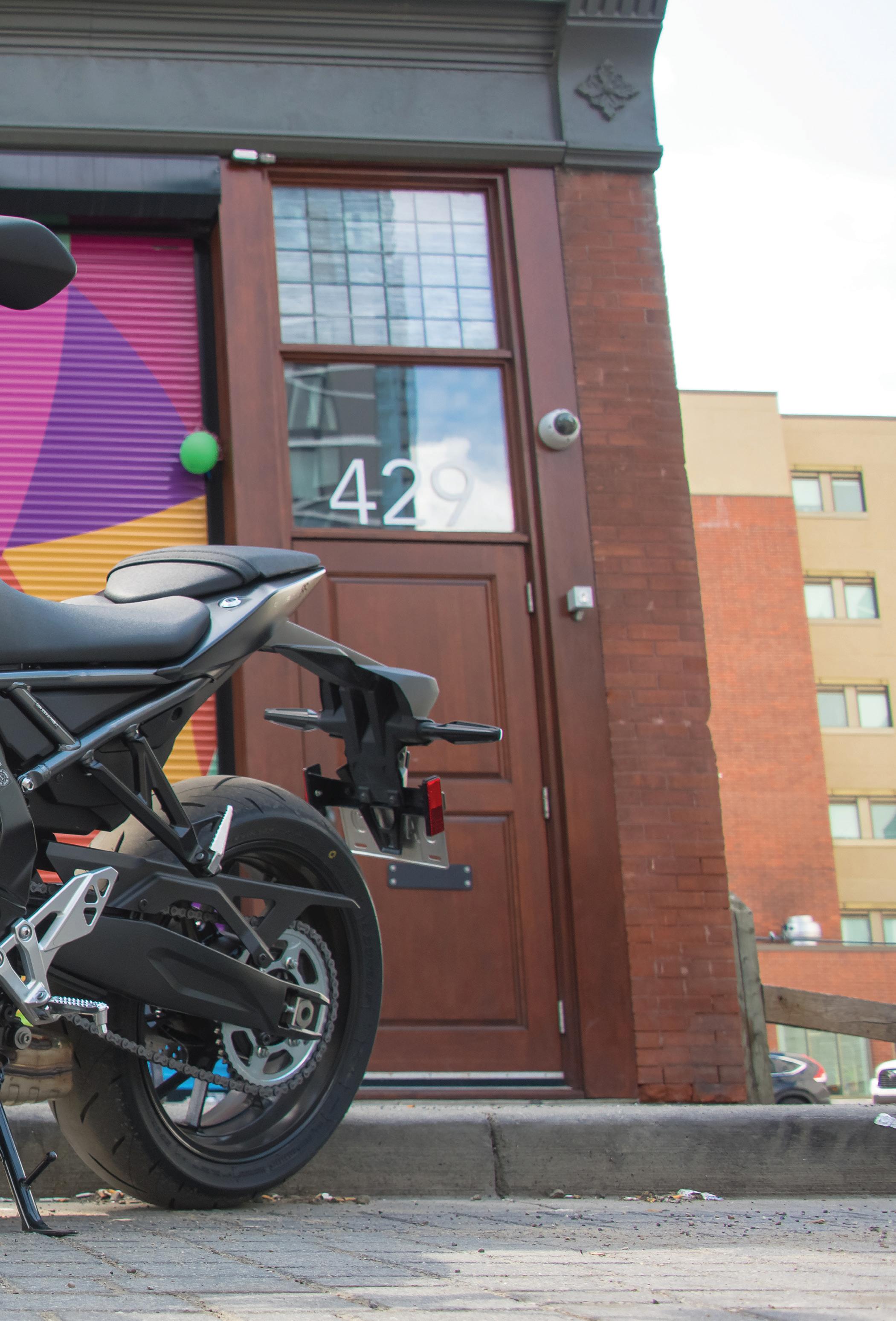
A quick run through of the specifications prior to my in-person introduction to the GSX-8S revealed a wellequipped motorcycle in relation to its $10,749 Canadian MSRP. Throttle by wire accommodates the inclusion of a complete set of electronics including three selectable ride modes: A (sport performance) B (normal riding conditions) and C (wet and slippery conditions). Additional electronic rider aids within the Suzuki Intelligent Ride System include traction control, ABS, low rpm assist and a bi-directional quick shifter. Other standard features include full LED lighting and a five-inch full-colour TFT display.
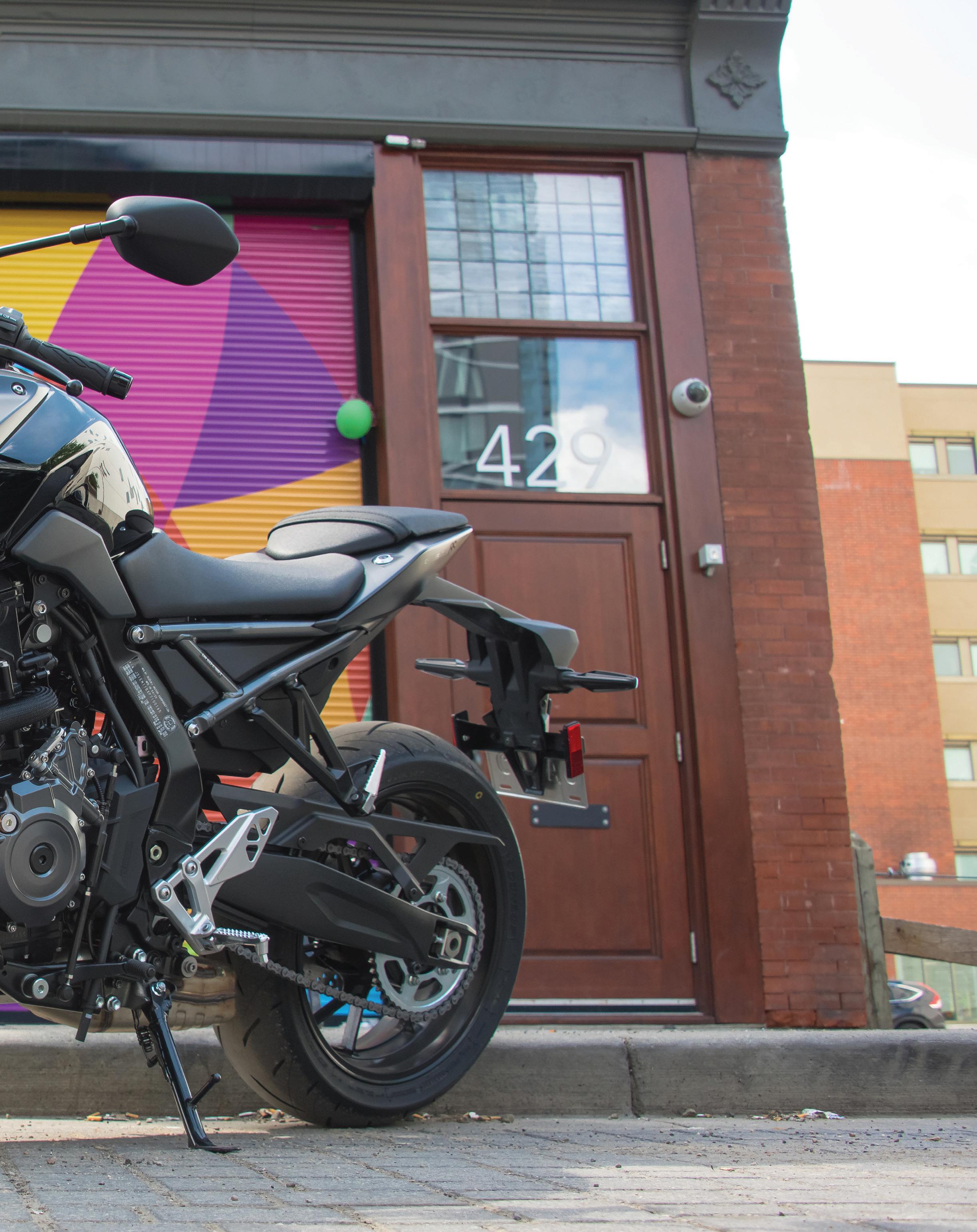 2023 Suzuki GSX-8S
2023 Suzuki GSX-8S
InsideMotorcycles.com 33
Suzuki’s Canadian website describes the visual design of the 8S as “mass forward” and this theme definitely resonated during my initial introduction to the motorcycle when picking it up at Barnes Powersports Blackfoot in Calgary. Minimal bodywork, a shortened exhaust and an exposed tubular frame create a slim rear profile with the large tank shrouds protruding well past the front fork drawing attention to the front of the motorcycle. Looking at the bike head on, stacked LED headlights combine with the shrouds to create a combination of the Transformers’ Bumblebee and the speeder bikes utilized by Imperial stormtroopers in Star Wars. Two weeks after this test ride, I still haven’t decided if I like this look or not. Of course, beauty is in the eye of the beholder.
Design features and electronic technology aside, the star of this show is the all-new liquid-cooled 776 cc parallel twin engine developed specifically for the GSX-8S – as well as the V-Strom 800 DE. Thanks to Suzuki’s Easy Start System, a quick thumb to the starter button is all that is required to bring 8S to life, as it settles into its subdued and somewhat surprisingly familiar exhaust note.
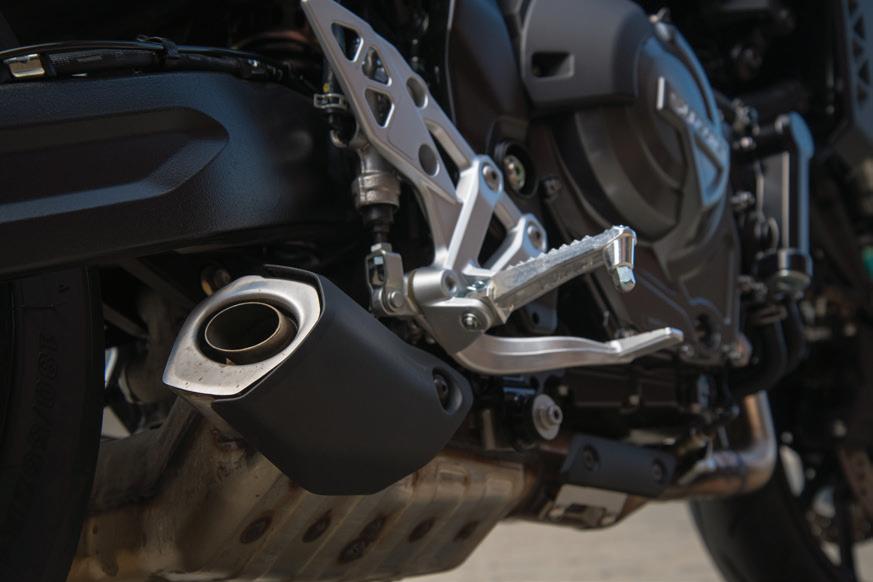

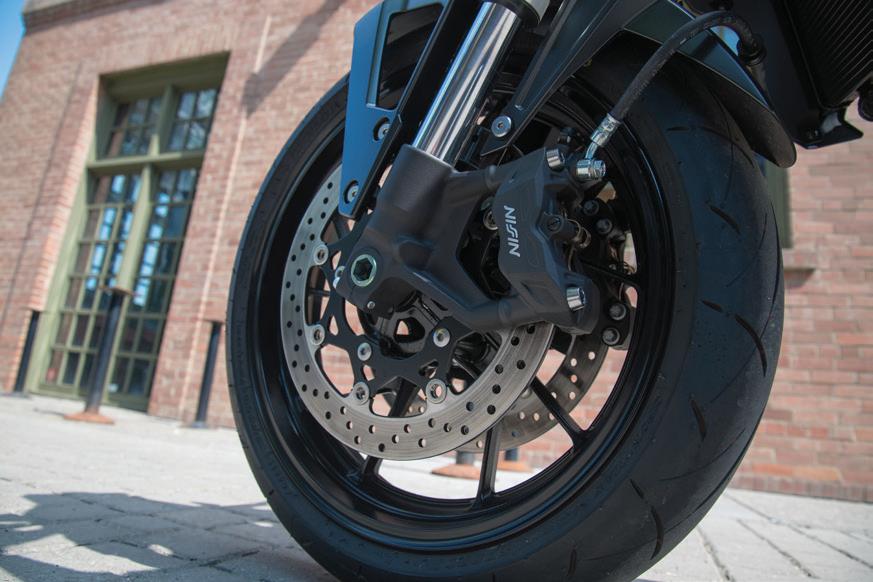

In creating this new engine, Suzuki followed the trend established within their competitive set over the last several years and incorporated a 270-degree crankshaft layout to mimic the attributes of a V-twin configuration. Not content to simply follow others, this latest powerplant from Suzuki also serves as the introduction of the company’s new Cross Balancer technology, which explores new frontiers with the inclusion of two balancer shafts instead of the single balancer shaft layout found in the parallel twin engines of Suzuki’s competitors. With each balancer matched up to individual cylinder, Suzuki
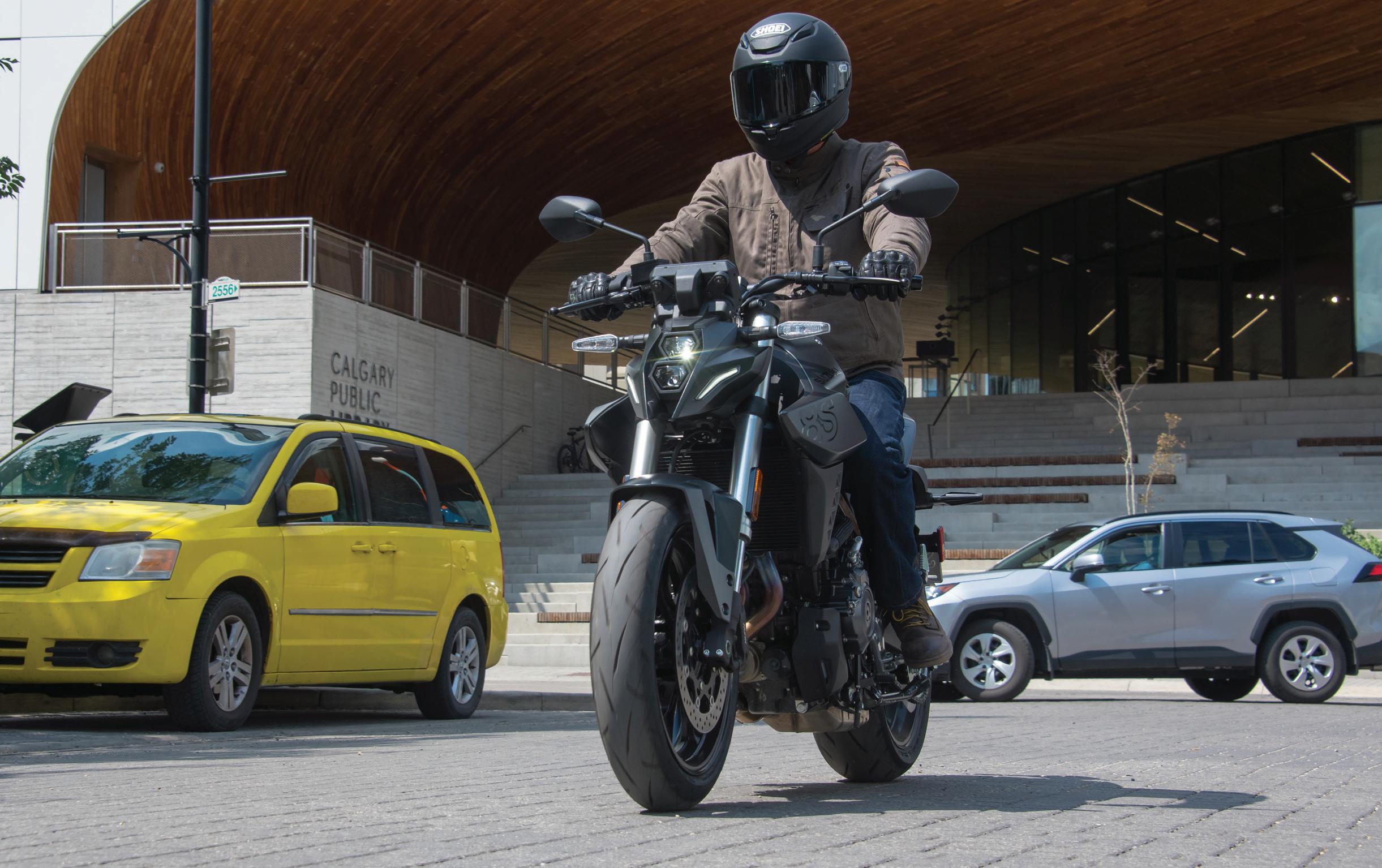
34 Inside Motorcycles
While the all-new 776 cc parallel-twin engine (below left) is the star of the GSX-8S, other components including the quality brake setup (below centre), full-colour display (below right) and “shorty” exhaust (below bottom) round out the overall package.
claims that this patented technology not only provides superior suppression of vibration but also accommodates a more compact engine design.
Ready to experience the GSX-8S, rare sub-30-degree Celsius temperatures on the day I picked up the bike from Barnes opened the door to take the 8S out onto to some of the superb twisty highways outside of nearby Bragg Creek. Out on the highway, it should come as no surprise that the engine provided an immediate impact. In addition to confirming that the Cross Balancer technology is the real deal, limiting vibration to a nearly inconsequential level, this first ride provided insight into the overall performance and the 8S did not disappoint.
Simply put, this new powerplant is excellent. Marrying a smooth powerband with torque on demand, the 8S pulls hard between 3,500 and 7,500 rpm, but is also content lugging along in lower rpm ranges in heavy traffic. Flying along one of my long-time favourite highways, the parallel twin engine provided solid acceleration out of corners with immediate tight throttle response. Working through the multiple ride modes, I found that the A drive mode was a perfect companion for the dry pristine asphalt but could also envision the benefits of the reduced throttle response and power of the two alternate modes in less than optimum weather.
The reality is that the engine is only part of the equation and in the case of the GSX-8S this means that the suspension and braking have a lot to live up to.
One of the first areas that seem to get cut when building an affordable street bike is the suspension and lack of adjustment on the inverted KYB front fork combined with the preload-only adjustment on the rear KYB monoshock, confirms that Suzuki has followed this recipe. On the surface this seems like a limiting factor, but as growing confidence saw pace through the corners pick up the stock suspension setup performed well, with minimal diving during hard braking, no squatting during acceleration and imperfections in the asphalt easily absorbed even at full angle. If anything, for my 160 lb weight, the stock suspension setup provided a feel that could be described as a little stiff, which reflects the need to accommodate riders of all sizes on a single mostly non-adjustable suspension setup.
On the braking front, the 8S’ setup with dual 310 mm discs and Nissin four-piston calipers on the front wheel paired with a 240 mm disc and a Nissin single-piston caliper at the rear proved to be more than ample during even the most aggressive braking, where the presence of ABS provided the confidence required to charge corners with abandon.
While the combination of a torquey powerplant, surprisingly solid suspension and competent braking setup make the GSX-8S a competent canyon carver, the inclusion of Suzuki’s bi-directional quick shifter and Clutch Assist System put the icing on the cake, accommodating aggressive downshifts coming into corners as well as full-on acceleration once the exit point revealed itself. Having experienced quick shifter setups from several manufacturers, I can attest that the system on the 8S is as good as any I have used, working flawlessly with no false neutrals or missed shifts encountered.
While not intentional, motorcycle reviews tend to often overlook the stock tires on new models. Yes, this make sense given that most riders will ultimately determine the brand and model of rubber that connects their bike to the road; however, after pushing the bike to its limits for an afternoon, it would be unfair
not to give a shout out to the Dunlop Sportmax Roadsport 2 tires (120/70 ZR17 front and 180/55 ZR17 rear) that ship stock on the GSX-8S. Capable of accommodating road race lean angles while providing the feel and feedback expected from top shelf performance-based tires, these stock tires are capable of handling whatever even the most aggressive rider may throw their way.
With the 8S parked in the garage after a successful day of exploring and riding twisties, I found myself genuinely impressed with this new model, with it having proven to be a solid contender in the middleweight naked segment. At the same time a nagging voice from the recesses of my mind kept coming back to the fact that the practical uses of this motorcycle also lay within urban landscape. The good news is that this day of cruising nearby highways on the 8S was only the beginning of this particular test ride as the following day’s photoshoot in Calgary’s downtown beltline would provide insight into this bike’s urban commuting abilities.
Navigating through chaotic Sunday afternoon traffic including the distracted pedestrians wandering into the street brought the urban mindset to life and allowed the GSX-8S to demonstrate its big city capabilities and made me thankful for the bike’s upright seating position that provides the ability to both see and be seen. In stop and go traffic, the engine’s willingness to lug along at rpm as low as 2,000 was also a welcome characteristic as was the succinct braking setup that facilitated the quick stops required when vehicles choose to ignore traffic signage and pull directly in front of you.
Out on the highway, the 8S’ light 202 kg (445 lb) wet weight makes it easy to throw the bike into corners and transition from side to side, and this proved to also be true when working through parking lots and other tight situations. While some may find the buffeting winds on a naked bike detrimental to riding on the highway, with the temperatures once again back above the 30-degree mark, the lack of bodywork provided a much welcome assistance in tolerating the heat while riding around town.
Dropping the GSX-8S off at Barnes Powersports Blackfoot, a walk through the showroom provided insight into the depth of the market that this new model plays in. With competition from literally every major brand, Suzuki will need to convince consumers that the 8S is worthy of its $10,749 asking price that comes in above the $9,999 sticker price of KTM’s 790 Duke and Yamaha’s MT-07, both of which are direct competitors.
This naturally leads to the question of “Is it worth it?” Having spent time on the GSX-8S on the highway as well as busy downtown streets, I can confirm that Suzuki has created a motorcycle that is comfortable in both scenarios. Thanks to its light weight, smooth power delivery and selectable power modes the 8S will also appeal to both new and experienced riders. Yes, the Suzuki costs an extra $750, but inclusion of the quick shifter alone, which is not available on the Yamaha and only as option on the Duke, not to mention the company’s new Cross Balancer setup, will account for the premium price.
At the end of the day, deciding on a new motorcycle is as personal a choice as selecting the neighbourhood you live in. Just like selecting a house or apartment to call home, finding the right motorcycle can involve looking at a lot of options and a lot of research. If you are in the market for a new motorcycle that is equally capable on the highway and the street, the Suzuki GSX8S is a solid option that deserves a spot on your short list. IM
InsideMotorcycles.com 35
2023 SUZUKI GSX-8S
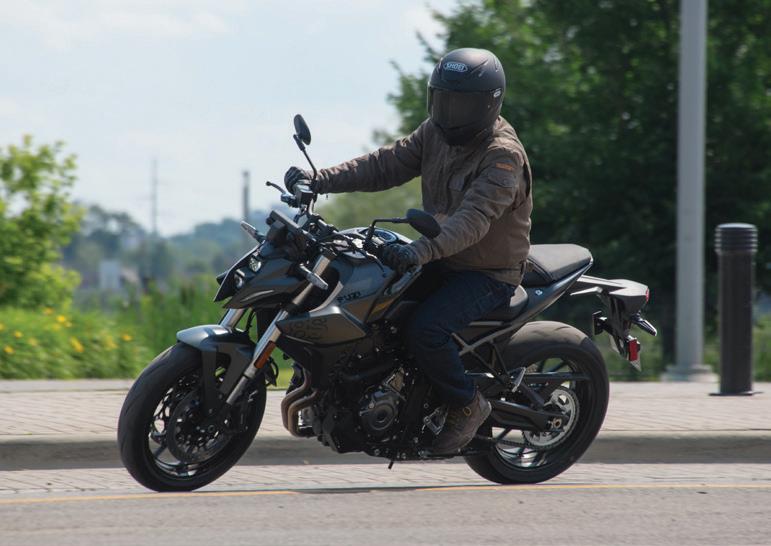
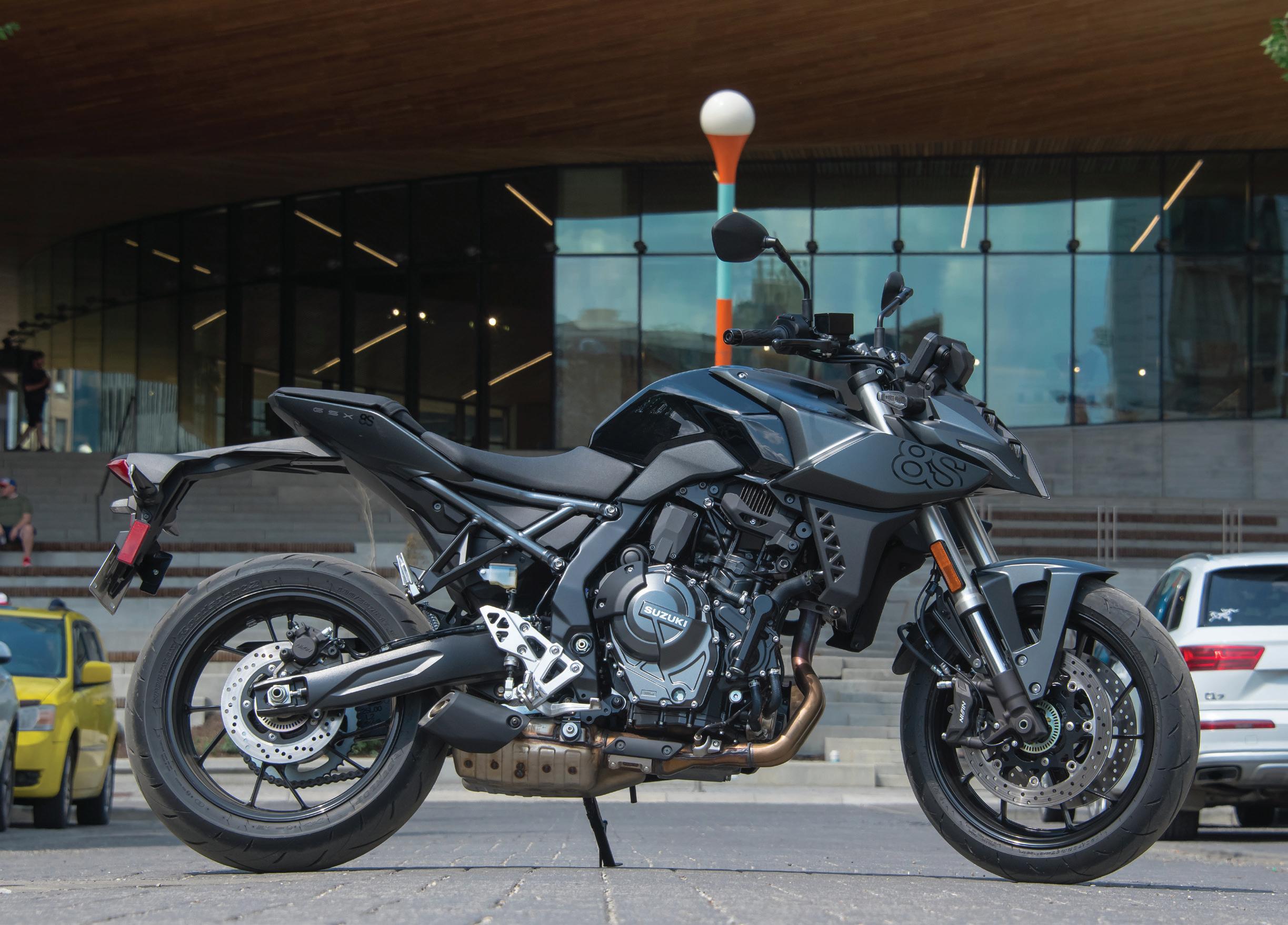
PROS:
+ All-new engine delivers
+ Quality quick-shifter
CONS:
- Non-adjustable suspension
- Unique bodywork design may take some time to get used to
Suggested Retail: $10,749
Colours:
Pearl Cosmic Blue, Pear Tech White, Metallic Mat Black
Engine:
Liquid-cooled, parallel-twin
Displacement: 776 cc
Bore & Stroke: 84 x 70 mm
Compression Ratio: 12.8:1
Power: n/a
Torque: n/a
Fuel Delivery: Fuel injected
Final Drive: Chain
Weight: 202 kg (445 lb) wet
Transmission: Six speed
Frame: Tubular steel
Wheelbase: 1,465 mm (57.7 in)
Seat Height: 810 mm (31.9 in)
Suspension (front): KYB inverted fork, non-adjustable
Suspension (rear): KYB monoshock adjustable for preload
Tire (front):
Dunlop Sportmax Roadsport 2 120/70 ZR17
Tire (rear):
Dunlop Sportmax Roadsport 2 180/55 ZR17
Brakes (front):
Dual 310 mm discs with Nissin 4-piston calipers
Brakes (rear): 240 mm with Nissin single-piston caliper
Fuel Capacity: 14 L
SPEC TABLE 36 Inside Motorcycles
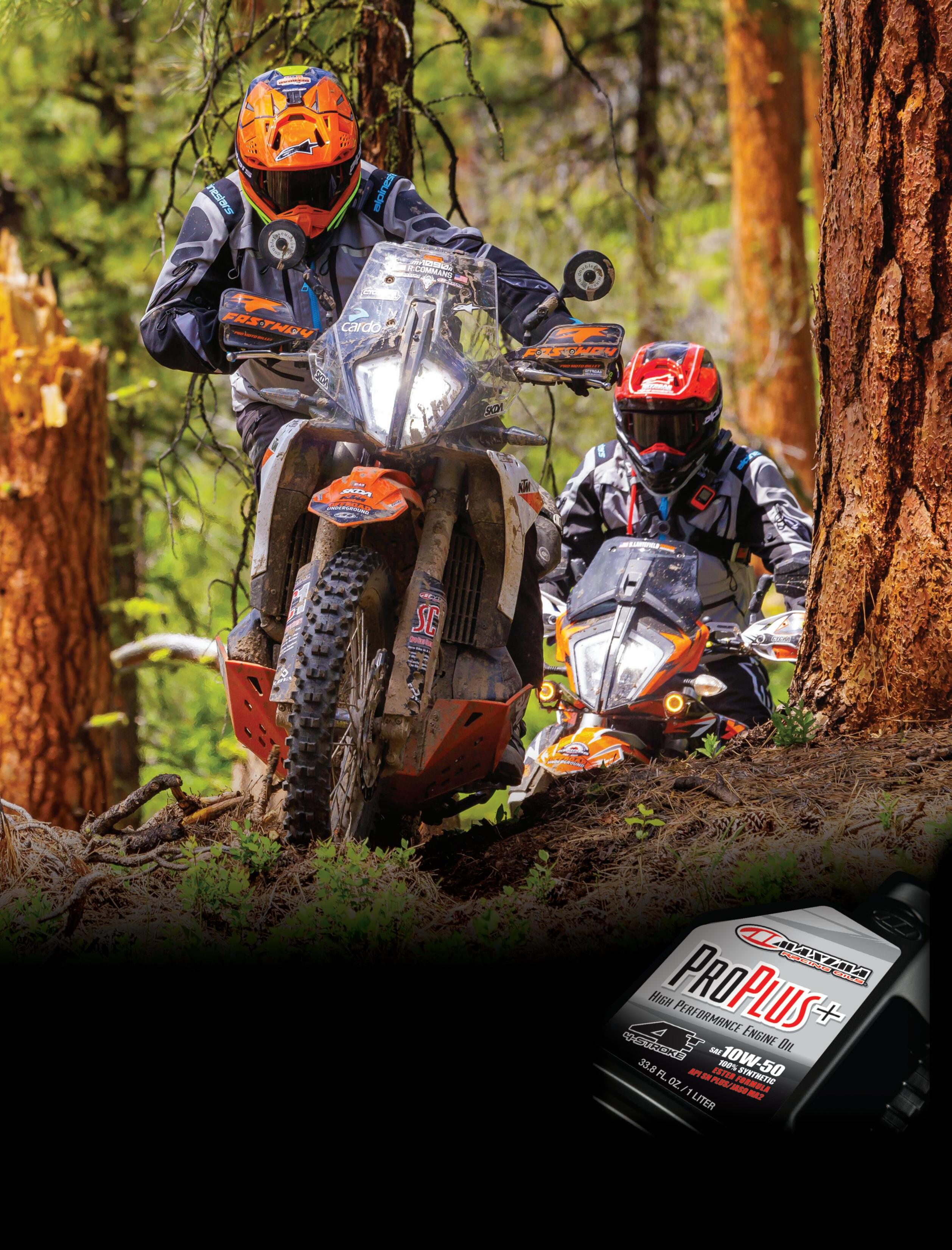


CANADIAN MOTORCYCLE HALL OF FAME
CLASS OF 2023
Established in 2006 by Bar and Hedy Hodgson, the Canadian Motorcycle Hall of Fame (CMHoF) was created with a goal of preserving the history of motorcycling in Canada while recognizing individuals and organizations that have made significant contributions to the industry, sport and the overall profile of motorcycles within the country.
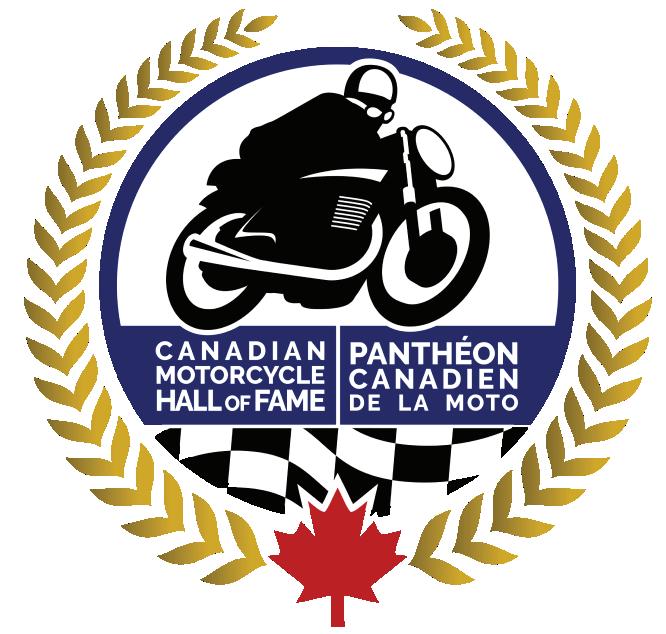
As of last year’s class of 2022, 165 motorcyclists and organizations have been inducted into the CMHoF since its inception, representing competitors, team members, competition contributors and motorcycling contributors. With names like Trevor Deeley and Blair Sharpless who were part of the original class of 2006 to the most recent inductees such as Paul Fournier and Helene Boyer, each and every member of the Canadian Motorcycle Hall of Fame is an icon in their own right.
In addition to the annual inductees, the Bar and Hedy Hodgson Award is presented to a person, group or organization in recognition of their efforts to preserve motorcycle heritage in Canada. While businesses are ineligible to be inducted into the CMHoF, the Ambassador Award provides the board of directors with the opportunity to recognize the contribution if individuals who own or operate a company.
For 2023, the Canadian Motorcycle Hall of Fame will stage their induction and reunion ceremony in Toronto, the first time the event has taken place in Ontario since pre-COVID in
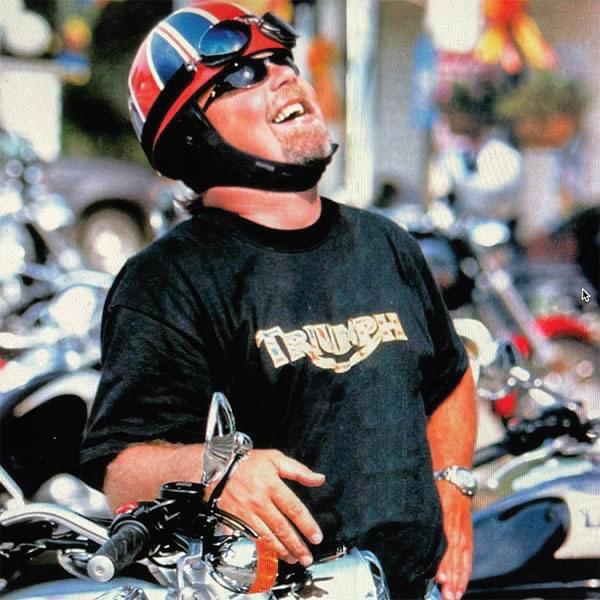

2019. Sponsored by Can-Am, the class of 2023 will be officially inducted on the evening of Saturday, November 4 at the Hilton Mississauga/Meadowvale in Mississauga, just west of Toronto’s International Airport.
In addition to the seven inductees who make up the class of 2023, this year’s ceremony will see the presentation of the Bar and Hedy Hodgson Award as well as two recipients of the Ambassador Award.
This year’s Bar and Hedy Hodgson Award, recognizing a Canadian group that has made a significant contribution to the preservation of Canadian motorcycle heritage and our heroes, is Can-Am. The company was a major player, owned by snowmobile builder Bombardier, in the two-wheeled world in the 1970s.
Can-Am continues to thrive today as a manufacturer of performance three wheeled machines, celebrating their 50th anniversary in 2023. As well, Quebec’s Can-Am has announced plans to return to motorcycle production with an electric design, and prototypes of these machines have been shown to the public.
The 2023 Ambassador Award winners are Chris Ellis and Bob Ramsay. Ellis, who died unexpectedly in 2021, was a well-known and popular figure in the Canadian two-wheeled community for his whole life. A successful racer of many disciplines who loved dirt track oval competition, Ellis was a dealer principal at Twin City Cycles in Waterloo and then Central Ontario Cycle.
WITH FILES FROM THE CMHOF AND COLIN FRASER
Can-Am celebrates its 50th anniversary, marking a rich history of innovative motorcycles including this Can-Am 500 cc prototyoe works machine seen here at Atlantic Motorsport Park in 1975. Photo by Bill Petro.
38 Inside Motorcycles
Known and loved for his personality and passion for everything on two wheels, Chris Ellis was the general manager and driving force behind the Triumph brand in Canada.
Best known as the Canadian face of Triumph, he was their General Manager of operations in Canada from 1999, early in Triumph’s return to the marketplace. Ellis was an active rider of all kinds of two wheelers, and motorcycling was certainly a true love.
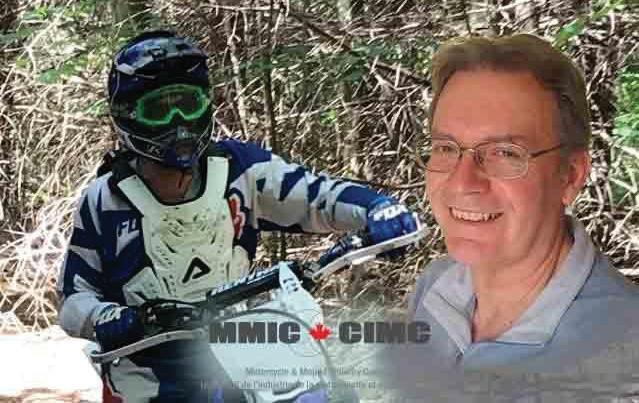
Fellow Ambassador Award recipient Bob Ramsay knew Ellis well, and Ramsay’s role was one of major responsibility, if somewhat behind the scenes. Ramsay led the key business managing Motorcycle and Moped Industry Council from 1984 until his retirement in December of 2021. He was President of the MMIC, Canadian Off-Highway Vehicle Distributors Council (COHV) and show-running Power Sports Services for 34 years.
Bob and Chris have each left their mark on the Canadian motorcycle industry, providing a framework for those who follow in their footsteps as well as true examples of the positive impact of hard work, dedication and passion.
Of the seven individuals being inducted into the CMHoF in 2023, Jordan Szoke and Greg Williams are principally regarded as champion competitors.
A legendary racer who is still active in Superbike competition, Szoke has an incredible 14 overall premier national Superbike crowns to his credit, as well as a host of titles in support classes and other disciplines such as trials. Szoke started racing in his early teens, and by 1997 had graduated to the Pro Superbike ranks, earning a podium in his second ever national feature start
in the rain at Ontario’s Shannonville Motorsport Park.
Despite suffering a potentially career-ending injury while riding motocross prior to the 2022 season, Szoke returned to road racing action for the 2023 season aboard a Canadian Kawasaki Motors supported ride.
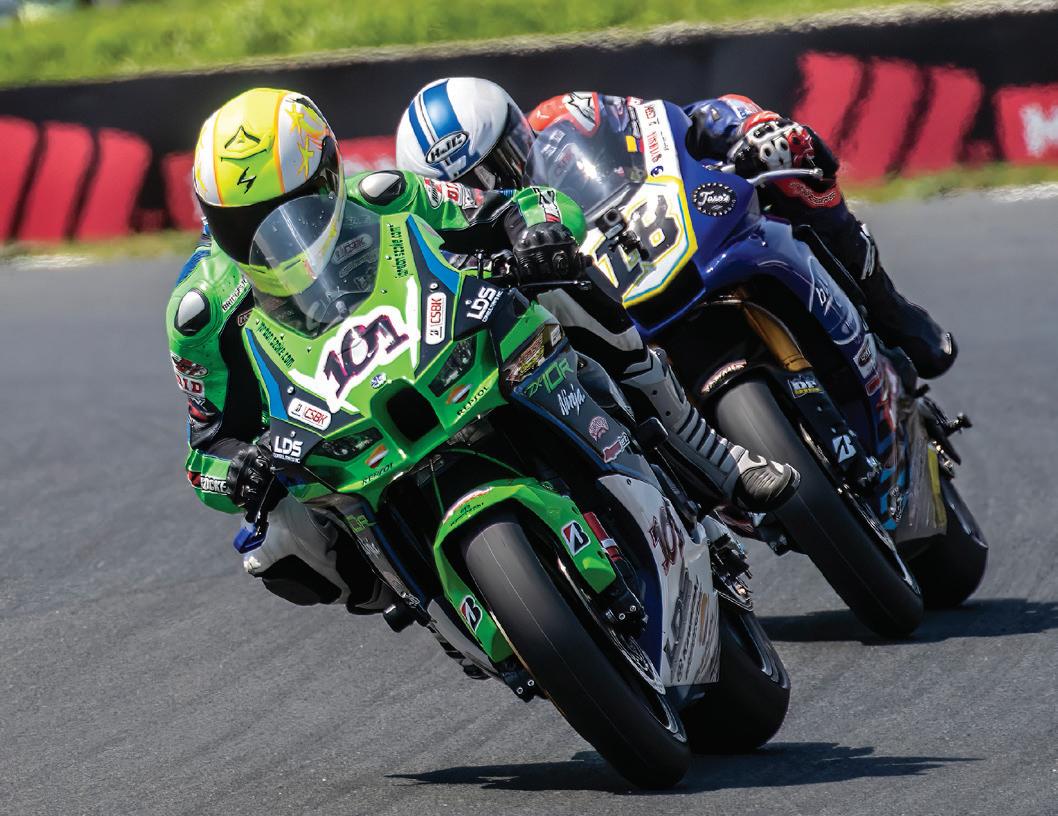
Greg Williams competed in top level hill climbing in both the US and Canada as part of the Williams hill climbing team dynasty started by father John. Greg earned four world championships in action on the nitro-fueled, long wheelbase, monster racers and joins both his father (class of 2009) and brother Wade (class of 2019) in the Canadian Motorcycle Hall of Fame.
The Contributor category recognizes the accomplishments and impact of the work of individuals and organizations from industry, media, advocates and volunteers. Dave Lloyd, Bill Jamieson and Colin Fraser are the inductees in the Contributor category.
Lloyd was a major supporter of the Canadian Motorsport Hall of Fame, which is famous for its black-tie induction events in downtown Toronto. A former road racer, Lloyd worked in marketing for the CASCAR national stock car series – now the Pinty’s NASCAR Canadian tour. With friends Bar and Hedy Hodgson, Lloyd was a key influence in the early days of the Canadian Motorcycle Hall of Fame.
For
Jamieson, the running of the famous Belleville, ON Norm Carr Memorial flat track national was central to his time in
Bob Ramsay dedicated 34 years to the development of the Canadian Motorcycle industry as the president of the MMIC, COHV and Power Sports Services.
InsideMotorcycles.com 39
Competing in the Pro Superbike ranks since 1997, Jordan Szoke (No. 101) remains a front runner in the CSBK more than 25 years later.
CLASS OF 2023
charge of the Bayside Trail Blazers (BTB) organization, from 1974 through 1980. The Norm Carr race was a major fixture in this time period, with top Americans attending the busy half mile. As well, Bill was the point man for the purchase of the land adjacent to CSBK venue Shannonville Motorsport Park. Known as Trail Blazer Park the facility features an oval flat track, motocross track for multiple skill levels and cross-country single-track trails and plays host to multiple events throughout the season.
A photography and journalism student in the late 1970s, Fraser got involved with Cycle Canada magazine and found additional work with various media and marketing tasks at Shannonville Motorsport Park, including the 1981 start-up sanctioning group RACE. From there, Fraser road raced as well worked for a wide range of sanctioning groups and television broadcasters in the US and Canada, and was in on the ground floor with Inside Motorcycles. Fraser recently sold his company, Canadian Superbike Championship organizers and TSN broadcaster Professional Motorsports Productions to former racer Ross Millson; however, Fraser will remain involved as an executive producer with the Bridgestone CSBK national championship tour.

Oakville, ON’s Robert Fisher was a key Competitor and Contributor, as the category is named, in the early days of what eventually became motocross. Ontario MX champ in 1969,
“Fish” moved on to ride enduros for Kawasaki, impressively making it to Spain for the ISDE in the same year, earning a silver medal. In early 1971 he was invited to work in Quebec on a new concept of dirt bikes, Can-Am.
While working in Research and Development in Vallencourt, Fisher continued his premier ISDE participation, earning one gold, two silver and two additional bronze medals. He also led the project that produced the famous 250 cc bikes for the British and Belgium armies, and is now recognized as a “Can-Am legend.”
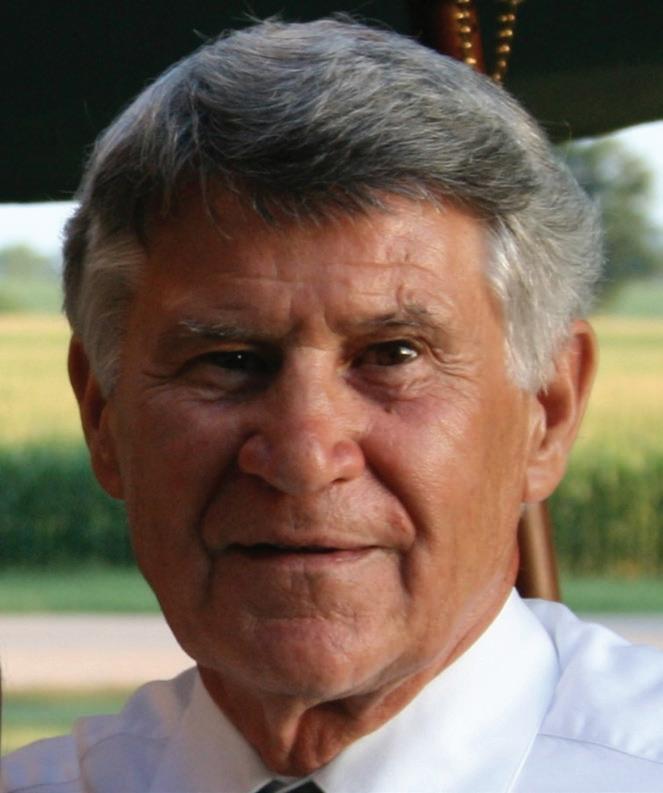
Also entering the CMHoF in the Competitor and Contributor category is one of Fisher’s Can-Am co-founders, Dave McLean, who was busy in late 1971 with the build of Can-Am number one. A lifelong motorcyclist and bike lover, McLean worked alongside Fisher and fellow Can-Am legend Gary Robinson to test and develop the Canadian brand, the fastest machine of that early 1970s era.
No story could be a better fit for the Canadian Motorcycle Hall of Fame than Quebec builder Can-Am, and the full spectacle of the company and its dedicated staff will be celebrated, along with these other standout individuals, west of Toronto on Saturday evening, November 4.
Additional information and tickets for the 2023 Induction Banquet and Reunion are now available online by visiting www.cmhof.ca. IM
Working with Bar and Hedy Hodgson, Dave Lloyd was instrumental in the development of the Canadian Motorcycle Hall of Fame.
As the founder of CSBK, Colin Fraser, seen here en route to winning the Vintage race at Daytona in March 2004, has impacted the careers of countless Canadian road racers while developing the country’s national series.
40 Inside Motorcycles

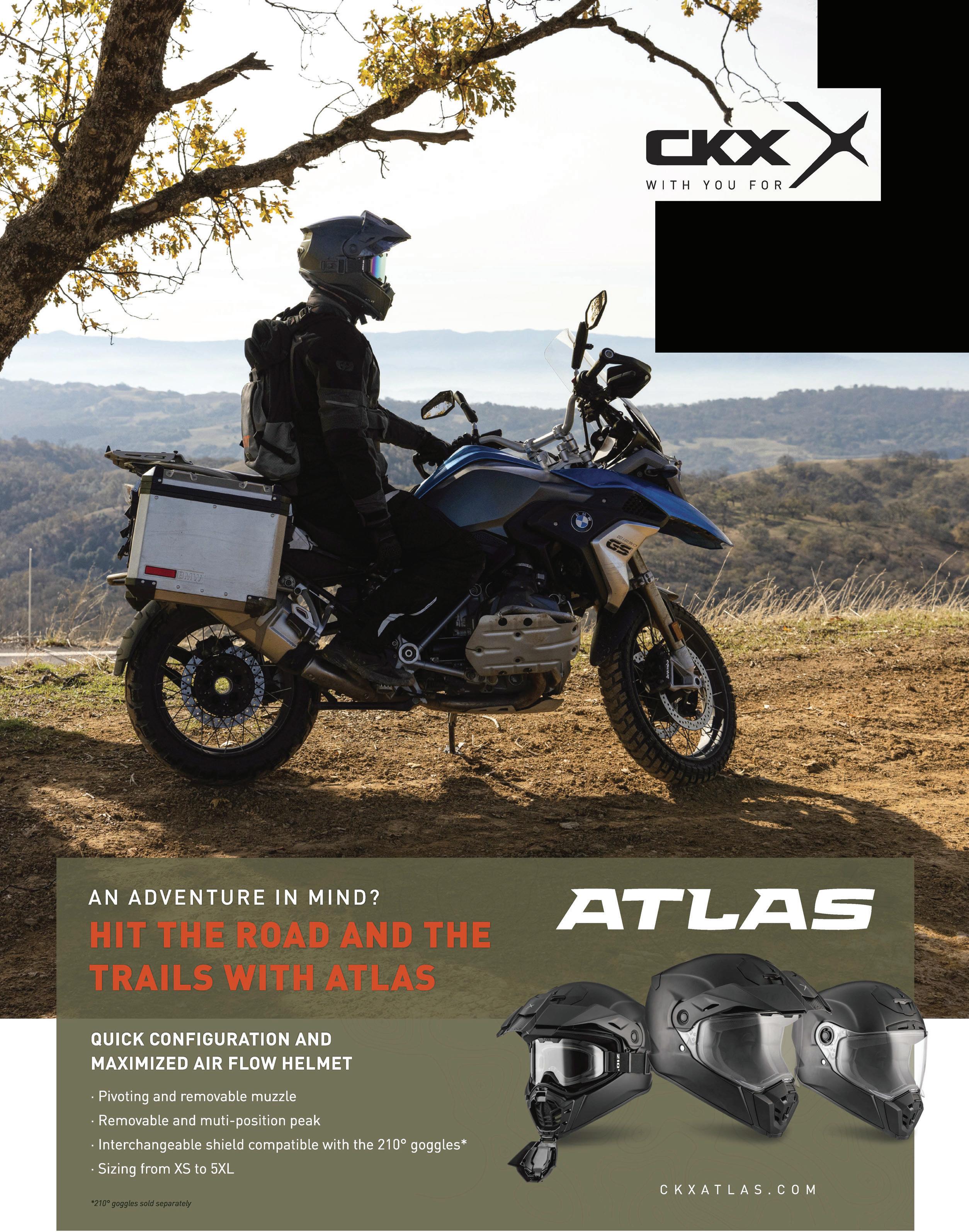
THE RIDE CKXGEAR .COM
Riding Vancouver
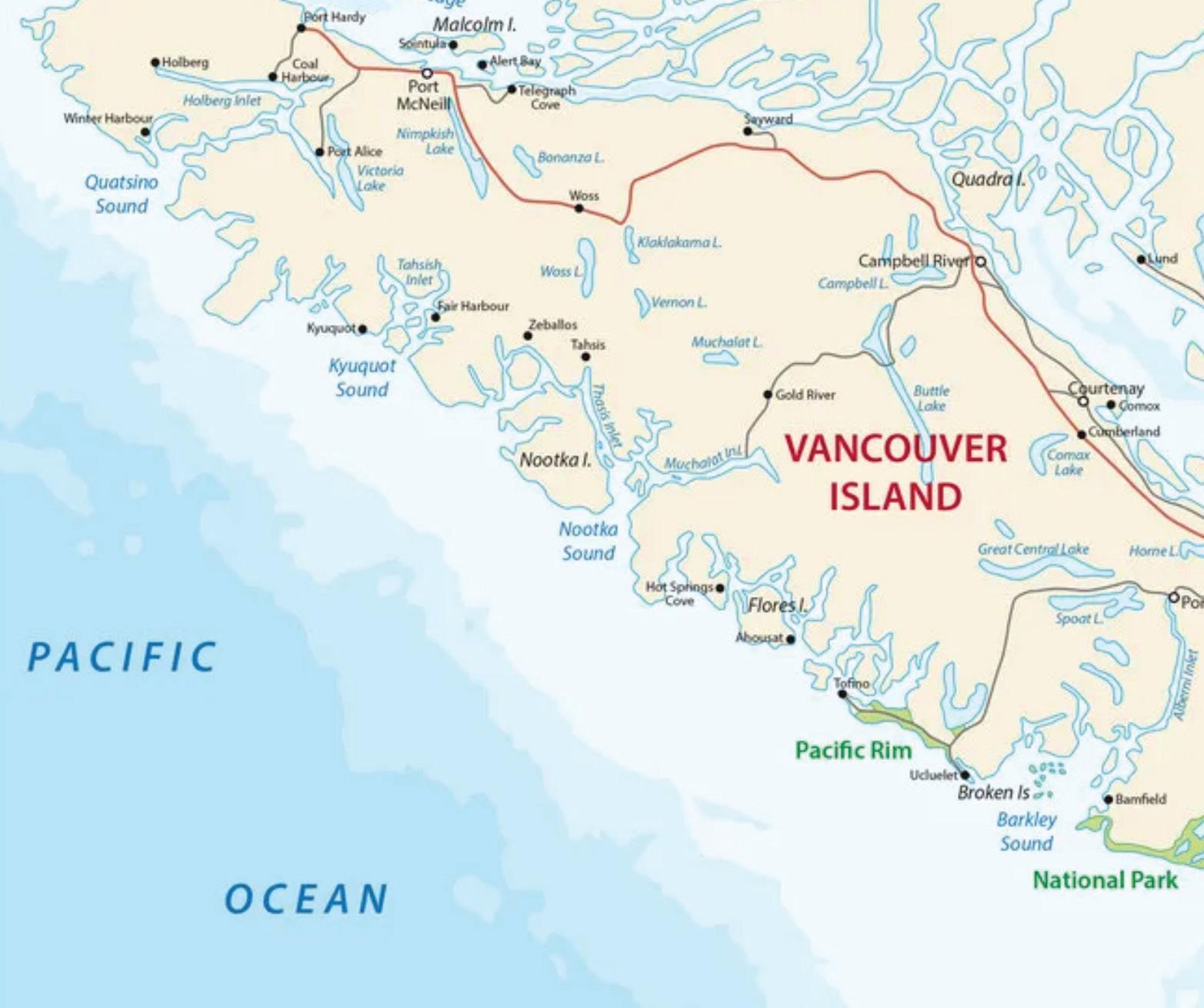
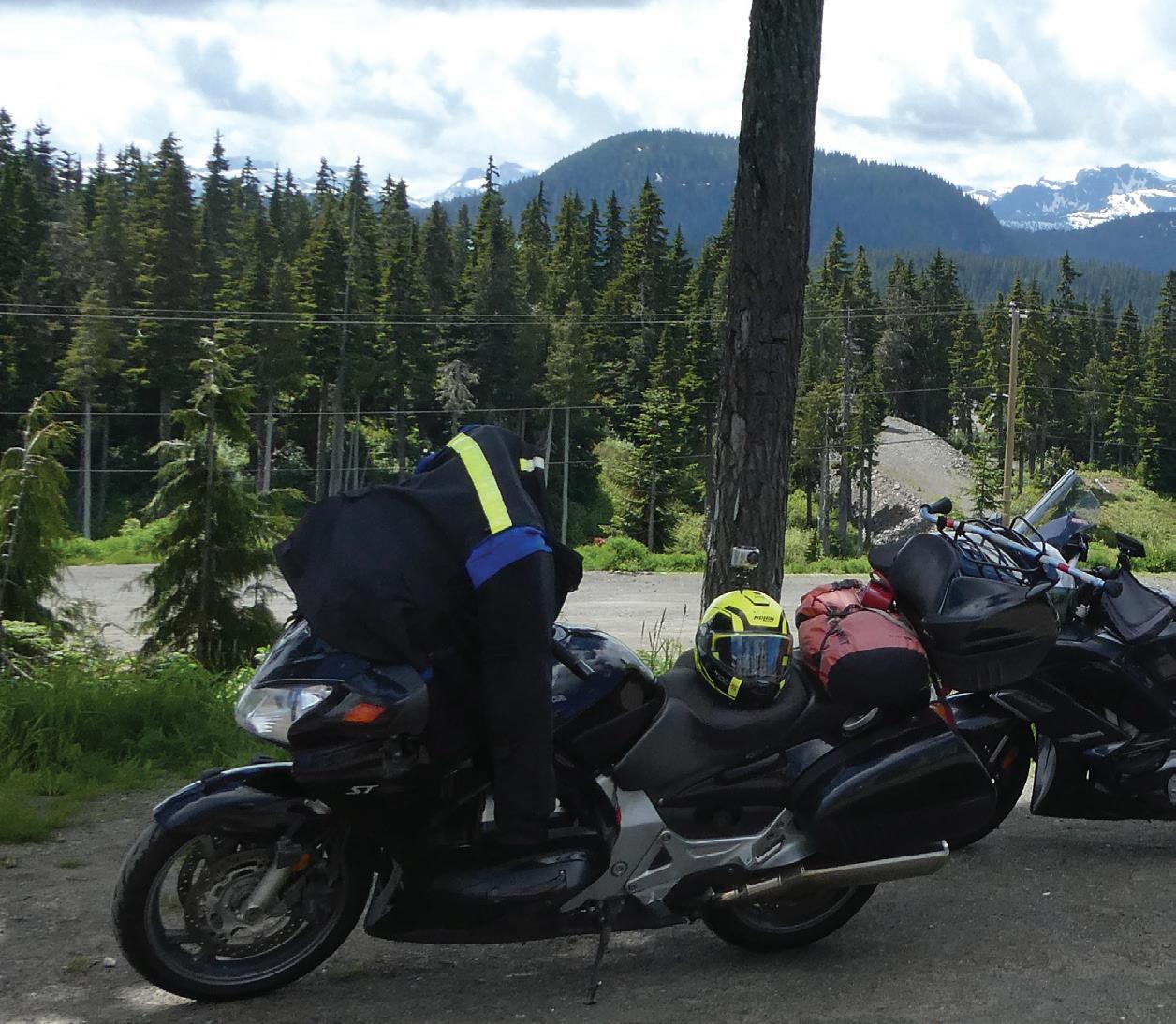
Good friends, sun, water, distant mountains. Island life at its Shelter Point best!
Taking a break at the Mt. Washington Ski Resort.
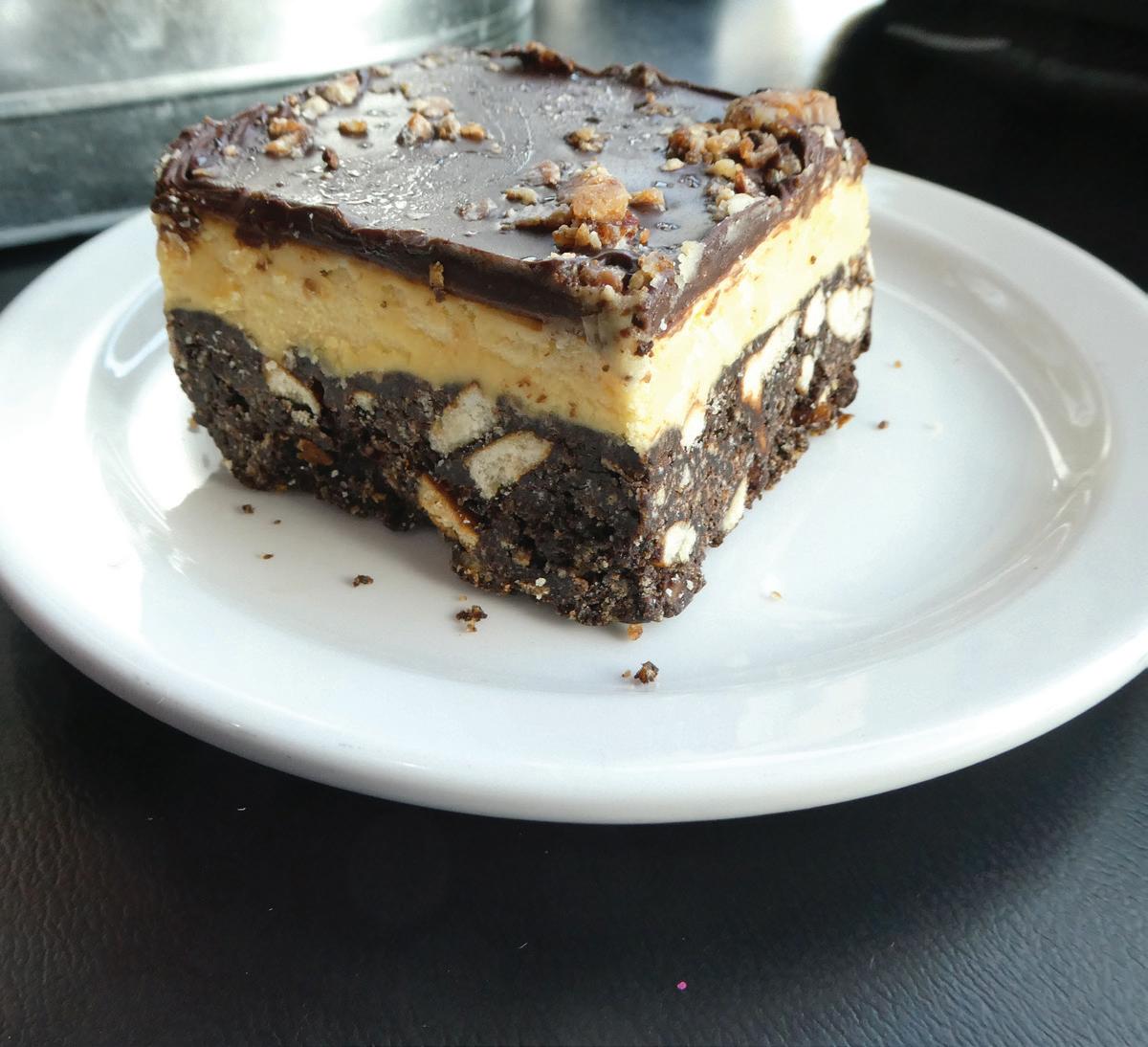
You know you’re on Vancouver Island if the Nanaimo Bar has bacon on top. 42 Inside Motorcycles
Island
“These are the days you look back on in February,” said my riding buddy Don as we admired the view of the Coastal Mountain Range on the far side of the Strait of Georgia. It was a gorgeous day and Don was absolutely correct; especially because this trip had been 14 years in the making.

Back in 2008, one of the ladies where I was working returned from a vacation in Canada’s westernmost province and presented me with a copy of British Columbia Magazine because the line above the front cover masthead proclaimed: “VANCOUVER ISLAND’S BEST MOTORCYCLE RIDES.” Surprisingly, the “best” rides were just short summaries in a series of sidebars to the main article which focused on a group of five riders participating in the first Iron Butt Ride on Vancouver Island. I still have the magazine and my wife and I have wanted to get out and explore the Island ever since, but on a more relaxed schedule.

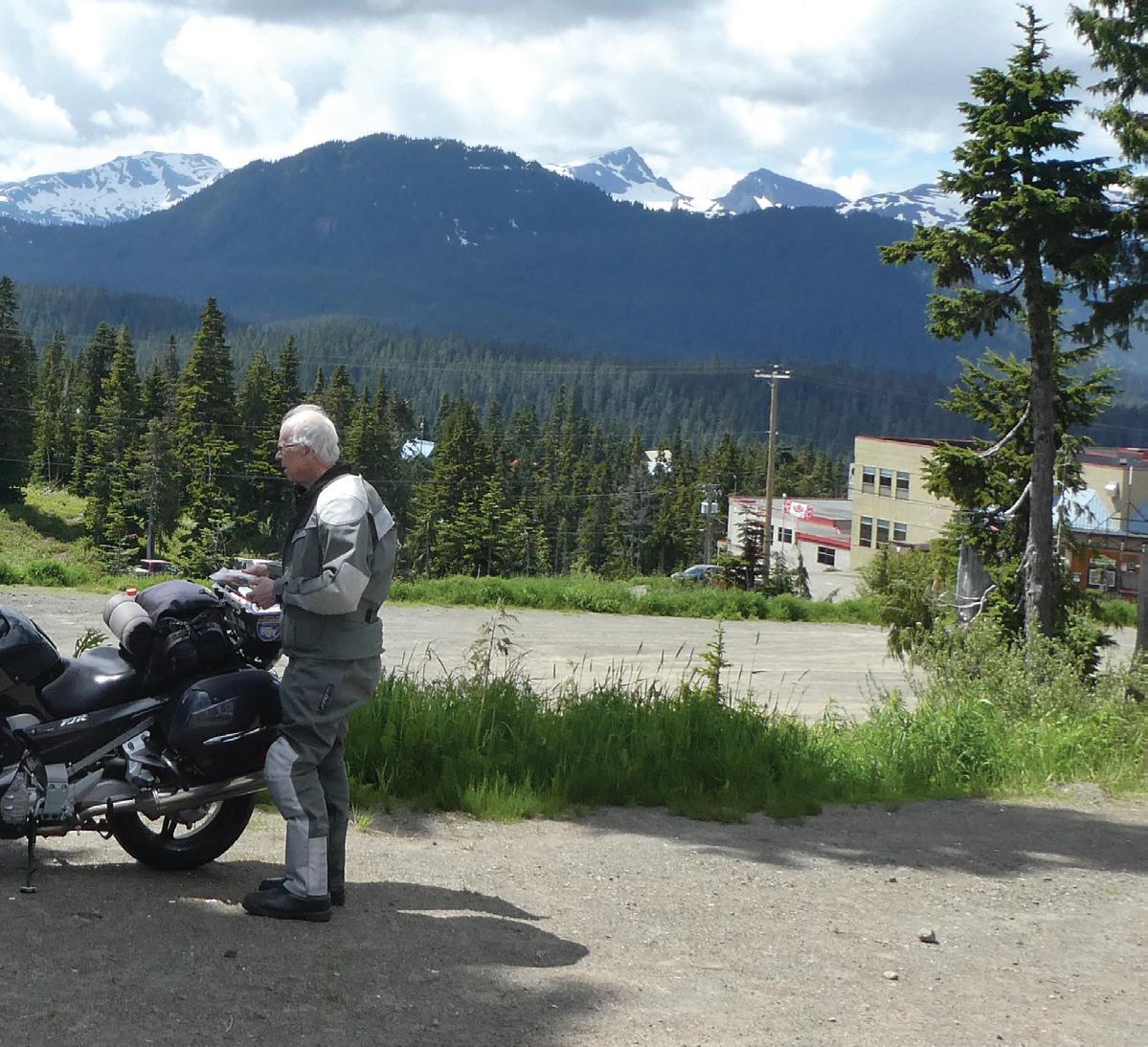
Mary and I did get out to the Island in 2013 for a rally based in Sooke, during which we rode from Sooke to Port Renfrew and on to Lake Cowichan with a small group of friends before reversing course, stopping for a group photo at the giant Harris Creek Sitka Spruce Tree. We also spent a day in and around Victoria, but otherwise did not see much of the Island. Sooke to Port Renfrew had been one of the best roads highlighted in the magazine while the route from Port Renfrew to Lake Cowichan, which had been gravel until 2012, now forms part of the Pacific Marine Circle Route through Victoria making it one of the few non-dead-end routes on the Island.
In 2022 a couple things conspired to make a trip to the Island inevitable. First, Don and I were participating in the Team Strange Grand Tour for 2022 which required getting a photo of your bike and GT flag with steam locomotives, of which there are numerous on the Island.
The other big reason to head to the Island in 2022 was the fact that Don had recently passed along his copy of Destination Highways British Columbia which details the best 185 roads in southern BC. Amazingly, 14 of the top 100 Destination Highways rated rides are on Vancouver Island, including two of the top 10. Over the years I’ve ridden the other eight top 10 routes on the mainland and wanted to cross the last two off my to-do list.
Don and I gave ourselves a week to cover the ground we had to with two days travel in each direction and three days on the Island. Day 1 took us from Edmonton to Valemount, BC where we enjoyed a great dinner at the Caribou Grill – a favourite dining spot for Don and his wife on previous trips. Travel on day 2 was affected by numerous construction slowdowns due to the Trans Mountain Pipeline work on the way to Kamloops. We headed south from Kamloops to Merritt where, in order to avoid the rebuilding efforts on the southern portion of the Coquihalla Highway, we turned east and took the more entertaining Hwy 5A to Princeton and then Hwy 3 and Hwy 1 to Abbotsford. After spending a night at my sister’s place in Mission we caught the ferry at Horseshoe Bay. Since the trip across the Strait of Georgia to Vancouver Island is relatively calm, wedge blocks are provided on the ferry to brace your bike
InsideMotorcycles.com 43
Even on a cool cloudy day there are plenty of surfers at Cox Bay.

Serious roadwork making future trips to Tofino safer.

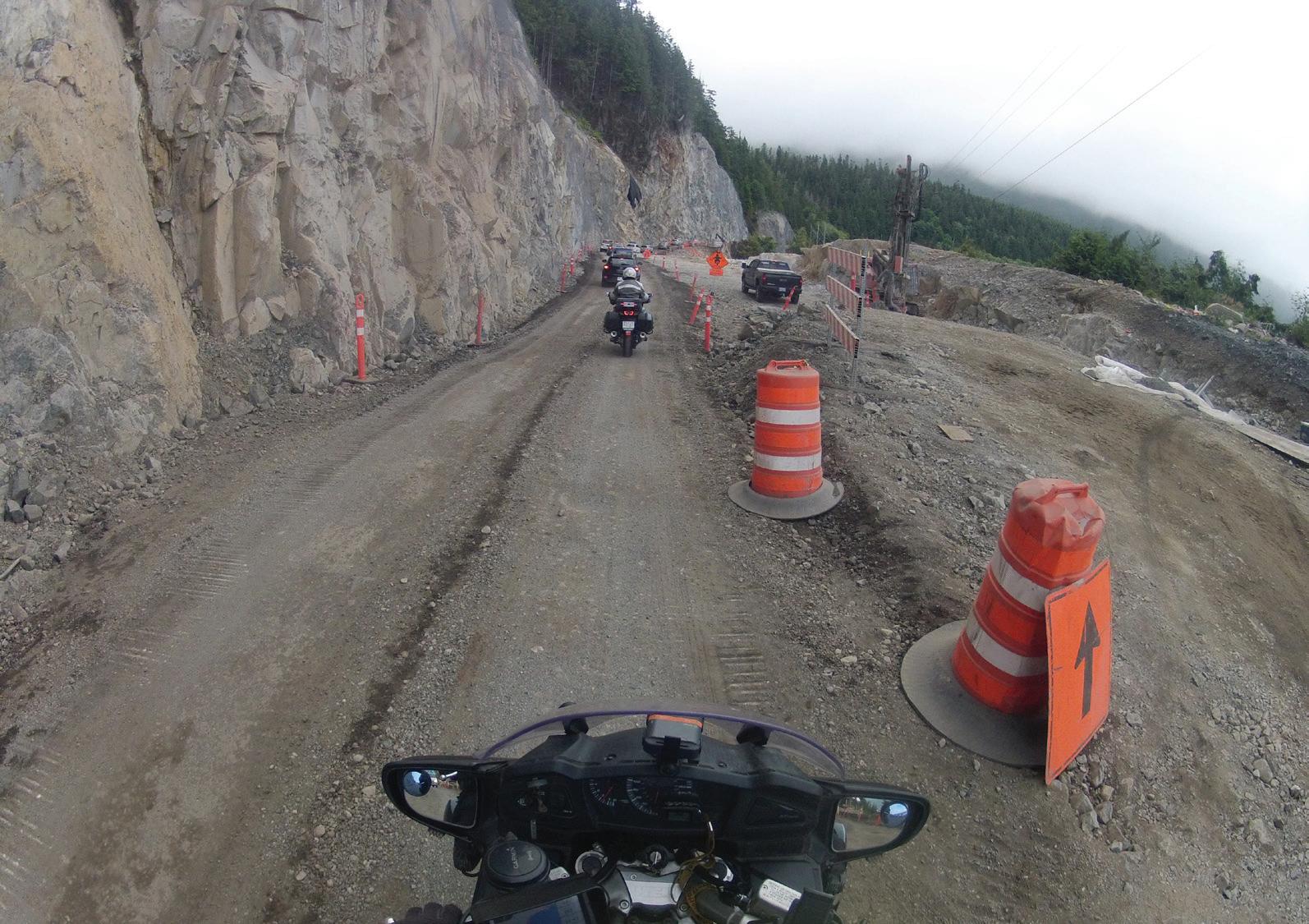
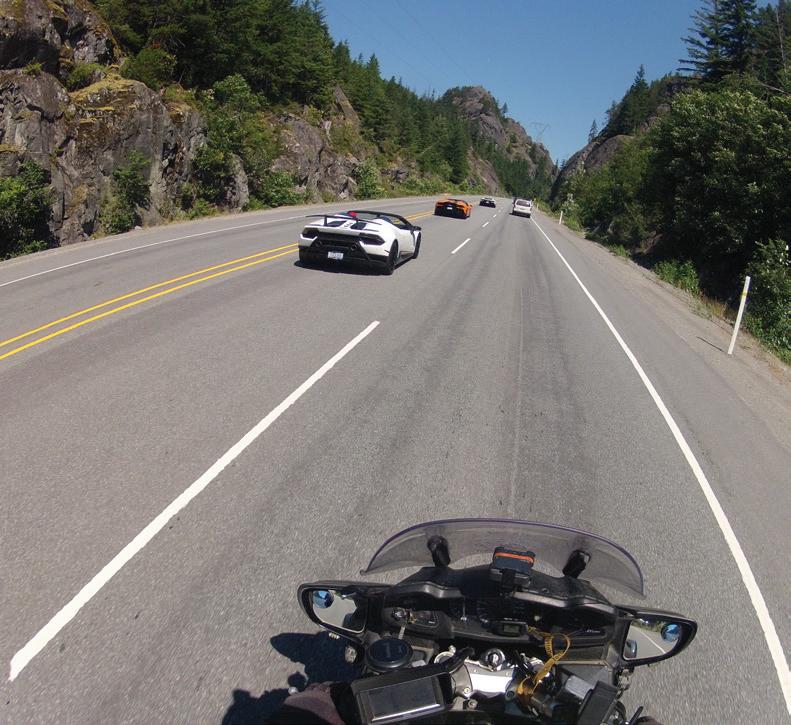

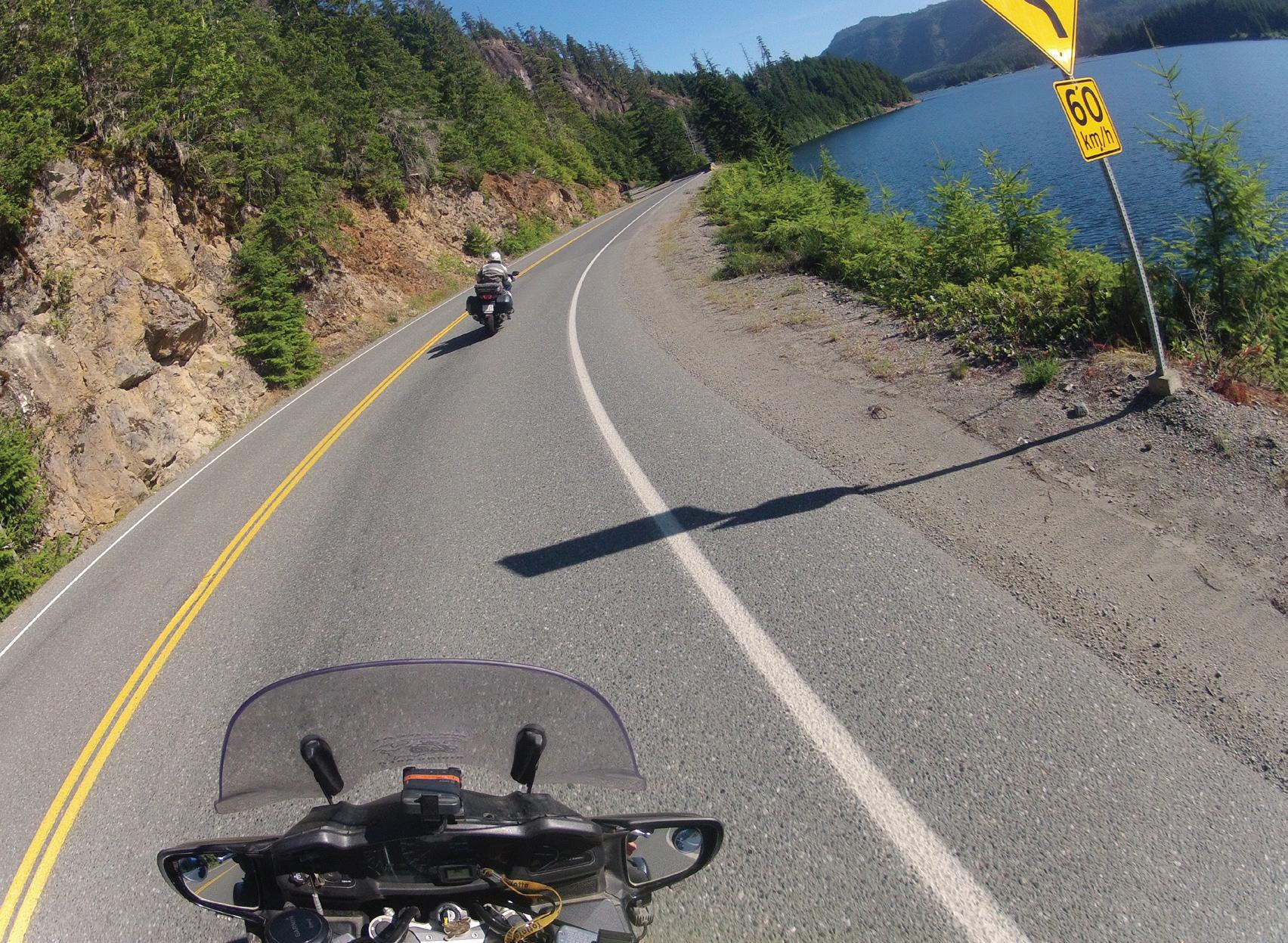 Hwy 28 hugs the shore of Upper Campbell Lake on the way to Gold River.
Mixing it up on the Sea to Sky Highway with seven Lamborghini was a highlight.
BC Ferries provides wedge blocks to stabilize your bike while crossing the Strait of Georgia.
Hwy 28 hugs the shore of Upper Campbell Lake on the way to Gold River.
Mixing it up on the Sea to Sky Highway with seven Lamborghini was a highlight.
BC Ferries provides wedge blocks to stabilize your bike while crossing the Strait of Georgia.
44 Inside Motorcycles
There are some very large trees at Cathedral Grove.
rather than having to use tie-down straps.
As luck would have it, we got to Nanaimo to find that our first locomotive target was nowhere to be found, having been moved for construction of a residential high-rise. After pointing our bikes north on the four-lane Inland Island Highway we discovered we were just in time for rush hour traffic and, while the locals like to say they live on “Island time,” being stuck in traffic on a hot afternoon proved the minutes drag on just like anywhere else. The day did end on a high note when we nabbed photos of the steam locomotive a few blocks from our hotel in Courtenay.
Taking advantage of the fact that we were still operating on Alberta time, therefore an hour later than it was on the Island, we hit the road at 8 a.m. the next morning and headed for Gold River via Hwy 28 from Campbell River. Over the course of 86 km the road skirted the edge of Upper Campbell Lake, bisected Strathcona Provincial Park and followed the course of the Elk and Heber Rivers while maxing out at 350 m above sea level. I’m
in Parksville so we thought we could make Saturday a little easier by getting our Lake Cowichan locomotive picture now. This turned out to be a great decision as our Saturday schedule was predicated on extra bonus points for a running steam locomotive at the BC Forest Discovery Center (BCFDC) in Duncan. We stopped at the BCFDC to verify the locomotive would be operating on Saturday and discovered that it was waiting for boiler certification and would not be operating for quite a while. They had a display locomotive so we got a picture with it and then headed to Lake Cowichan followed by locomotive pictures at Chemainus and Qualicum Beach.

The next morning, we departed at a normal hour and our first stop was Cathedral Grove in MacMillan Provincial Park where the Douglas firs and western red cedars are up to 800 years old. After marvelling at the size of the trees we continued along Hwy 4 to Port Alberni and the Industrial Heritage Centre but, again, didn’t get a picture as the locomotive wasn’t running due to lack of certification and was inaccessible in the shop. This failure was the low point of our day though as Hwy 4 continues past Port Alberni to Long Beach and Tofino. This was a very entertaining 88 km stretch to the Tofino-Ucluelet junction with the only slowdown being some serious road work at the east end of Kennedy Lake.
Everyone says you have to go to Tofino; it seems like everyone listens, and we had a hard time finding parking for two motorcycles. We did have a good lunch before having a look at the crowds of surfers at Cox Bay despite the cool, cloudy weather. On our return trip we stretched our legs while exploring the multi-level falls at Little Qualicum Falls Provincial Park.
not sure if it was just the early hour or not, but other traffic was non-existent and our return trip to Campbell River was just as much fun.
Wanting to avoid the expressway for a bit on our journey south we jumped onto the original Island Highway, now numbered 19A, in Campbell River and enjoyed the slower two-lane pace on our way back to Courtenay. It was at Shelter Point that we stopped for a break in the sun and Don made the comment at the top of this story.
When we got close to Courtenay, we worked our way onto Dove Creek Road which became the Strathcona Parkway after we crossed Hwy 19. The 17.5 km Parkway snakes its way up to the Mount Washington Ski Resort at just over 1,200 metres elevation and, after a lunch break, we headed back down. Enjoying the view over the Comox Valley was the only thing that slowed our descent.
It was too early to call it a day when we got close to our hotel
One of the great things about travelling is trying regional foods. For years I’ve heard people rave about the Kawarthas Northumberland Butter Tart Tour and, while they weren’t invented in that region, there are 50-plus locations spread over quite a few towns. What could be better than that? How about a Nanaimo Bar Trail, most within walking distance, in the actual city where these wonderful delights were invented! With 34 locations on the trail map (offerings include traditional, deep-fried, milkshakes, Bar-tinis and cheesecake to name a few), I knew that Don and I would have to sample something special and I chose Smokin’ George’s BBQ with their Truly Decadent Bacon Topped Nanaimo Bar. Yum!
With no more locomotives to photograph we could head straight for the ferry on Saturday morning, and being on the early boat proved beneficial to some fun in traffic. On our way towards Whistler we got to mix it up with a group of seven screaming Lamborghini that were being chased by a Tesla and a BMW. We enjoyed the Duffey Lake Road despite the 35 degree temperature on our way to an overnight in Kamloops and then home. Despite not finding the locomotives at Nanaimo, Port Alberni, and Ladysmith, the trip was a huge success. We hit all the roads on the Island we wanted to and picked up other locomotive pictures in Jasper, Kamloops, Chilliwack, Burnaby, Britannia Beach, and Squamish. Now, to get back out to the Island sometime soon with Mary. IM
InsideMotorcycles.com 45
InsideMotorcycles.com 45
Chasing Steam Locomotives, like this one at Lake Cowichan, was a big reason behind our trip to Vancouver Island.
Hester Creek Estate Winery
Experience true European ambiance at this state-of-the-art Okanagan Valley Winery
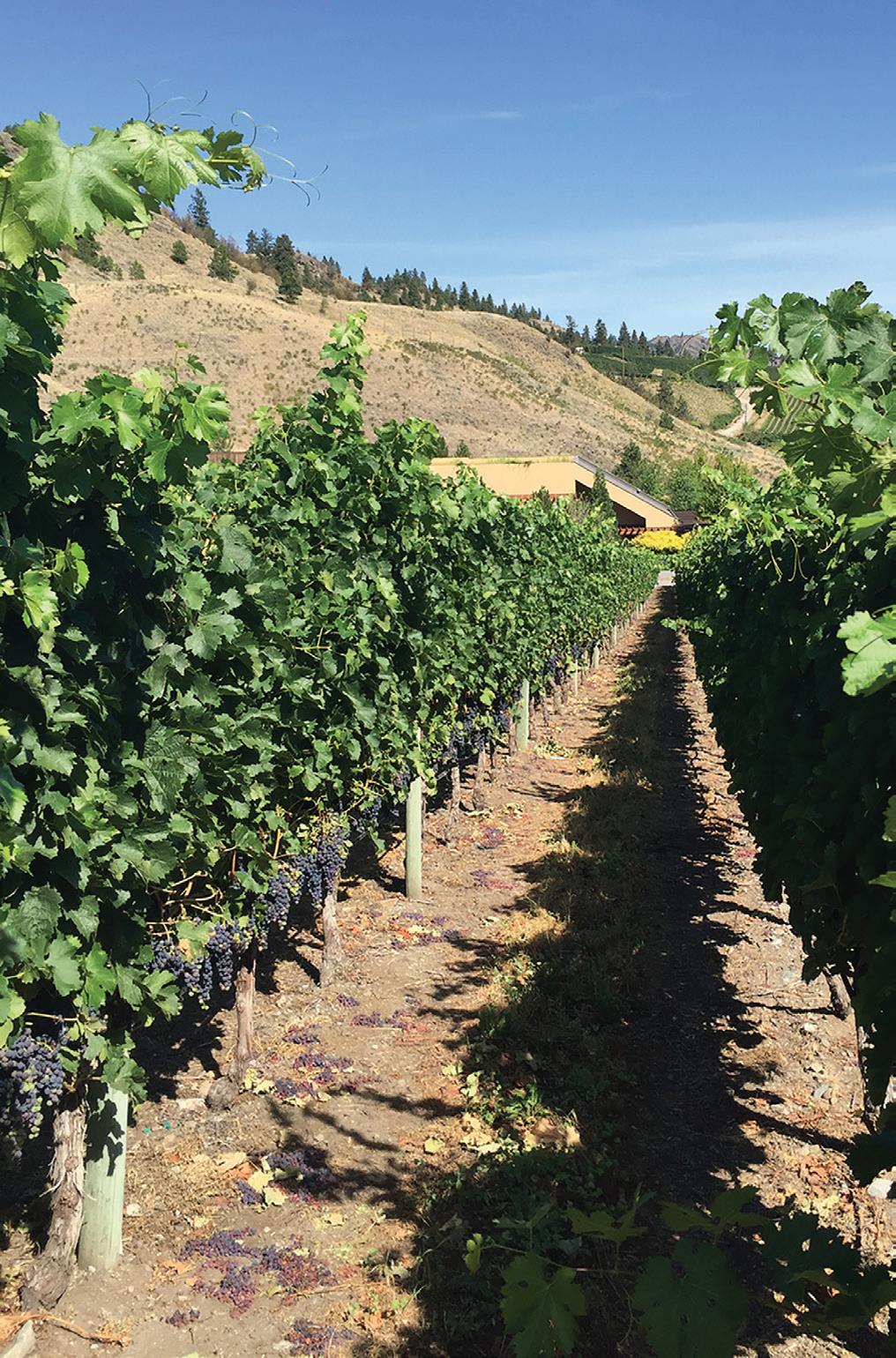
Story Courtesy Hester Creek Estate Winery

Made up of seven lakes running north to south, the Okanagan Valley was cut out by glaciers during the last ice age. At the south end of the valley lie the towns of Osoyoos and Oliver which make up the northern tip of the Sonora Desert. The temperatures are extreme, with winter temperatures dipping below zero and summer temperatures reaching 40+ degrees centigrade. These summertime highs make the climate hot and dry, creating the perfect environment for grape growing and wine production.
Nestled in the heart of this region is Hester Creek Estate Winery. The property was first purchased in 1967 by Italian immigrant, Joe Busnardo, who planted the first vines in 1968. In 2004, BC entrepreneur Curt Garland purchased the property and invested state-of-the-art technology into the vineyard and production facility. Inspired by a landscape reminiscent of Tuscany, Garland envisioned his winery as encompassing a true European ambiance, complete with warm hospitality, outstanding wines and fine dining.
Now, in 2023, Curt Garland’s vision is in full bloom thanks to the dedicated staff and loyal guests who have enjoyed all the experiences that Hester Creek has offered over the years. This year, Hester Creek was named Great Northwest Wine Magazine’s British Columbia Winery of the Year for 2023 after winning three platinum medals for their Sémillon, Old Vine Pinot Blanc and 2019 Old Vine Brut.
As Hester Creek has evolved over the years, so has the Okanagan Valley. Each summer, the valley attracts people from all over the world as a destination for wine tasting, fine dining, outdoor activities, and of course, racing up at the Area 27 Motorsports Park. The views from Hester Creek are expansive, taking in rolling vineyards, miles of orchards and the racetrack, which is located just an 11-minute drive from the winery. For those coming to enjoy Area 27, you can plan your day with a track day in the morning, followed by a tasting at the winery, then dine at Terrafina for lunch or dinner.
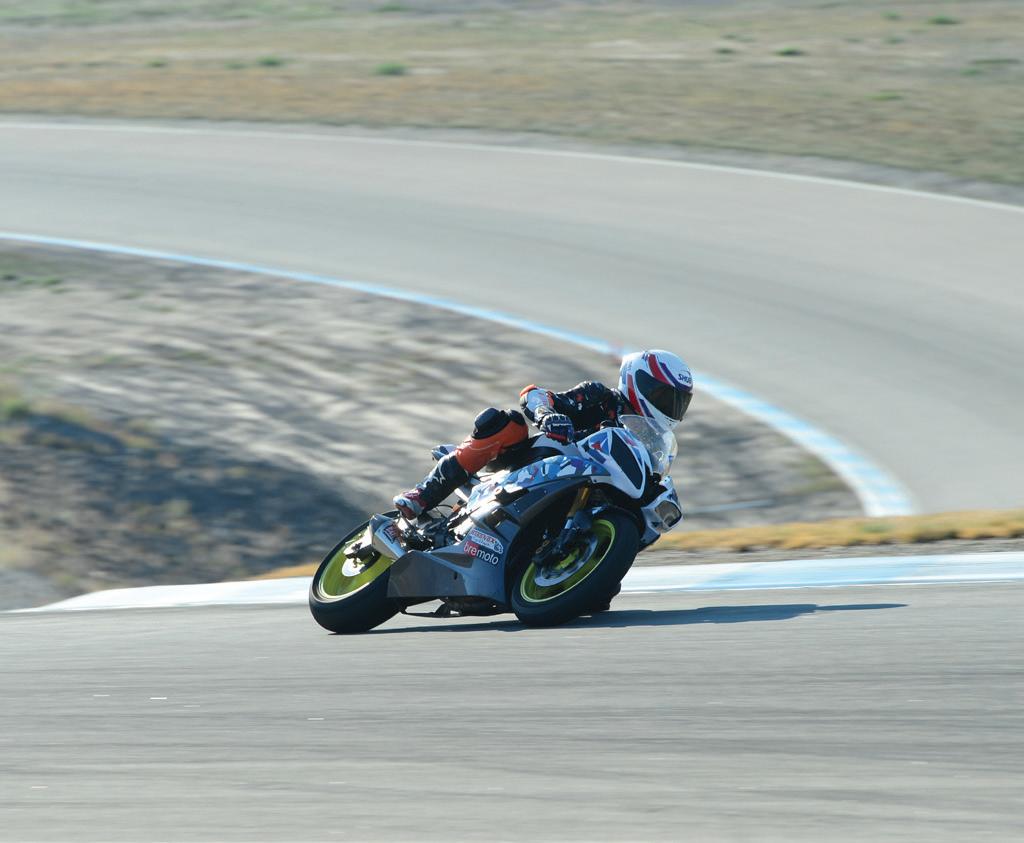
The winery itself was built into the mountainside, where the earthen roof keeps the cellar cool and is home to the natural flora of the Okanagan. In front, the winery is home to a remarkable tasting room where Wine Shop Manager, Rachel, hosts guests who feel like they’ve been swept away for an afternoon in Italy as they sip their wine and listen to live music while admiring the 50-year-old vines that adorn the property.
A pergola of intertwining vines frames the restaurant, Terrafina. Meaning, “fine earth,” Terrafina provides fine-dining experiences using fresh local ingredients – many of which come from the garden that Chef Adair Scott planted behind the restaurant in 2020. As the seasons change, so does the menu, with Chef and his team curating dishes that pair beautifully with the variety of wines that Hester Creek has to offer.
At the pinnacle of the estate stands The Villa. The six suites that overlook the valley provide some of the best views in Okanagan wine country. Villa manager, Melissa, and her team are the perfect hosts, welcoming you to your stay with a complimentary bottle of Hester Creek wine to enjoy on your private patio. Wake up to a dazzling dawn as the sun crests over the mountains, enjoy a complimentary Signature Tasting in the winery, then dine at Terrafina during the evening.
The wine is what anchors Hester Creek to its legacy. Roots run deep with old vines that produce quality grapes perfect for making award-winning wines. Over the years, Winemaker, Mark Hopley, has honed his skills in crafting an impressive portfolio of sparkling, white, and red wines using Ganimede fermentation tanks and expanding the barrel program to use predominantly French oak. Mark invites you to join one of the winery ambassadors for an Estate Tour and Tasting to learn more about the history of Hester Creek and how the wines are made.IM
 (Top) Hester Creek Estate Winery features a restaurant, and a villa with six suites that provide one of the best views in the Okanagan wine county. (Above) For racing fans visiting the Hester Creek Estate, Area 27 Motorsports Park (above) is just an 11-minute drive away from the winery. PHOTOS COURTESY HESTER CREEK ESTATE WINERY AND PATRICK LAMBIE
(Top) Hester Creek Estate Winery features a restaurant, and a villa with six suites that provide one of the best views in the Okanagan wine county. (Above) For racing fans visiting the Hester Creek Estate, Area 27 Motorsports Park (above) is just an 11-minute drive away from the winery. PHOTOS COURTESY HESTER CREEK ESTATE WINERY AND PATRICK LAMBIE
46 Inside Motorcycles
WINERY OF THE YEAR

A taste of Tuscany in the heart of Okanagan, BC
Hester Creek Estate Winery is located in British Columbia’s Wine Capital, Oliver. This is where our our roots run deep with old vines planted in 1968.






The breathtaking views, reminiscent of rolling Tuscan vineyards, encompass the historic Golden Mile Bench estate property where Hester Creek has gained recognition for its commitment to quality wines and gracious hospitality.


HESTER CREEK ESTATE WINERY
877 Road 8, Oliver, British Columbia, Canada (30 minutes south of Penticton - on Hwy 97)









ESTATE WINERY
With a world-class winemaking facility and Wine Shop, Hester Creek o ers complimentary tasting experiences and a large patio with a picnic area for friends and families to enjoy live music on weekends.

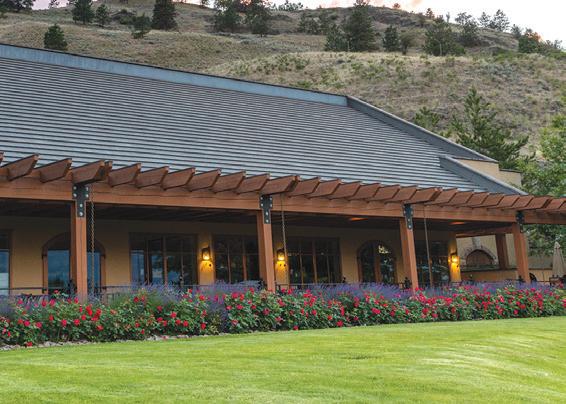
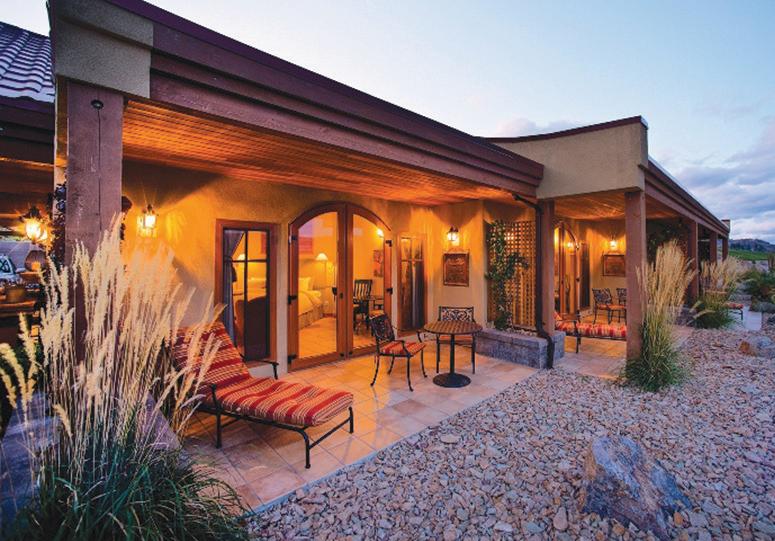
TERRAFINA




Meaning “Fine Earth,” Terra na o ers a Tuscan-style dining experience below a trellis of old vines. Inspired by ingredients from the estate garden, Chef Adair designs his menu to re ect the seasons of the valley.
THE VILLA
Situated at the pinnacle of the Golden Mile Bench, The Villa provides stunning views of the South Okanagan. Enjoy a complimentary bottle of wine on your private patio while gazing out at the miles of vineyards below.

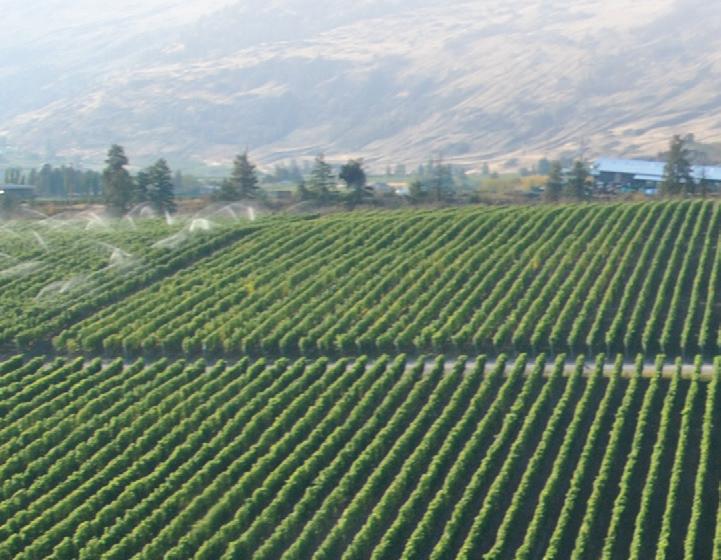
VISIT US AT WWW.HESTERCREEK.COM @HESTERCREEK @HESTERCREEK @HESTERCREEK1968 BRITISHCOLUMBIA GNWW 2023
BRITISH COLUMBIA 2023

48 Inside Motorcycles
With just three years of road racing experience, former drag racer Jordan Decarie is making waves with class titles in the Super Series as well as a podium finish in his first CSBK outing.
NEW KID ON THE BLOCK
JORDAN DECARIE
BY ALEX GALLACHER
Since 2020, the Shannonville Super Series Novice class has produced some fantastic talent amongst the 73 new riders to date. While it is usually the champion that gets all the glory during a particular Novice season, a lot of times the pool of talent is so deep that nearly the whole field becomes competitive racers.
In 2021, Tyrone Tavares claimed the Novice championship over Jordan Decarie. However, the year end points total didn’t tell the whole story. The two fought it out for the COVID-shortened three-race calendar and despite only finishing 15 points behind Tavares, Decarie kept him honest by sweeping both races on the Nelson Circuit.
It was during the 2021 season, that Super Series fans were first introduced to the No. 25 Suzuki GSX-R600 of Decarie. Since then, Decarie has seen a meteoric rise up the Canadian motorcycle ladder leading up to his Pro status debut in 2023.
Jordan hails from Barrie, ON, and has always had a love for speed. Starting out his racing journey running the dragstrip at Toronto Motorsports Park in Cayuga, he began doing track days and from then on, he knew racing was the path for him.
“I started doing casual track days as far back as 2011 at TMP,” Decarie said. “In 2020, I went to Shannonville for the first time. I met some amazing people and overall, just felt really good vibes. I felt I had an instant connection to the track, and I loved the
history. I had some great runs out on track with William Kowalczyk, and he introduced me to the Super Series race school. In 2021, I made my racing debut with a great group of novice riders and it’s been amazing ever since.”
In 2021, the Novice class had 18 other full-time debutants. Having his past experience from the school and the track days, Decarie felt he was ready for the challenge to take on a fierce crop of riders. From that inaugural year, it was like a switch flipped and Decarie steadily pushed himself to be better. The journey of a thousand miles begins with a single step, and on that summer day in June, Decarie took his first step.
“I had a lot of nerves coming into the season as we had only done one race start leading into it,” Decarie added. “Luckily for me, I had actually done a lot of drag racing during my time at TMP and I was able to do an eight second quarter mile on a bike. I was used the reaction time, but once I was on the grid in Super Series, I had to think all the way back to five years prior on that dragstrip to get that launch down. When there are 18 other guys and girls on the track wanting that same great launch into turn one, it’s a surreal feeling and you want to be that first rider there.”
Come his sophomore season, Decarie joined the even larger Sport Bike grid. Now with bigger fields and some Pro riders tossed into the mix, Decarie seemed to just naturally adjust to the higher competition and the quicker lap times.
InsideMotorcycles.com 49
In his novice year, Decarie, who rode a stock GSX-R600, kept pace with Tavares who rode a Yamaha YZF-R1. Decarie credits the battles with Tavares in Novice, as a big factor that helped acclimatize quickly to the Sport Bike division.
“It was really hard, but you got to give credit to those riders who can sling those 1000 cc bikes around a track,” Decarie said. “I’ve rode GSX-R1000s before and I tried as hard as I could to latch onto Tyrone and bit his heels like an angry chihuahua to let him know I’m there. I tried to pick up ways to make up speed, and by the time I came to the next year I knew all these different ways to gain more cornering speed and it really helped.”
By the end of 2022, Decarie had picked up two class titles being AM Sport Bike and AM Superbike. After claiming his first two Super Series titles, Decarie figured a Bridgestone CSBK debut was on the horizon. With the news that Shannonville Motorsport Park was hosting the opening and closing rounds, Decarie jumped on this opportunity.
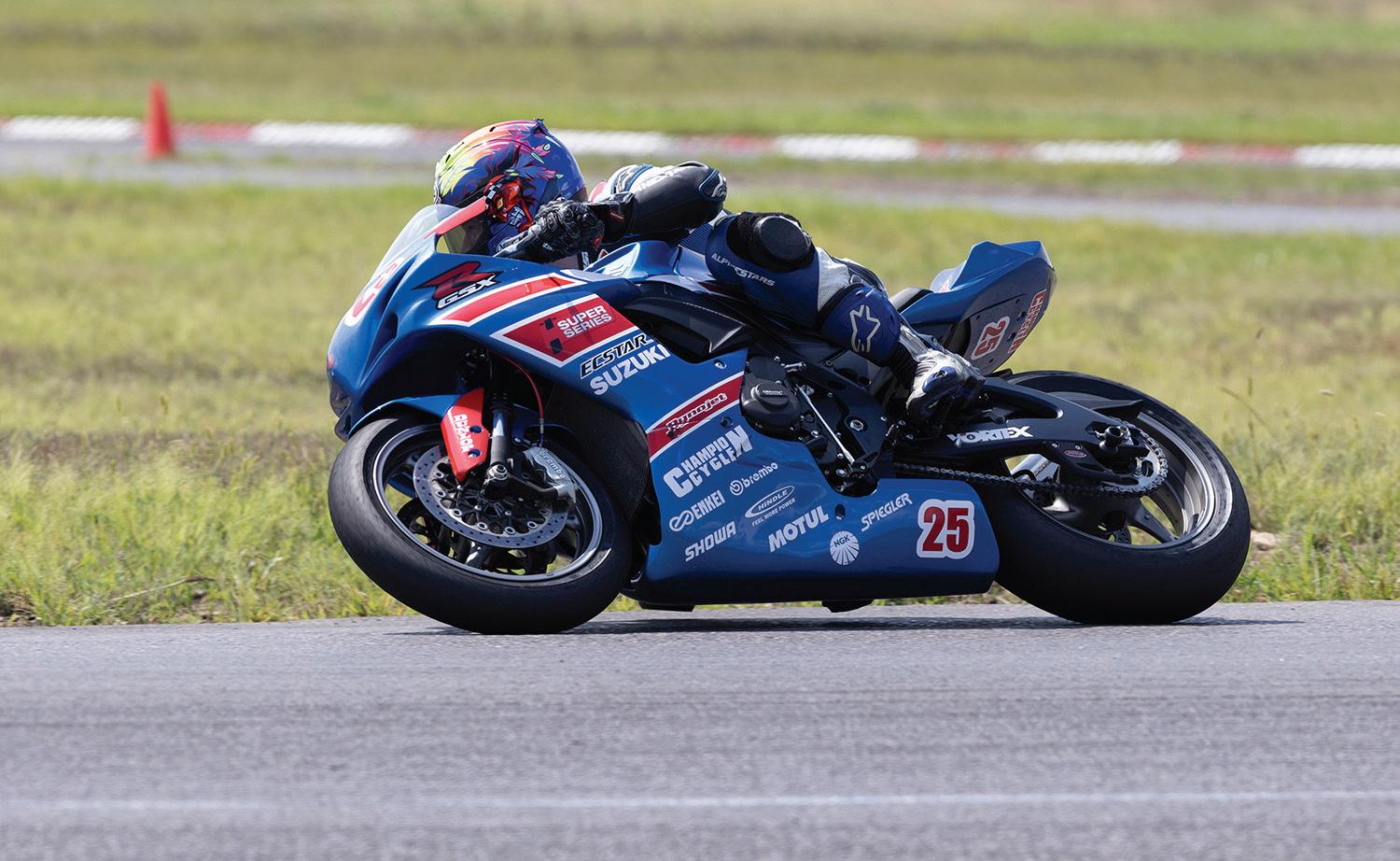
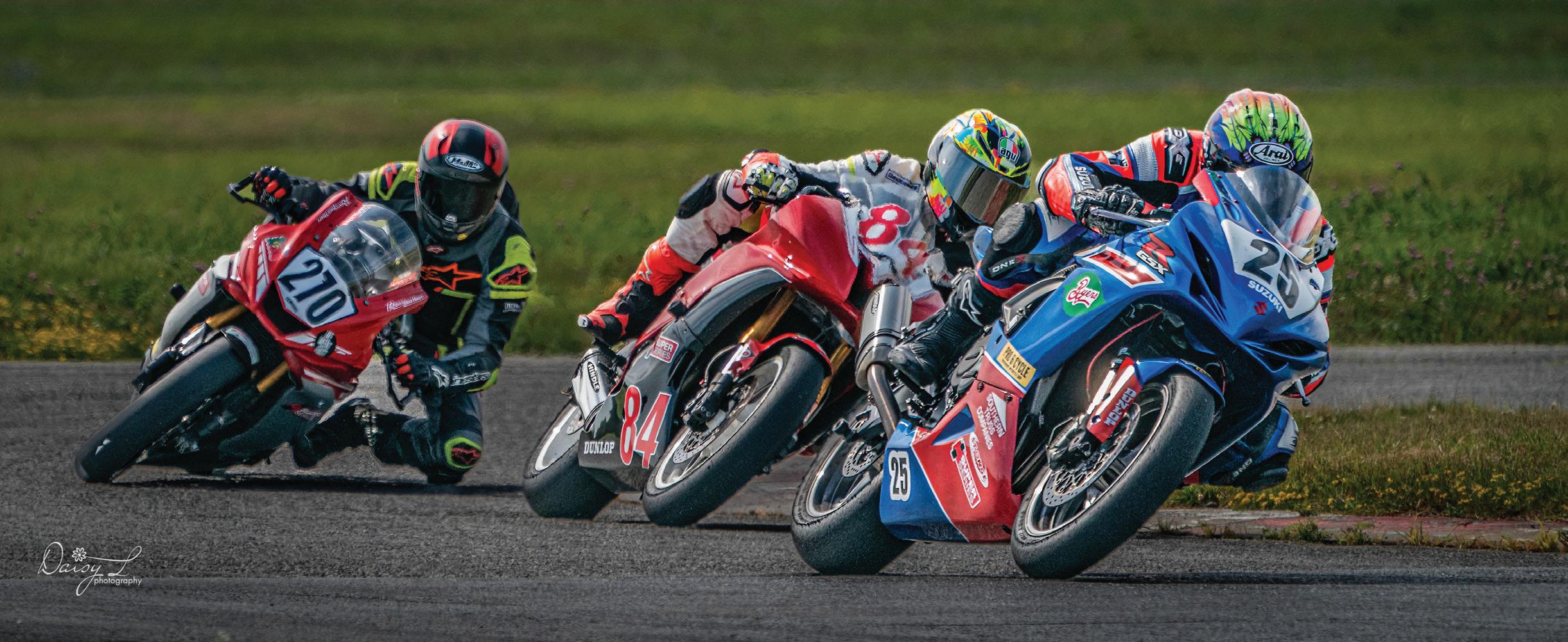
Debuting in the Amateur Sport Bike class, Decarie took on Maverick Cyr. In his only his first kick at the national level, he stunned the motorcycle community by taking a runner-up finish in spectacular fashion passing a handful of riders in one corner.
“Racing is a big mental game,” Decarie added “Even though I’m racing out on the track with all these other riders, I’m still racing against myself. Having that second place motivated me to push harder, train harder and do all those things to be at the front. In the national, I needed one or two more laps to try and close the gap to Maverick, but it was a fun experience and very different.”
All this experience has given Decarie the opportunity to perfect much of his racecraft; although Decarie has natural talent, he spends hours and hours going over footage and practicing his lines to ensure everything is at an acceptable level. While
many riders ride the edge of what is possible, pushing the limits every corner, Decarie knows his limits as a competitor. He knows his spots where he can push and the moments where he can be aggressive. The racecraft is one of the most important things a rider can master, as it usually is the difference between a smooth entry and riding a bucking bronco.
“I always try to stay within my limits,” Decarie said. “There are times to push and explore the boundaries. In the first two years I ran a stock 10-year-old Suzuki bike, since then we’ve been slowly upgrading it and doing minor tinkering to progress even more. I want to be as precise as possible and not fight the bike. If it wants to wiggle around then it can, I don’t want to fight it.”
Decarie is one of the riders that brings out a large family presence to the track whenever he can. From his wife Maggie, to his parents and in-laws, Decarie knows that as a racer his family is the most important thing to him. They have been extremely supportive over the years, even if he has made them think of a few occasions that he was a few screws short of an Ikea table.
50 Inside Motorcycles
At home on the racetrack, Decarie relishes the moments of solitude where he is able to attain absolute focus. Continued competition in the Super Series and a potential goal of racing full-time with the CSBK keep him focused when he is off the track.
Comradery and family are paramount in becoming a fast rider. While speed can only get you so far, having a great support system to help pick you back up after devastating moments is often the key to success.
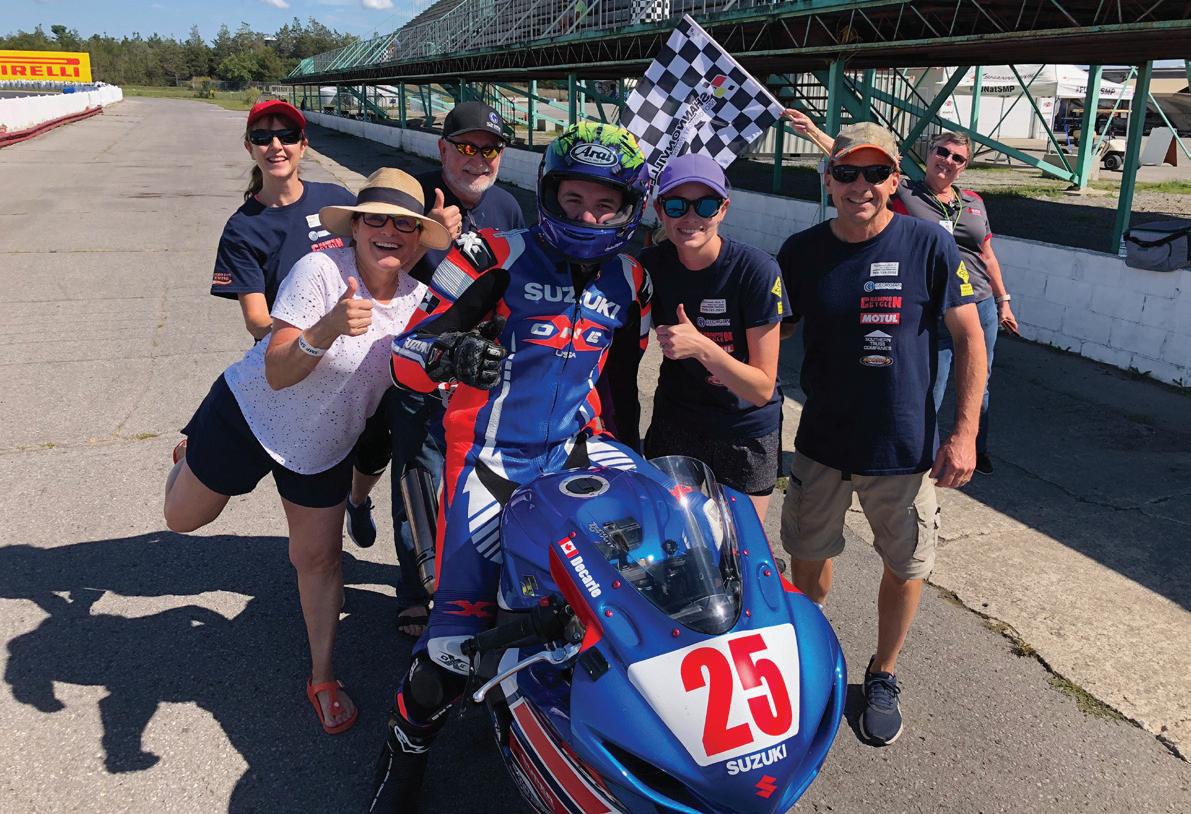
“I’ve always wanted to race, ever since I was little.” Decarie reminisced. “Whether it be dirt bikes or go-karts and cars, and when I moved out on my own, I decided I was going to give it a shot. My family has been really supportive and it’s great to have that support system. I have an uncle down in Florida and my grandparents try to get out as often as possible. I’m an only child, so it’s not like my parents can tell me they are busy going to my brother’s events. I remember my mother-in-law cried during one of my races from all the emotions and excitement. So, I really am fortunate.”
While Decarie always jokingly says his future consists of “only track days,” his main goal is to focus and to pursue his personal improvement during races and on the track in general. He wants to continue running with his comrades in the Super Series for as long as possible, and a long-standing dream to one day take on the full time CSBK schedule.

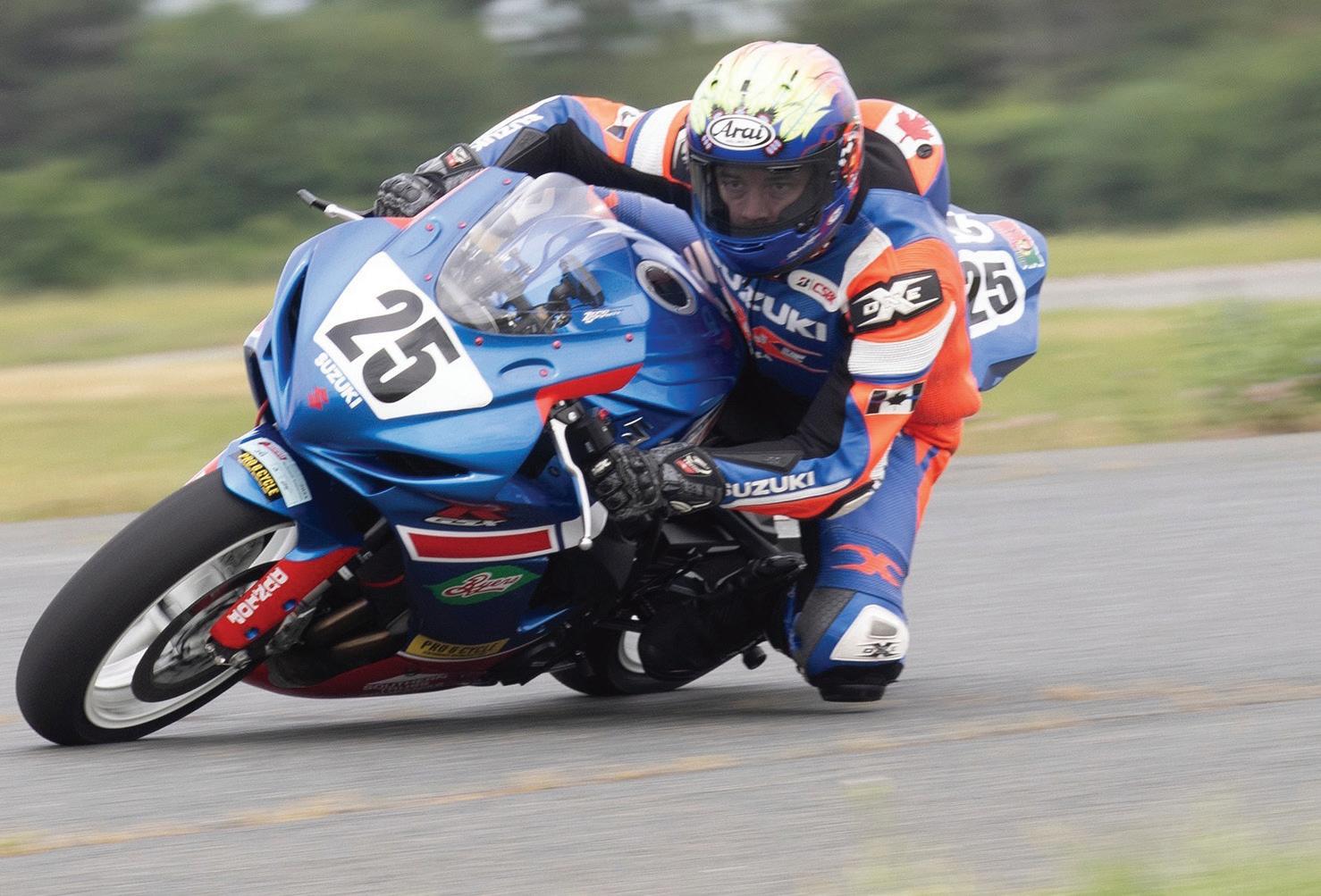
The racetrack is where Decarie feels at ease. When he is out riding, he knows that he is alone with his thoughts and the only thing he has to worry about is what corner is coming up next.
“My goal is to do this for as long as I can,” Decarie concluded. “I want to race until I can’t race no more. It’s a huge part about why I get up every day, and I know it sounds selfish but my time on the track is my time. I’m thinking about how I can be better and thinking about all my friends and family, and as long as the funds are available you can catch me on the track. It’s hard these days to juggle a mortgage and going to work with racing, but I wouldn’t trade this for the world.”
Decarie’s message for any up and coming rider, is to enjoy every moment. Life goes by fast and it’s always okay to celebrate the little victories. Whether it be shaving a tenth off your time, or finally finishing inside the top 15, there will always be something you can celebrate. IM
InsideMotorcycles.com 51
Decarie started racing dirt bikes and go-karts before moving onto drag racing. Throughout his racing journey, the support of family and friends has been key to his success.
WOOD

Teamwork
It is a common phrase used by riders who are part of a team that the first item on your agenda is to beat your teammate; however, that thought is not in place if your teammate is in contention for a championship. Such was the case, we believe, at the August 6 running of the American Flat Track half-mile at the Black Hills racetrack in South Dakota. When I say ‘we’ I’m referring to myself and Flat Track Canada series announcer Todd Vallee. Todd, as requested, had called to inform me of the race results and in his colourful telling of what he saw the term ‘team orders’ came up.
Firstly, let me explain the situation. The Estenson Yamaha flat track team consists of two riders, the veteran J.D. Beach and the rookie Dallas Daniels. Daniels is very much in contention for the championship and just a few points back from Jared Mees, the Indian rider with the No. 1 plate. In the race that Todd described Mees had the lead with Daniels a close second. In even closer proximity was Beach on Daniels. “Beach was all over Daniels like a cheap suit,” Vallee said. “His bike seemed a bit faster than Dallas’ and he actually came up beside him several times as if he was going to pass, but he was on the outside and didn’t hook up. If he was going to pass he would have gone to the inside.
I guarantee you if that had been an Indian rider (Mees) in front of him J.D. would’ve stuck a wheel in and elbowed his way by. I’m not sure if there were team orders but let’s just say J.D. has been around for a while and knows this game well. He knows who puts the butter on his bread.”
If Dallas Daniels is able to win the American Flat Track National Championship this year it will be very good for business. It will no doubt keep the fire burning bright for Yamaha’s continued interest in AFT. And it would be the first time Yamaha would score the Grand National Championship since Kenny Roberts in 1974 and Daniels would be the first to do so as a rookie Pro. I truly hope my words don’t jinx him as I would truly like to see that happen.
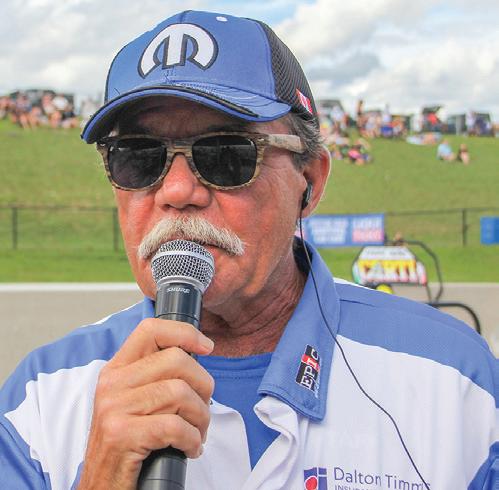
So, was J.D. Beach riding under team orders? Either signals from trackside, or from J.D.’s race savvy and common sense, yes.
I couldn’t help but wonder if such a scenario had ever happened, thinking it must have. Consider the number and nature of close race and championship finishes that have come to be over the decades. Consider also the factory teams that have been: Harley Davidson, Indian, BSA, Triumph, Norton, Yamaha, Honda and Kawasaki have all fielded, in some cases multi-rider teams.
There must have been cases of championship induced team orders. I’m going to have to look into that.
Another real good example of team orders was one that I witnessed in the Canadian Superbike series final race of 2005. It was at Shannonville Motorsport Park and Francis Martin was poised to capture the Canadian Superbike championship riding for Suzuki Canada. If successful it would be his second crown having won his first aboard a Kawasaki in 1999. The simple problem was that Clint McBain, also Suzuki mounted was holding a position in the race that would rob Martin of the points he needed to take the crown. Although McBain was riding for another team, the Blackfoot/ Coors squad, he was on a Suzuki and the corporately influenced orders were issued. A Suzuki/Blackfoot/Coors team vehicle was witnessed rushing up the access road to the back straight where the request was made clear to McBain, with some discretion of course. Shortly thereafter McBain’s motorcycle began to slow and the positions changed as did the championship points. At completion of the race the tally showed Francis Martin with the points he (and Suzuki) required to secure the Canada Cup.
It would be 16 years before Suzuki would rule again when Alex Dumas, home after a stellar early career in the US, secured the laurels in 2021. As a matter of interest Suzuki won the Canadian championship in 1986 and ‘87 with Michel Mercier on board, then in 2002 Jordan Szoke made a surprise return to Canada from his AMA Pro career and was quickly drafted unto the Suzuki team and rewarded their investment with the national championship.
Of Suzuki’s championships, or any other manufacturer or team, the above noted was the only time team orders were given to win a championship that I am aware of.

One thing is certain and that is I will never forget the day that Clint McBain won the CSBK championship for Francis Martin and Suzuki Canada by following team orders. IM
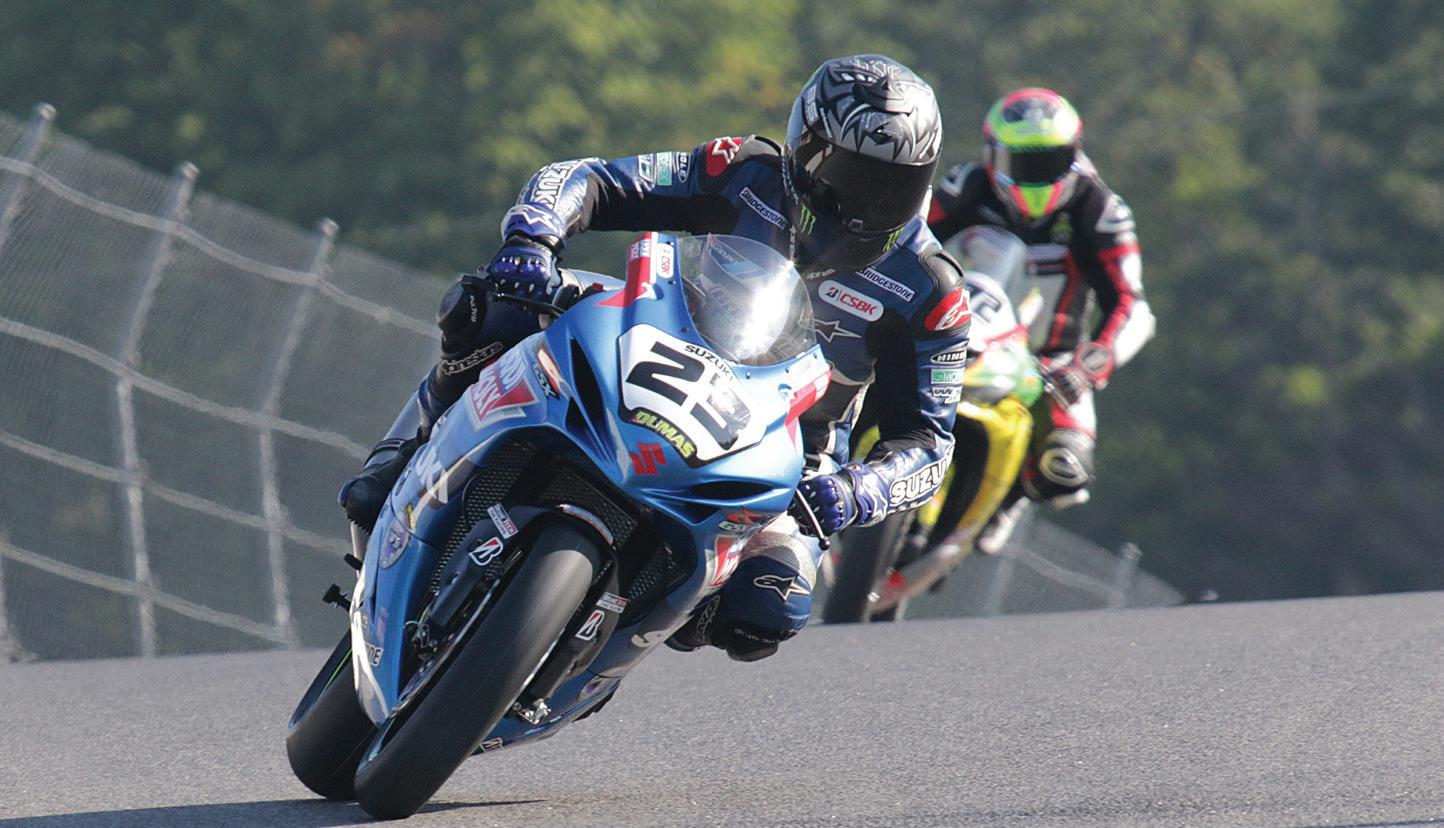
FRANKLY
SPEAKING FRANK
Francis Martin (No. 23 above) won his second CSBK Pro Superbike title in 2005.
52
PHOTO BY DON EMPEY.
Inside
Motorcycles
Maple Ridge Motorsports 20430 Lougheed Hwy Maple Ridge, BC 877-546-6384
mapleridgemotorsports.com
Burnaby Kawasaki 7771 Edmonds St. Burnaby, BC 604-525-9393
burnabykawasaki.com


Fast Track Powersports 3418 Catherine Street Dorchester, ON 519-268-8429

fasttrackpowersports.ca
Grand River Powersports 1264 Colborne St. East Brantford, ON 519-759-8140
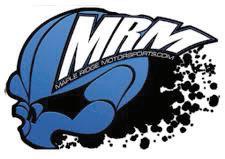

grandriverpowersports.ca
Wighty’s Repairs Inc. 122 Huron Rd Hwy 8 Mitchell, ON 519-348-0404
wightysrepairs.com

Marc’s Troubles
Just 30 years old, Spanish MotoGP living legend Marc Marquez is a focus of attention on the world championship trail, and not in his former good way. Struggling for a return to form, without a win in two years (and now everyone’s counting), Marquez is now riding in a way he has previously mocked – with caution.
At the recent MotoGP round at Silverstone, Marquez was proud of the fact that he didn’t crash – although his exit from Sunday’s main race was caused by a collision with the Ducati of Enea Bastianini that wound up with both on the ground, but in different locations.
“I’m happy about my weekend and I’m happy about this Sunday,” stated Marquez post British GP, “I think we rode in a good way and had a good approach.”
If this seems… odd, then consider his next comment: “I am happy because I’m looking only at myself. I’m looking to try and rebuild my confidence on this bike. I had zero crashes all weekend – OK on Sunday I crashed but it was not a crash of pushing on the limit.
“I have more but I don’t want to use it now,” continued the six-time premier-class world champ of his potential pace. “Because, to have that extra, then it is a lot of risk. Now, it’s a different mentality, of
course. But I need to keep going like this. We need to find a base to build our future.”


For years, Marquez has been a frequent crasher, but mostly in practice and qualifying, and seldom getting hurt. Then he got tangled up with his factory Repsol Honda in a charge through the field at Jerez in early 2020, and his era ended.
Since then, he has taken time of to get his much-repaired right arm properly fixed but so far this season has crashed regularly, including breaking bones in a senseless collision while running up front at the Portimao opener.
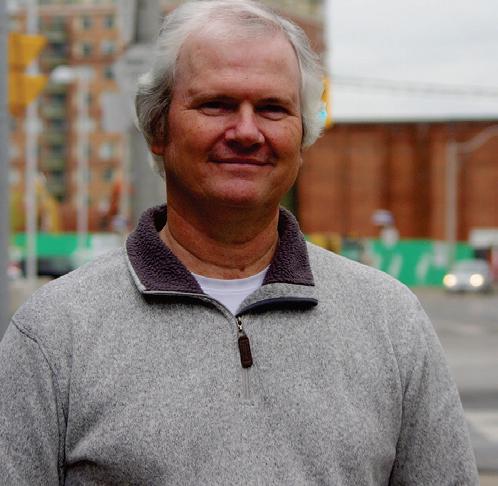
At the same time, the European manufacturers (Ducati, and recently KTM and offspring GasGas) have come to the fore, as long-established top guns Honda and Yamaha struggle. This has caused the organizers to consider rule allowances for the Japanese manufacturers, a shock given not so long ago the Asians were completely dominant.
Yamaha are down to just two entries, as the established satellite teams look for better equipment and support away from Japan. Rumours suggest that Rossi’s Ducati effort might jump to Yamaha in the future, and while Rossi had much success with the tuning fork company, his second-year squad is doing very well with Ducati now.
At Honda, their typical image of domination and secrecy is no more; their Grand Prix effort has clearly lost its way, possibly due to the long periods when kingpin Marquez was unable to ride.
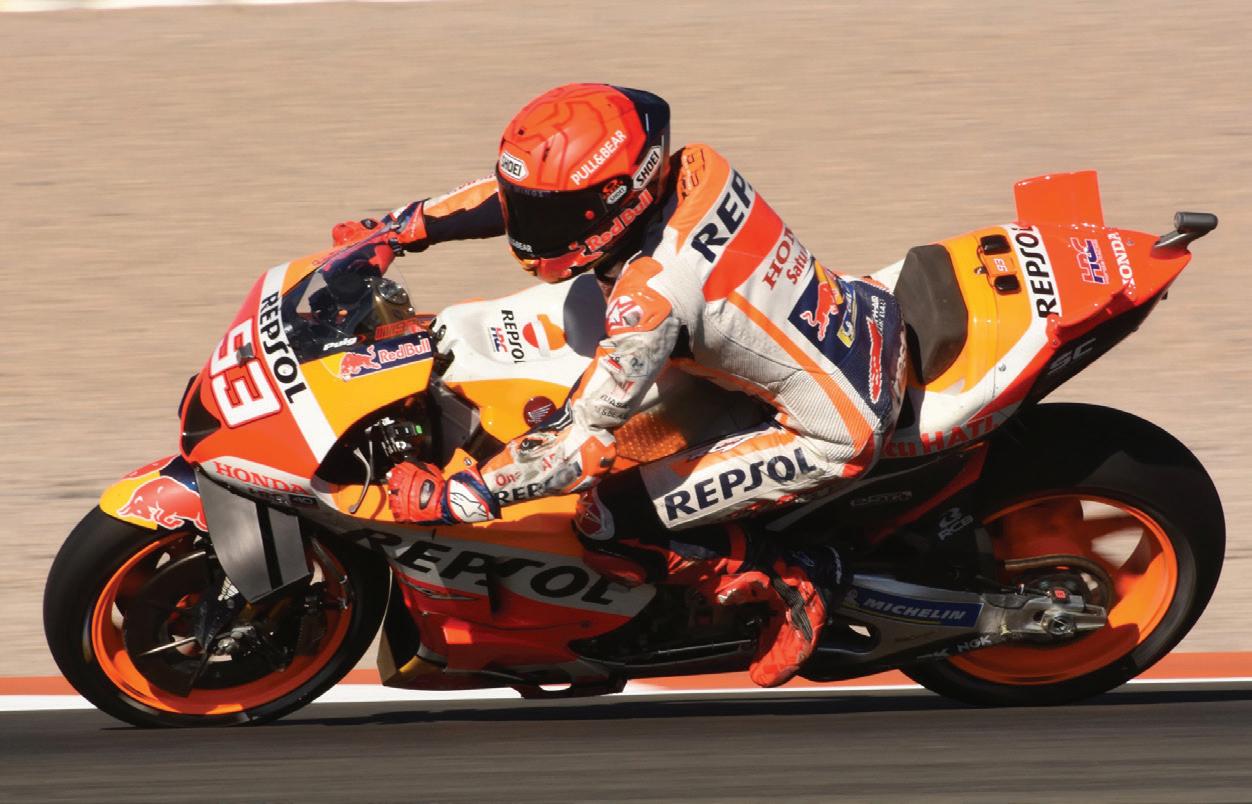
The next big team test in MotoGP is at Misano in September, so when you read this, you might want
to check the internet for the latest Marquez/ Honda update.
Honda have, to their credit, changed their typical media behavior and opted to deal with these issues head-on. Earlier in the year, they indicated that Marquez might be allowed to leave his deal a year early, prior to November 2024.
Honda have stepped up to deal with the rumors that they might withdraw, as Suzuki and Kawasaki opted to do. Honda pulled out of F1, only to have the big success of Red Bull to cause an about face. So, Marquez isn’t getting dismissed.
The problem with following the story in the case of other teams is that Marquez must find somewhere else to work. Who would hire him? The other teams, and their riders, are no longer scared of Marquez, and no one knows what his eventual, healthy, ultimate pace could be.
Could he once again be dominant on any machine? So far, Marquez has only ridden a Honda at the top level, and racers switching manufacturers have had a very tough go of late – look at the permanent career dip for now-retired Rossi and fellow former alien Jorge Lorenzo.
With most of the rider lineup sorted, and only eight Ducatis to serve a grid full of people who are either getting rich or would love to switch to the Italian manufacturer, or both, is there any urgency to grab Marquez from Honda? It seems not.
Much was made of Alex Rins’ move to Honda for this year, and there have certainly been flashes of brilliance for the former Suzuki hero. But like the other works backed HRC men, he has missed lots of time due to injury, and then shocked the paddock (by conservative 2023 standards) by opting to jump to Monster Yamaha for 2024.
Recently, Honda’s HRC Racing boss, Yasuharu Watanabe, explained that “we will never withdraw. The development of the 2024 machine is progressing rapidly. If we can find our pace, we will fight in 2024. I can’t say there is any proof of that pace yet.” IM
ROAD RACE REALITY COLIN FRASER
Marquez in action at Valencia, Spain in 2022.
54 Inside Motorcycles
PHOTO BY COLIN FRASER.










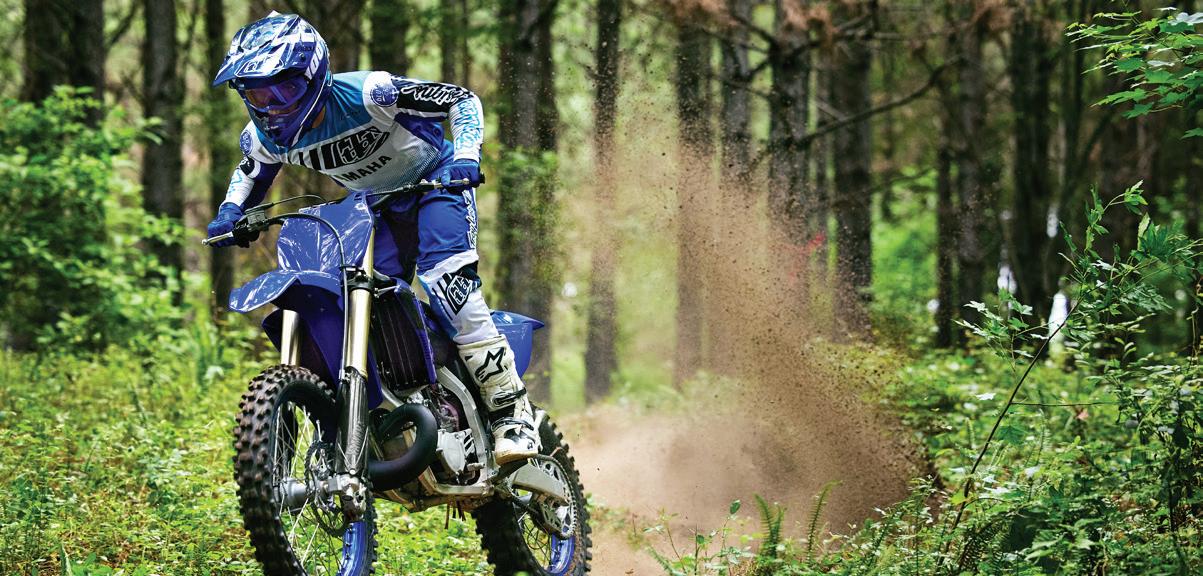


Empowering motorcyclists to save a rider’s life! • 3.5 hour duration comprising 3 Modules • Delivered by 1st Responders personnel & volunteers • Based on Fire and Rescue training Visit www.BikerDown.ca to register today! What is Biker Down? Proudly Supported by: Special thanks to our media supporter: Biker Down! is a FREE 3 HOUR COURSE for motorcyclists covering: The first person on scene at a motorcycle incident could be… YOU! InsideMotorcycles.com 55 Professional rider depicted on closed course. The riders shown are highly skilled, professional riders, and their actions are not intended to be duplicated in any way. Ride within the limits of your skills and experience, never beyond them. Never engage in stunt driving or riding. Avoid excessive speed. Always wear required and/or recommended riding gear. Never drive or ride under the influence of alcohol and/or drugs. Ride safely, respect and protect the environment, and observe all provincial and local laws. Beginners should be extremely cautious and allow extra time and distance for manoeuvring and braking. Yamaha recommends taking an approved training course. Read your owner’s manual and product labels, and inspect your Yamaha vehicle before operation. Some U.S. models and/or optional accessories may be shown. Discover More Yamaha – Genuine Parts & Accessories, Service and Finance Advanced Power I Razor Sharp Handling I Next Generation Styling 2023 YAMAHA MOTORCYCLES Rider Centric Performance Southwest Marine & Powersports 70672 Bluewater Hwy Grand Bend, ON Southwestmap.com 519-238-2887 Dewildt Marine & Powersports 1300 Highway 7 East Peterborough, ON 1-844-291-6330 dewildtmarine.com Dewildt Marine & Powersports 1982 Commerce Park Dr. Innisfil, ON 1-888-656-8680 dewildtmarine.com Tri-City Cycle & Sport Inc. 351 Weber St. N Waterloo, ON 519-884-6410 tricitycycle.ca
INSIDE TECH
This summer, the family and I headed out to eastern Canada to attend my nephew Andrew’s wedding. The wedding was held halfway around the Cabot Trail on Cape Breton Island, which is a huge island off the northeast shore of Nova Scotia, one of Canada’s most easterly provinces jutting out into the beautiful North Atlantic Ocean. If you, as a touring rider, don’t have the Cabot Trail on your bucket list of destinations, you need a slightly bigger bucket, as it is definitely one of the prettiest pieces of pavement in our country for sure.
My first and only chance to ride this beautiful highway on a bike was over 10 years ago on a new Kawasaki Concours that Canadian Kawasaki Motors had provided me to review for Inside Motorcycles. I was attending the Canadian Superbike series event in Shubenacadie, NS, riding out to the event from my home in central Ontario; then, I headed off to ride the Cabot Trail after the race. I think it was about a 5,000 km trek, which wasn’t bad for my first time on a big solo bike journey.
I definitely learned a few things on that trip that just had never occurred to me as an exclusively short distance rider. My trips up until then had been 800 to 1,000 km day rides on my sport bike, which hadn’t really necessitated much in the way of packing. Whatever I thought I needed, would generally fit in my tank bag. I remember packing my wallet, tinted and clear visor options, a rag and cleaner for the visors, a water bottle,
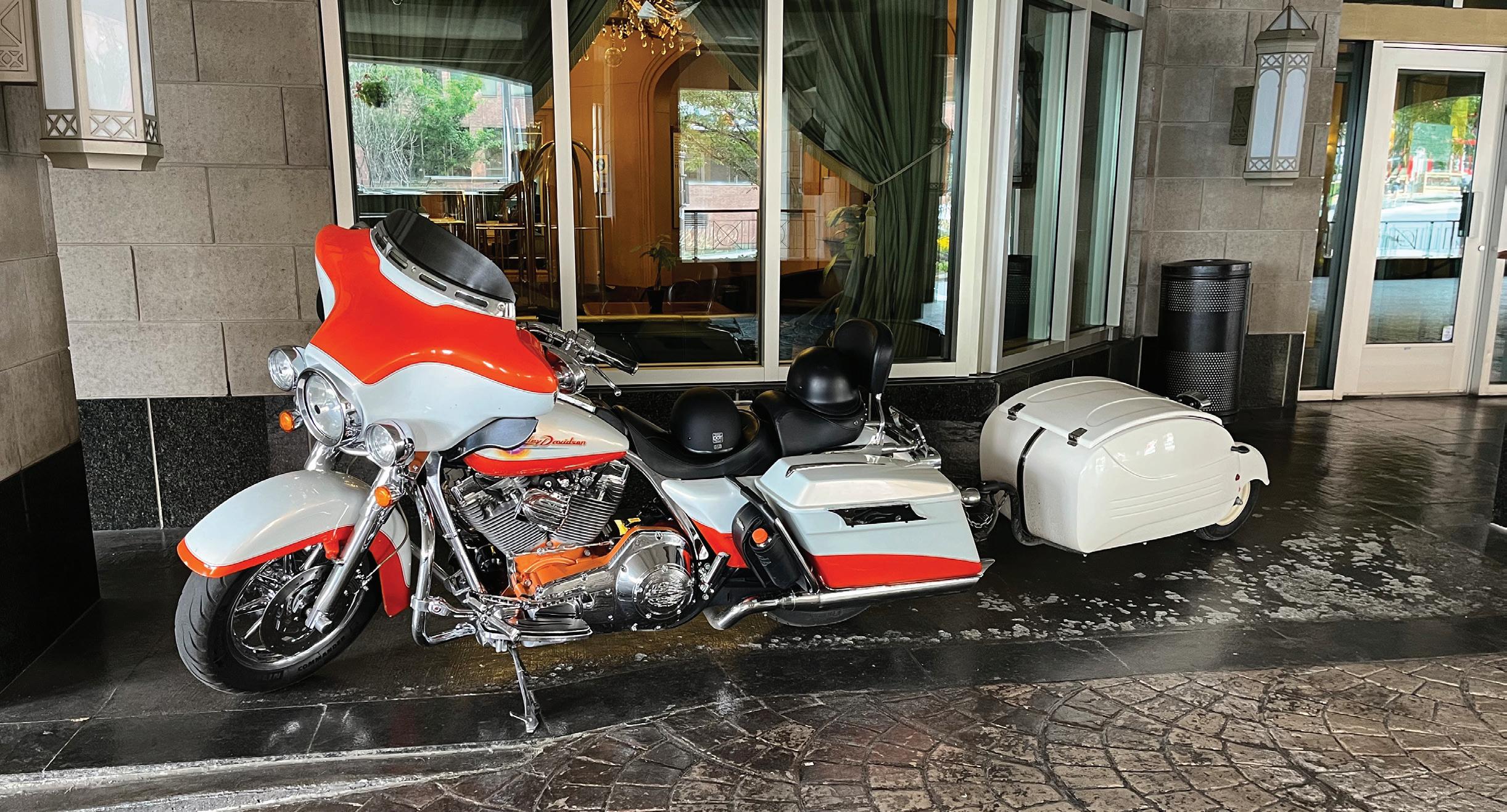 By John Sharrard
By John Sharrard
long distance touring
and my maps for the day, that was about it. The rest of the room in the tank bag was empty but necessary for the removal of clothing layers as the day warmed up. To do 1,000 km in a day, I left very early in the morning, often before sunrise. This meant dressing warm with a few layers up top and long johns under my two-piece riding leather suit, with the addition of heavier gloves, worn until the sun came up and started to warm the day. At that point, the clear visor changed to tint, the long johns came off, maybe a sweater was removed and lighter gauntlet racing style gloves were worn for better dexterity and control over the heavier warmer ones. As a young guy on a sport bike, the magic of heated grips hadn’t really been discovered yet. Anyway, on my bike trek to the east coast, a pile of new challenges had to be realized, accepted and planned for. I was now travelling far enough that the weather was no longer in my control. On day trips before, if it looked like rain, I just picked another day, rarely going far enough to challenge the weatherman for accuracy. However, on this trip, I had a timeline and had to be out east for the races with no real leeway in my schedule. Guess what? It rained like I had never seen before, as the clouds seemed to follow me on my journey as I headed east. So, a good one-piece rain suit became an important ally in my journey. Sure, if it rains long enough water slowly creeps in, starting with your feet and hands, and then migrating down the back of
56 Inside Motorcycles
your neck and finally your upper chest as the pressure-washer effect of riding at speed helps water find any weakness in your gear, but at least with a good rain suit the wind doesn’t get through and bring on the cold.
Another new experience was the inclusion of a border crossing that necessitated a passport and other required identification. My route had me leaving Ontario, then heading east through Quebec and then crossing through the states of New York, Vermont, New Hampshire and Maine, before popping back into Canada at New Brunswick. As a racer, I was always looking for the shortest, cheapest and most effective way to get from Point A to Point B, and drawing a line from Ontario to Nova Scotia, cut right through these beautiful upper American states and Canadian provinces. The side benefits were cheaper gas and the roads were way twistier as well, a definite plus for a motorcyclist, that car drivers just don’t understand! So, the border required making sure my documentation on the bike was in hand, passport too, and then enough American currency to fuel the bike two or three times, perhaps a hotel room too depending on timing and, of course, unforeseen incidentals like an unplanned ferry crossing or an emergency lobster dinner at that roadside festival in Maine that I had no idea was going to be there.
Packing the bike for the journey, I soon realized was an art in organization to avoid having to empty all the gear whenever I stopped. Little things like keeping my wallet and passport handy, make perfect, obvious sense. This same thought pattern though, needs to be followed as you keep your commonly needed items near the top of your saddlebag or tailbag, relegating the emergency stuff to the bottom with your repair tools, where hopefully you may never need to access them. I learned to try and balance the bags as best I could for equal weight distribution as well as trying to keep the heavy stuff forward and low where it will have the least amount of negative effect on the bike’s handling. What I found helped was a small list, on paper, or in your phone showing a ‘map’ of your luggage and what was where, so that you could find what you needed quickly and effectively when time was pressing.
Since the bike was brand new, I really didn’t worry too much about much maintenance or mechanical preparation. I fit all my gear in the bike’s stock saddlebags, and I didn’t take a passenger, so I didn’t even adjust the suspension or even worry about tire pressures, which in hindsight was foolish, but the bike worked okay for me, or at least I thought it did. I now know it could have worked much better with setting a few basic parameters, which brings me back to this summer’s trip.
I saw lots of bikes and their riders out enjoying the east coast and all it has to offer. Some were obviously on a day trip with nothing more than a knapsack and a fishing rod, straddling a dirty old Suzuki DR-Z400 that hadn’t seen chain lube since it was bought new at the dealer, right up to two guys in Klim gear on matching BMW GSs that looked like they were circumnavigating the globe. These guys had heavy duty aluminum side panniers and a matching top tail box with soft luggage bungee corded on top of that and a massive hockey bag tied down where the passenger would normally sit. These guys didn’t stop to chat, I just noticed them at two overlooks at the side of the road and they were gone. It would have been nice to discuss
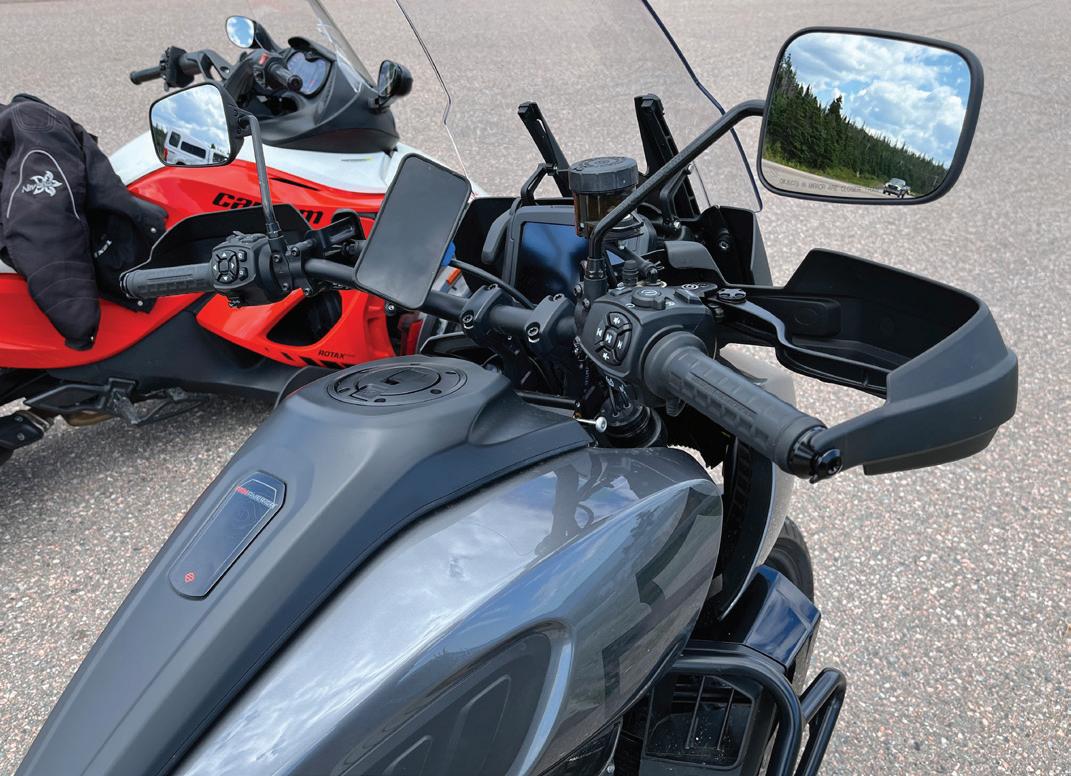
their journey with them, as they definitely were covering some serious ground.
What did concern me is when I saw some smaller bikes overloaded or improperly loaded. I could tell by the fear in their eyes, the death grip on the handlebars and the gentle wobble they had going on at speeds well under the posted speed limit. So, let me throw down some quick pointers. Try to mount wind protection and mirrors to the bike and not the handlebar. Anything added to the handlebar will act like a parachute and bring on unwanted bar movement in crosswinds or during buffeting from passing cars, etc. Watch your tire pressures, you may need to increase them especially as you load the bike. A cheaper tire, which may prioritize off road traction (think adventure bike), will have a soft sidewall and permit lots of undamped movement between the rim and the contact patch on the ground, so make sure you have the right tire for the trip and it is inflated properly.
As you add gear to the back of your bike, you must monitor the rear spring setting. Remember, if you are much over 180 pounds, it is quite likely your rear spring is already inadequate for your weight. Most of our bikes are built in Japan or in Europe, where the average rider is 130 to 170 pounds; have a reputable shop help you check your sag and ensure the spring will take you and your gear. A rear shock that is overwhelmed will underload the front tire and bring on weave and wobble for several reasons. A good rule of thumb is you shouldn’t use up more than one third of your suspension travel when fully loaded with you on your bike. If you can’t get there with a small amount of preload, contact a good suspension shop before heading out on your next big trip and they can help you select the proper springs and set up your bike safely.
Until next time, ride smart, ride safe and get out and explore this amazing country! IM
Opposite page: Harley-Davidsons seem to be popular for long distance touring. This one from Ontario was outfitted for extra gear without the weight penalty aboard.
InsideMotorcycles.com 57
Above: The Harley-Davidson Pan America and its height-adjustable suspension can help accommodate load while also not being too tall when stopped.
Bridgestone CSBK: Young Fights Back at CTMP


Leading up to the fourth round of the Bridgestone CSBK season at Canadian Tire Motorsport Park, headlines had revolved around two items: the weather and the performance of young gun Alex Dumas.
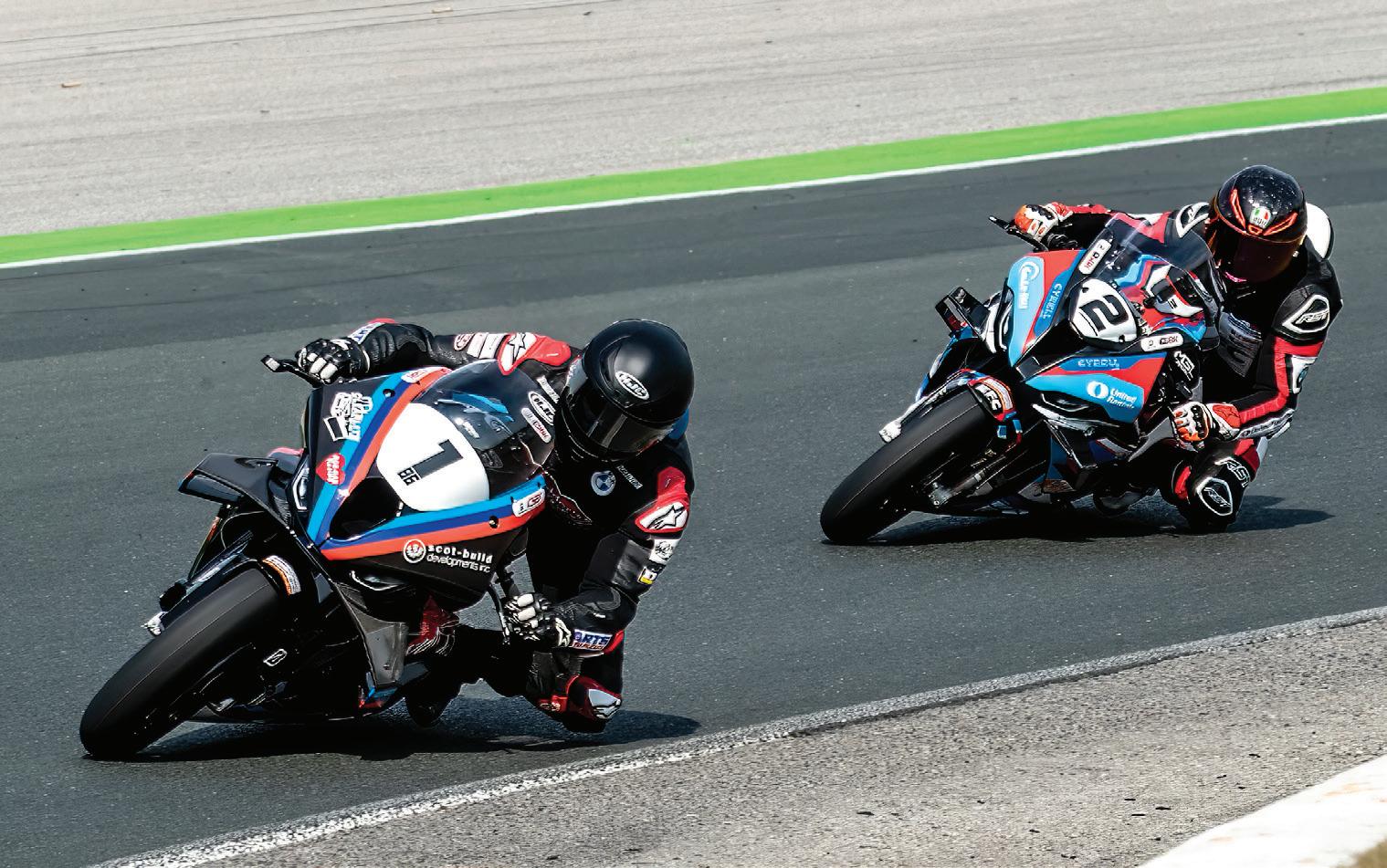
After picking up two wins, including the first in the rain, at the season opening round at Shannonville Motorsport Park, 21-year-old Dumas would finish second to defending champion Ben Young in the first race at round 2 at Grand Bend Motorplex before taking the top podium step the following day in another rain-soaked affair. With Young suffering a crash during the warmup lap of the second race, the No. 1 plate holder only managed an 11th place finish, leaving Dumas with a comfortable 36-point lead in the Pro Superbike standings after two rounds as the series trekked eastward to Atlantic Motorsport Park.
Unfortunately, the weather continued to impact the 2023 season, and for the first time in the history of the CSBK, the third round was cancelled when rain washed out access to the track while also rendering it un-rideable. With the AMP round off the table, all eyes turned to Canadian Tire Motorsport Park and the schedule Superbike triple header.
With rain once again factoring in, Friday qualifying was cancelled, leaving grid spots determined by the times set in the earlier practice sessions with Young lining up on pole position followed by Dumas in second.
Despite an early challenge from Dumas, Young assumed the lead during the first lap of Saturday’s 20 lap feature race and never looked back. Meanwhile a three-way battle for second and third place developed behind the leader with Dumas, Sam Guerin and Tomas Casas each in search of a spot on the podium. At the checkered flag Guerin took second place with Dumas relegated to the final podium spot following spirited battles with both Guerin and Casas.
Spectators may have felt a sense of déjà vu on Sunday morning when Dumas grabbed the holeshot in race two only to once again concede the lead to Young during the initial lap. While Guerin and Dumas both stayed close to Young, at the checkered flag the defending champion picked up his 13th career Superbike win and more much-needed points on Dumas who came home in third behind Guerin who repeated his second-place performance.
The second Pro Superbike race of the day saw Young once again take the win, this time by a convincing seven second margin over the rest of the field. Meanwhile, Dumas once again found himself on the third step of the podium after closely following second place finisher Guerin for the entire race while holding off repeated challenges from Casas and 14-time CSBK champion Jordan Szoke.
With Dumas’ lead in the Pro Super-
58 Inside Motorcycles
Alex Dumas arrived at CTMP with a commanding 36-point lead in the championshiop standings.
PHOTO NY RICHARD COBURN.
Sam Guerin (No. 2) did his best to challenge Young (No. 1), but ended up earning three trips to the middle step of the podium. PHOTO BY RICHARD COBURN.
bike standing reduced to just three points, the stage is now set for one of the most closely contested championships in the series history as the racers prepare for the season ending triple header to be held at Shannonville Motorsport Park.
While Dumas, who works as an instructor at Shannonville’s Fast Riding School may be seen to have a home advantage, Young’s performance at CTMP sent a clear message that the champ is ready and will ing to fight to keep his crown.
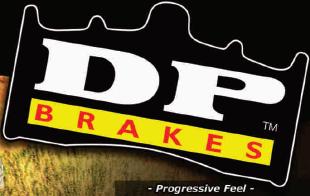
While the current Pro Superbike points standings suggest that the 2023 cham pionship will go to either Young or Dumas, with only Guerin and Casas having a mathematical chance of winning the title, it would be premature to suggest that they will dominate the competition in Shannonville. With a grid full of contenders including Szoke, Casas and the returning Trevor Daley, not to mention Sam Guerin who has proven to be more than ready to make the move to the top step of the Pro Superbike podium, the final round of the Bridgestone CSBK season promises to be one for the records, so stay tuned and buckle up.
Complete results and news from the Bridgestone CSBK series can be found online at www.csbk.ca.


Szoke and Dion to Part Company
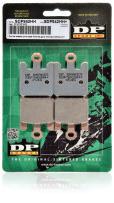
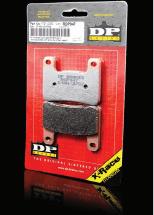

One of the big news stories leading up to 2023 Bridgestone CSBK season was Kawasaki’s dream pairing 14-time Superbike Champion Jordan Szoke with the up and coming Trevor Dion who claimed the Pro Sport Bike title as a rookie Pro in 2022. In a turn of events, Kawasaki has confirmed that with immediate effect, the two racers will no longer be pitting under the same tent. Commencing with the fifth and final round of the 2023 CSBK season, Szoke will be continuing with the Canadian Kawasaki Motors program while Dion will move forward with the LDS Consultants supported privateer effort.

The dissolution of the Szoke / Dion partnership comes on the heels of a disappointing season to date with Szoke currently in fifth position in the season standings, 86 points adrift of points leader Dumas and Dion in 11th as the result of early season injuries.
In addition to the change in location in the paddock, Dion will also pull double duty at the Shannonville season finale, racing in both the Pro Superbike class as well as returning to Pro Sport Bike class. IM



WWW.DP-BRAKES.COM The FIRST.. The BEST.. In Sintered Braking Technology. Trevor Dion 2022 CSBK Pro Sport Bike Champion
Jordan Szoke (No. 101) and Tomas Casas (No. 18) are just two of the racers capable of winning at Shannonville.
PHOTO BY RICHARD COBURN
Red Bull Outliers - Hard Enduro meets the Badlands
Following events in Serbia, Austria and Romania, the globetrotting 2023 FIM Hard Enduro World Championship arrived in Alberta for the fourth round of the series, Red Bull Outliers. If that is not enough frequent flyer miles to make you feel exhausted, keep in mind that Outliers was originally scheduled to be the fifth race of the 2023 season but the cancellation of Italy’s Abestone event originally scheduled for early July reduced the overall number of races for the year to six. Coming into Outliers, local racer and fan favourite Trystan Hart found himself in second place overall in the world championship standings after a fourth place finish at the season opening Xcross Hard Enduro Rally in Serbia, followed by podium finishes at both the Red Bull Erzbergrodeo (third place) and Red Bull Romaniacs (second place) events. With the added momentum of having bested current world championship points leader and fellow KTM factory rider Mani Lettenbichler to take first overall at the AMA Red Bull Tennessee Knockout Extreme Enduro the week before, Hart was looking like the man to beat in Canada.
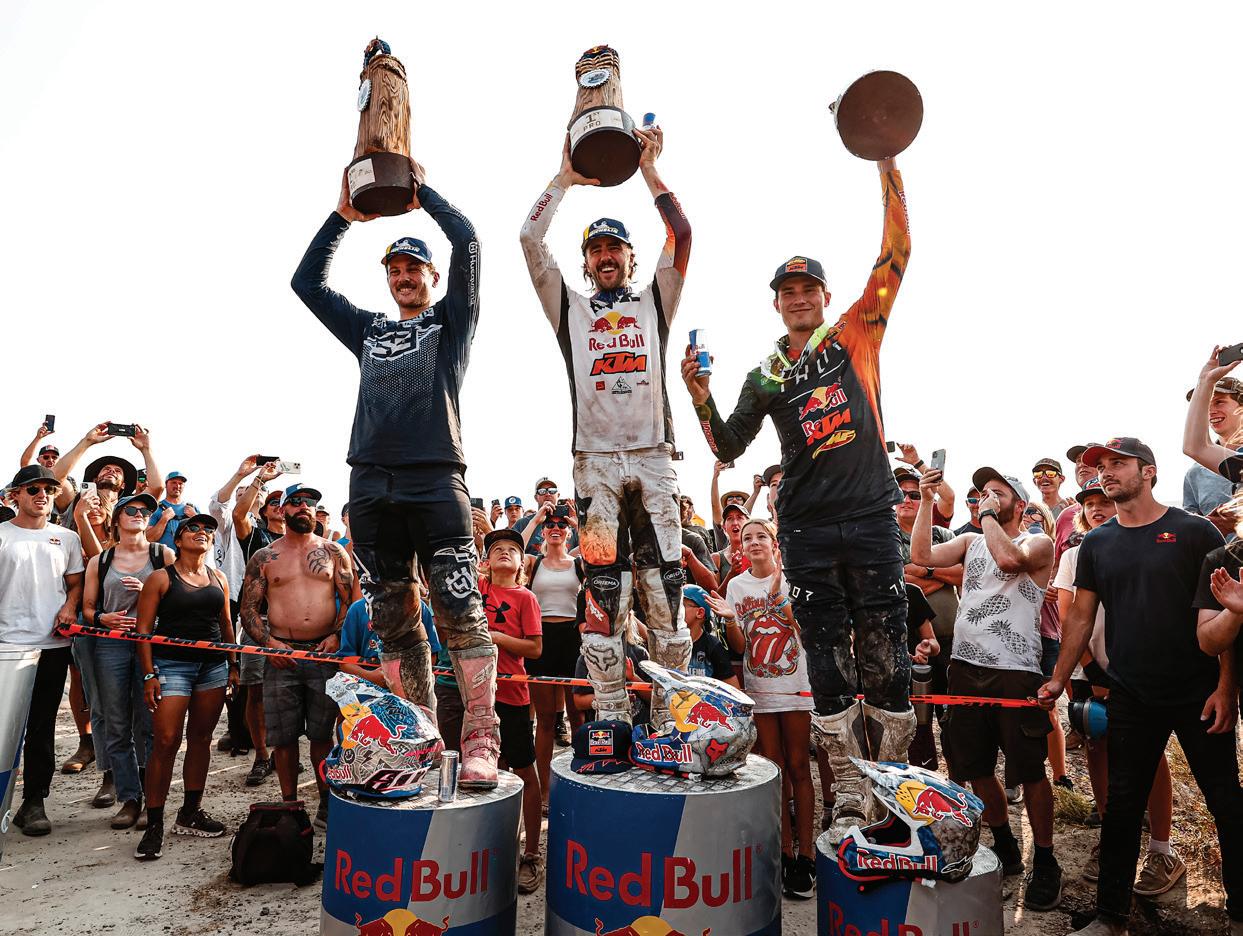
Outliers once again hosted the prologue race in the urban environment of downtown Calgary where racers navigate their way around a man-made circuit to the delight and amazement of the thousands of spectators. Despite whatever momentum and home advantage Hart may have had, Lettenbichler demonstrated the skills that have led to two previous world championships as well as running undefeated to date in the 2023 season taking the prologue win and pole position for the following day’s main event in the Alberta Badlands near Steveville. Husqvarna’s Billy Bolt, holding down third place in the world championship standings coming into Calgary, kept Lettenbichler honest at the prologue finishing right on his heels, while Hart was left disappointed with a third-place finish.
With the prologue complete, the following day saw the Outliers competition move into the hills of the Alberta Badlands where unforgiving hill climbs up the treacherous surfaces awaited the competitors.
Lettenbichler took advantage of his starting position jumping out to the early lead followed by Bolt chasing in second around the 12-kilometre track. After switching the lead back and forth during the first lap, Lettenbichler started to put some daylight between himself and Bolt on lap two. Meanwhile a poor start left Hart stuck in a pack of bikes and contained by the carnage that followed in the dusty conditions. Recovering to fifth place Hart put his head down and started to make his way up the rostrum as the race-ending Extinction loop awaited racers on the third and final lap.
While mistakes on the part of both Lettenbichler and Bolt ultimately kept the race close, Bolt was unable to capitalize, with Lettenbichler taking home his second Outliers trophy and keeping his 2023 unbeaten streak alive. Capping off a solid ride, Hart came home in third place, rounding out the podium.
Next up the FIM Hard Enduro World Championship moves onto Spain and the 24MX Hixpania Hard Enduro on October 12 to 15 before the season ending 24MX Getzenrodeo held in Germany on November 3 and 4.

Visit www.iridehardenduro.com online for all the latest news and results from the FIM Hard Enduro World Champiosnhip. IM
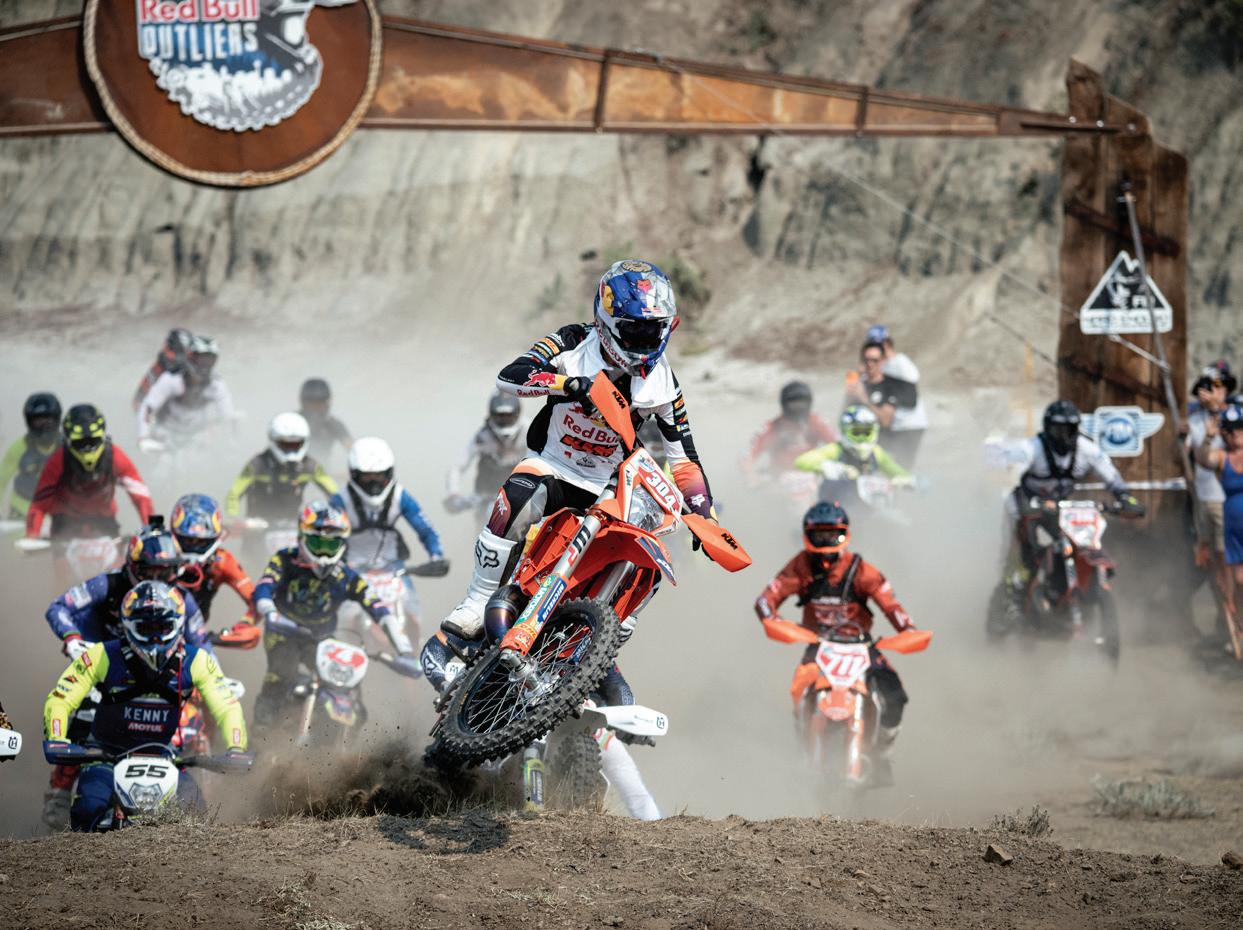
60 Inside Motorcycles
Left to right: Billy Bolt, Mani Lettenbichler, Trystan Hart.
PHOTO COURTESY OF RED BULL CONENT POOL.
KTM’s Mani Lettenbichler grabs the holeshot at Red Bull Outliers.
PHOTO COURTESY RED BULL CONTENT POOL.
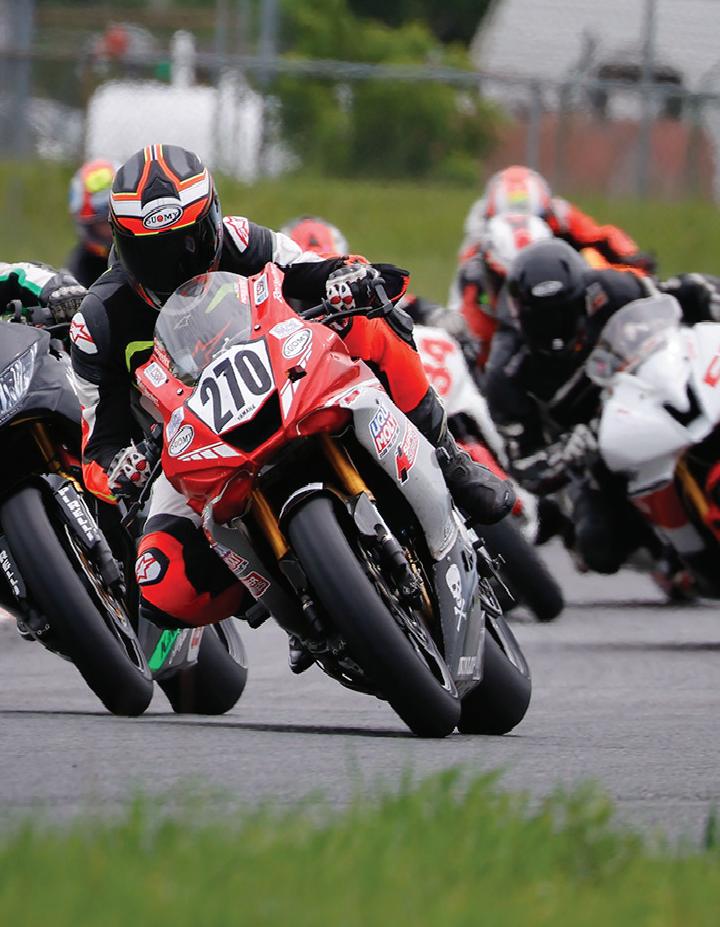 Photo: Michael Lekas
Photo: Michael Lekas
VRRA Vintage Festival
As is often the case, especially when dealing with vintage motorcycles, a picture can tell the story all by itself, so when IM’s Richard Coburn offered to photograph the VRRA Vintage Festival held in early August at the Canadian Tire Motorsport Park, we couldn’t wait to share a few of his pictures here with you and also invite you to visit www.insidemotorcycles.com to view the complete gallery of Richard’s VRRA images. IM
At 74 years of age Dave Roper is still ready to race, making his way into the podium in Period 1 500 as well as the Period 2 Open class. As a past winner of the Isle of Mann Classic Dave is a popular addition to VRRA events as are the vintage machines that accompany him, which included a Surtees AJS 350 as well as the MV Agusta 350 cc triple that Giacomo Agostini raced to multiple world championships.
Holly Varey had a successful weekend at CTMP, picking up the win in Period 1 250 as well as being on the podium for the Pre-65 500 class and Warwick Cup which features British motorcycles of up to 500 cc that were manufactured in 1967 or earlier.

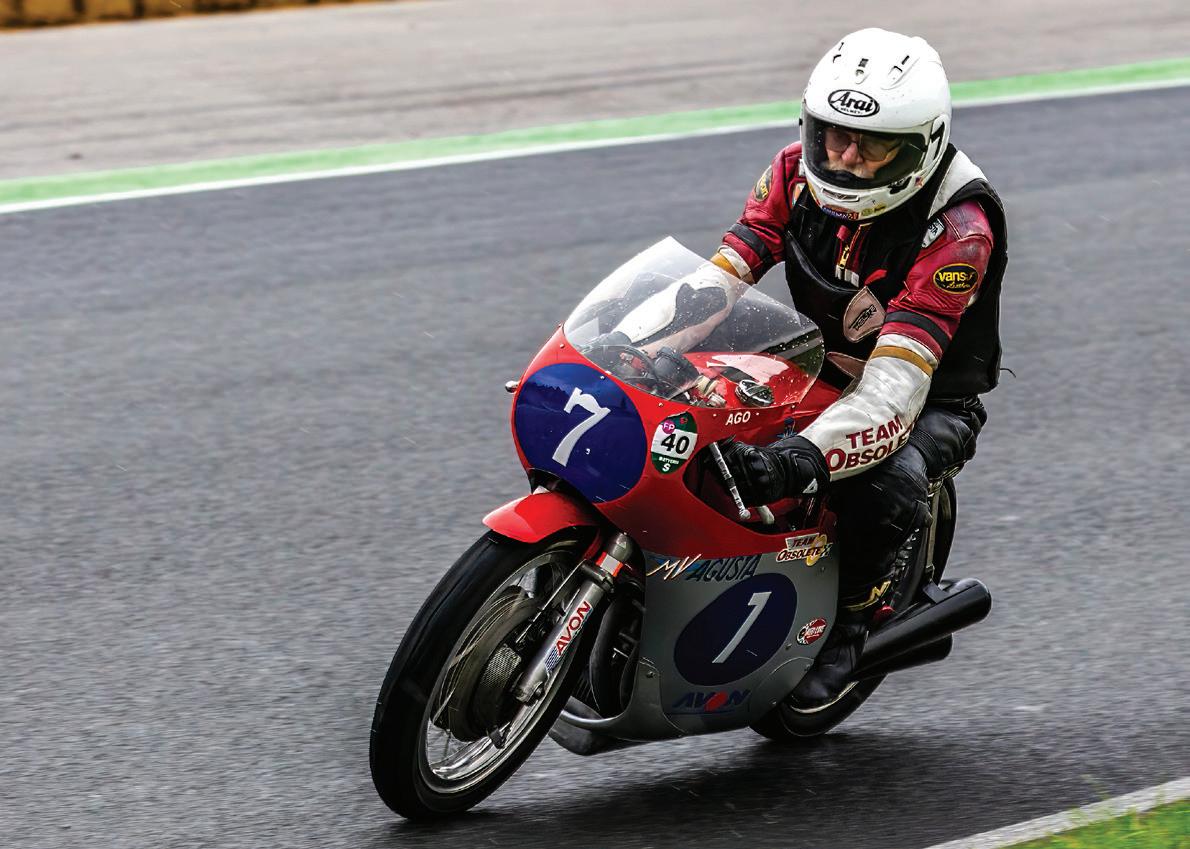

Sidecars are always a big part of a VRRA event. In addition to classes for Period 2 (maximum model year of 1972) and Period 3 (maximum model year of 1982), the Vintage Festival included racers from the Sidecar Racers Association (SRA). Steve Fletcher piloted the No. 134 bike to second in the SRA Sidecar final at the Vintage Festival.

62 Inside Motorcycles
VRRA 2023 Vintage Festival Results
Pre-50
1st: Tim Joyce
2nd: Ingo Reters
3rd: Stanley Reters
Pre-65 500



1st: Paul Brubaker
2nd: Holly Varey
3rd: David Hood
Period 1 200
1st: Brett Sorenson
2nd: Genevieve Perreault
Period 1 250
1st: Holly Varey
2nd: Tyler Emer
3rd: Stan Nicholson
Period 1 350
1st: Camerson Stevenson
2nd: Shaun McDonald

3rd: Graeme Jones
Period 1 500
1st: Paul Brubaker
2nd: David Roper
3rd: Dave Hood
Period 1 Open
1st: Paul Brubaker
2nd: Wayne McKinnon

3rd: Dan Bleichman
Period 2 Lightweight
1st: Steve Canellos
2nd: David Roper
3rd: Jason Porter
Period 2 Middleweight
1st: Mark Morrow
2nd: Jason Porter
3rd: Martin Morrison
Period 2 Heavyweight
1st: Jeff Peters
2nd: Mark Morrow
3rd: Chris Marshall
Period 3 Lightweight
1st: Kevin Renshaw
2nd: Bill Quail
3rd: Mark Morrow
Period 3 Middleweight
1st: Jeff Peters
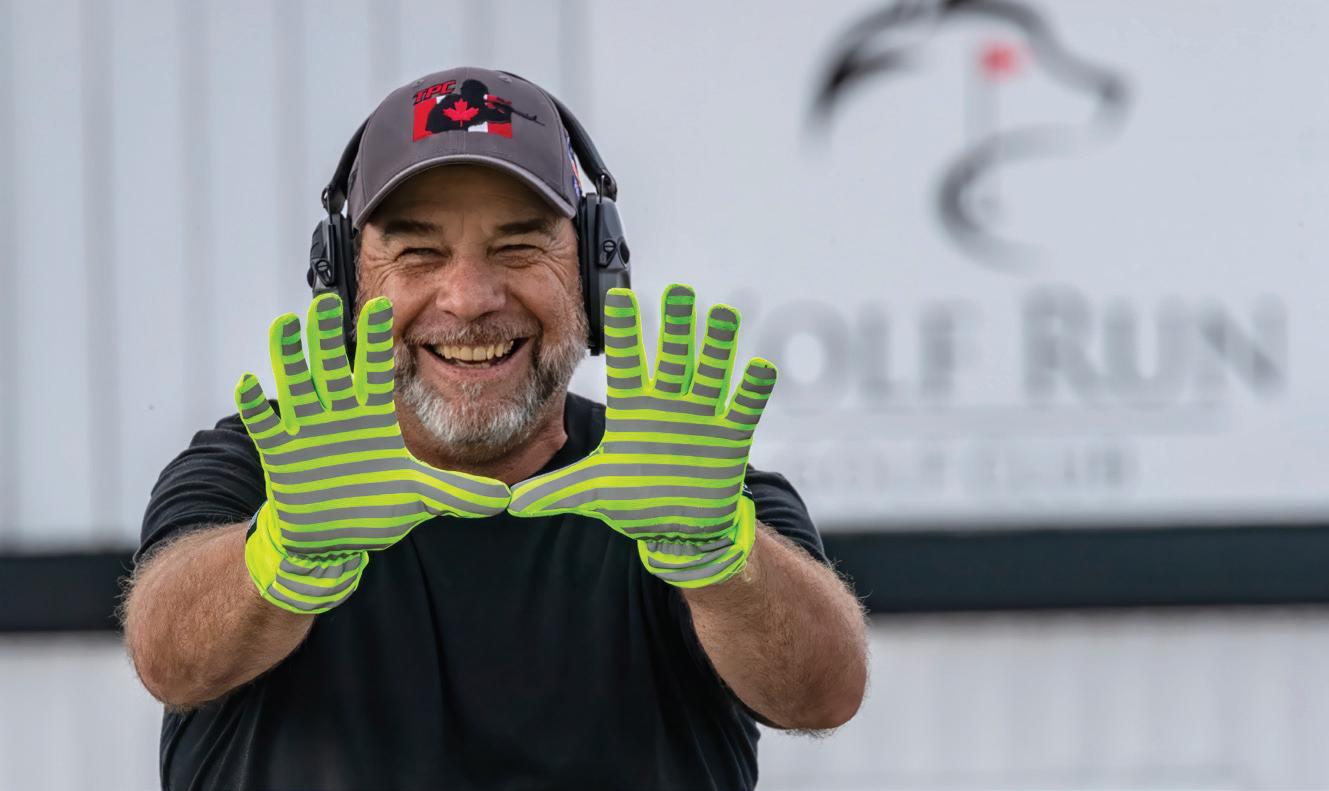
2nd: Todd Ruston
3rd: Kevin Renshaw
Period 3 Heavyweight
1st: Todd Ruston
2nd: Scott Mcvicker
3rd: Tim Ruhl
Period 4-F3
1st: Jonathan Vaillancourt
2nd: Jim Watson
3rd: Jody Pearce
Period 4-F2
1st: Dino Proce

2nd: Graham Nicholls
3rd: Ravo Lainevool
Period 4-F1
1st: Michael MacNeil
2nd: Kevin Renshaw
3rd: Norm Murphy
Period 5-F2
1st: Andrew Cooney
2nd: Rick Edwards
3rd: Dave Laporte
Period 5-F1
1st: Andrew Cooney
2nd: William Deragon
3rd: Rick Edwards
Vintage Open - Junior
1st: Adam Abnett

2nd: Jevon Austin
3rd: Dwayne Bucholtz
Vintage Open - Senior
1st: Andrew Cooney
2nd: Michael MacNeil
3rd: Rick Edwards
Sidecar-Period 2
1st: Tim Joyce
2nd: Mathew Gill
3rd: Jason Fitch
Sidecar-Period 3
1st: Andrew Roberts
2nd: Leslie Skinner
3rd: Rik Burton
Sidecar-SRA
1st: Michael Vinton
2nd: Steve Fletcher
3rd: Wayne Walsh
Modern Lightweight
1st: Stacey Nesbitt
2nd: Zaim Laflamme
3rd: Adam Abnett

Warwick Cup
1st: Paul Brubaker
2nd: Holly Varey
3rd: David King
Masters Period 1/2
1st: Justin Davies
2nd: Jeff Peters
3rd: Shaun McDonald
Masters Period 3/4/5
1st: Dave Laporte
2nd: Jody Pearce
3rd: Rob Marshall
WWW.DP-BRAKES.COM The FIRST.. The BEST.. The LEADER.. In Sintered Braking Technology. Ben Young 2022 CSBK Pro Superbike Champion
VRRA event is guaranteed to make you smile.
A
MiniGP Canada: The Road to Valencia

After two years of development spearheaded by series organizer Toni Sharpless, the Canadian version of the MiniGP National Series got underway with three races at the opening round at Greg Moore Raceway in Mission, BC. Backed by Motul and spec tire supplier Pirelli, the championship has a key feature – the winners head to Valencia in Spain this November to compete against the top guns from other nations’ spec Ohvale series, crowning an overall world champ.
2023 is the third year for the global series backed by world sanctioning group FIM and promoted by Dorna, the MotoGP and World Superbike series organizers. The Americans have been in from the start with their North American championship feeder category, and there was some urgency to get in on the ground floor before the series became fully subscribed by participating countries. As you might imagine, the Europeans are very well represented, especially the Spanish and Italians.
Despite high expectation on 14-year-old Benjamin Hardwick from Sudbury, ON following success in last year’s regional series, a DNF in race 1 and a sole podium appearance during the opening BC round was not according to plan. Meanwhile the star of the BC action was 13-year-old Treston Morrison from Calgary, AB. After securing pole position Morrison would sweep the three races at Greg Moore Raceway, setting the stage for a triumphant return to his home track in Strathmore, AB for the next round of the championship. Also drawing attention in BC was 10-year-old Michael Galvis who managed to challenge Morrison throughout the opening round, picking up two second place podium appearances along with a fourth-place result.
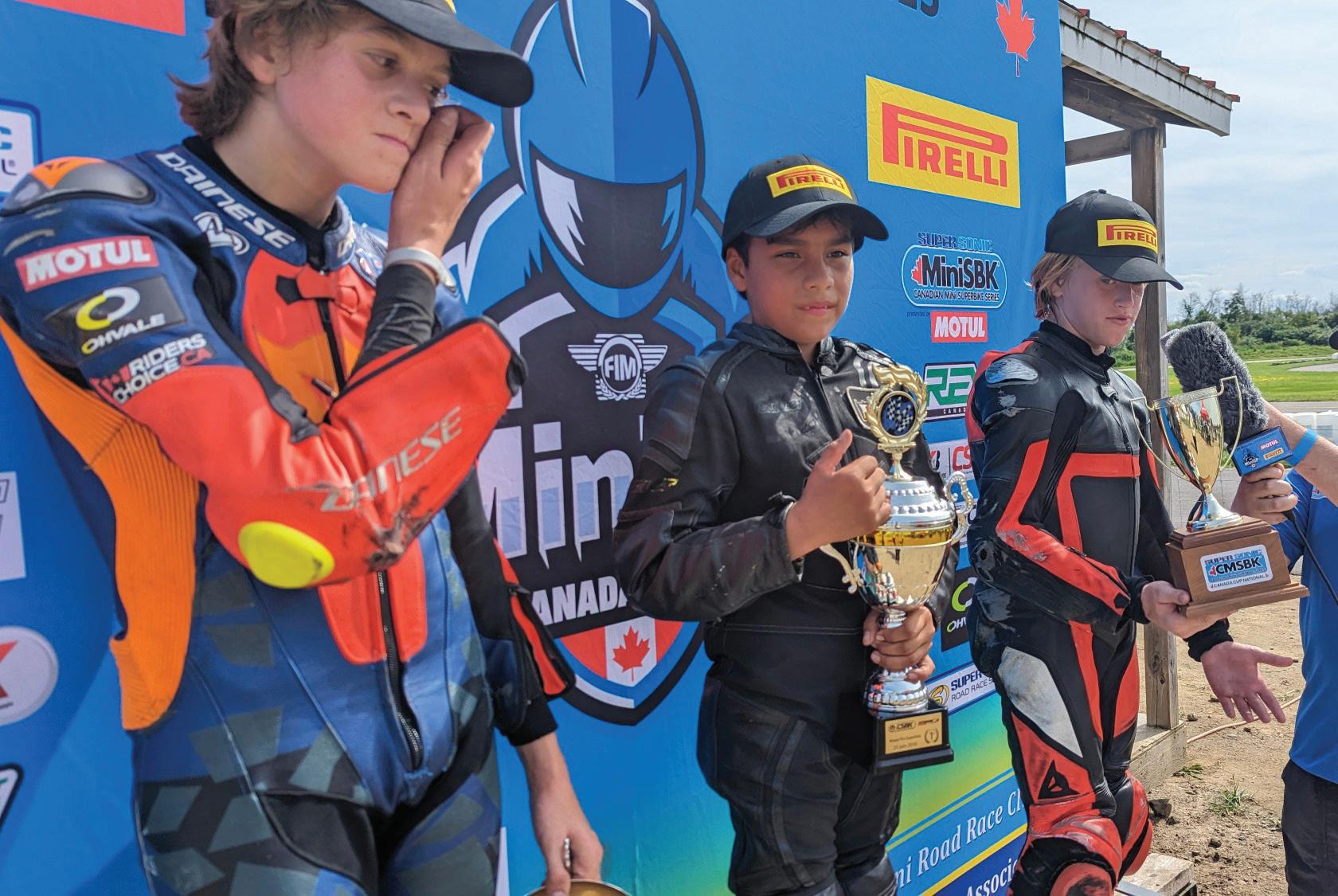
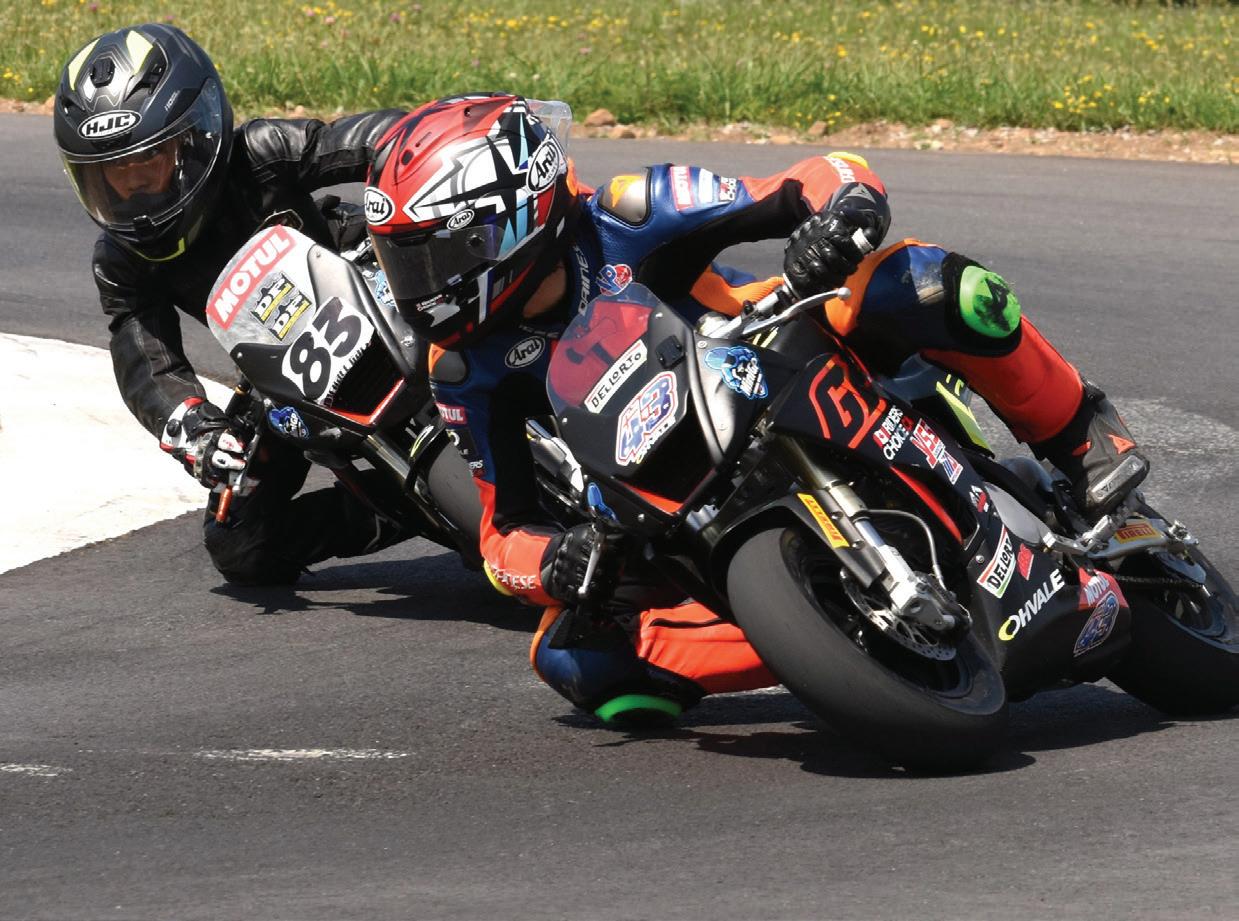
The following week saw the series start the trek eastward with a stop at Strathmore Motorsports Park located 50 kilometres east of Calgary. Despite the promise of Morrison running the table at his home track, a series of mechanical issues moved him out of contention. At the same time Galvis took advantage of the opportunity to shine, picking up his first wins of the series while taking the lead in the overall points standings as the series prepared to continue its journey eastward to Ontario’s Lombardy Raceway near Kingston.
Lincoln Scott was also drawing attention during the Alberta round. While his performance at the opening round was hampered by a recently broken wrist, he arrived in Strathmore ready to race and finished in the runner-up spot in both races, gaining valuable points in the championship.
Arriving in Ontario with a slim eight-point lead over Morrison and Scott showing momentum, Galvis had his work cut out for him. Add in the fact that Hardwick’s third and fourth place finishes in Alberta had kept him in contention as the series moved back to familiar ground and a dramatic finale was all but guaranteed.
Pole position and a win by Hardwick in the first race followed by Galvis being first to the checkered flag in the second set the stage for a final showdown that would make most race organizers green with envy. A solid start from pole put Hardwick in the lead while Galvis and Morrison settled into the battle for second until an over-cooked pass saw Morrison slide off, guaranteeing Galvis the championship and trip to Valencia along with series runner-up Hardwick. IM
64 Inside Motorcycles
Benjamin Hardwick (No. 43) leads series champion Michael Galvis (No. 83).
PHOTO BY COLIN FRASER.
Left to right: Benjamin Hardwick, Michael Galvis and Treston Morrison on the podium in Lombardy.
PHOTO BY COLIN FRASER.
Dewildt Marine & Powersports 450 Lake Ave N Hamilton, ON 1-888-656-7570 dewildtmarine.com

Markham Outdoor Power 9441 Markham Rd Unit 13 Markham, ON 905-294-2355
markhamoutdoorpower.com
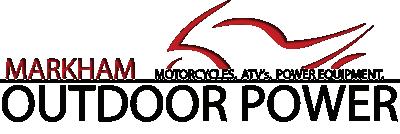
Dewildt Marine & Powersports 1300 Highway 7 East Peterborough, ON 1-844-291-6330 dewildtmarine.com
KW Honda 465 Conestogo Rd. Waterloo, ON 519-746-7900 kwhonda.com

GP Bikes 1100 Champlain Court Whitby, ON 866-475-7111 gpbikes.com
Larry’s Small Engines 286270 County Road 10 Mono, ON 519-941-1517
larryssmallengines.ca












66 Inside Motorcycles skylarkcylinders.com
Maple Ridge Motorsports 20430 Lougheed Hwy Maple Ridge, BC 877-546-6384




mapleridgemotorsports.com
Larry’s Small Engines 286270 County Road 10 Mono, ON 519-941-1517

larryssmallengines.ca
Markham Outdoor Power 9441 Markham Rd Unit 13 Markham, ON 905-294-2355

markhamoutdoorpower.com
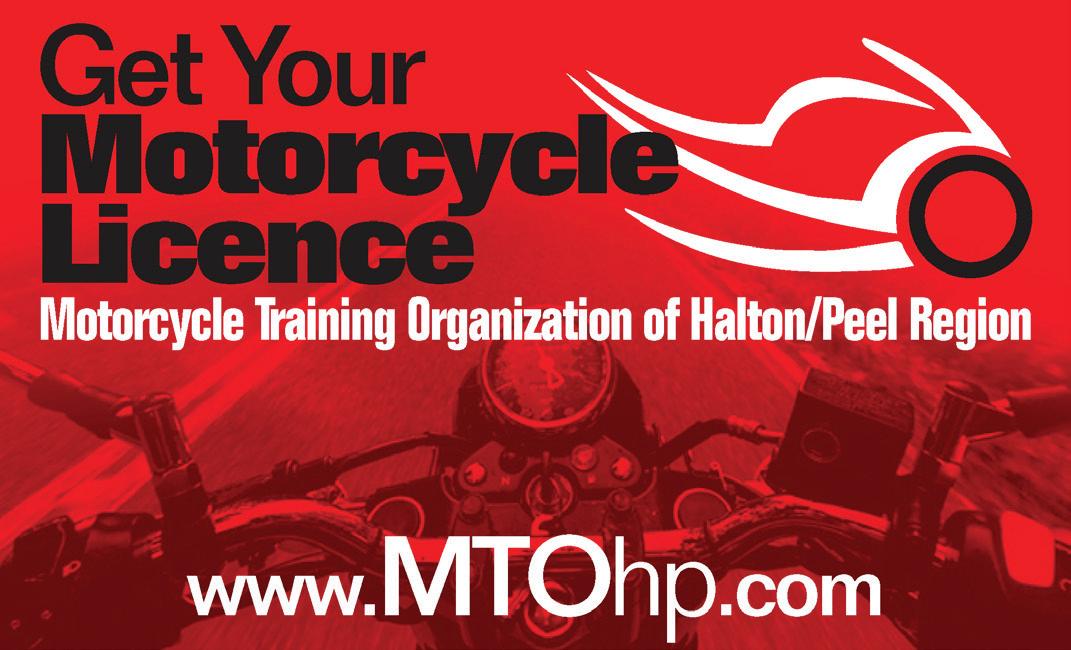
InsideMotorcycles.com 67
SUZUKI’S GP GAME CHANGER: THE RG500 SQUARE FOUR
By Graham Clayton
In the early 1970s Suzuki, like fellow Japanese rival Kawasaki, initially competed in the FIM 500 cc GP World Championships with a racing version of one of its twostroke street bikes, namely the air-cooled Titan or Cobra 500 twin. Suzuki’s racer, designated the TR500 or XR05, made its GP debut in 1971. The slim lightweight twin handled well, developed 70-plus horsepower at 8,000 rpm and could top 242 km/h (150 mph) in fifth gear. This level of performance and the racing skills of XR05-mounted Keith Turner (NZ), Rob Bron (NED) and Jack Findlay (AUS) placed them second, third and fifth overall in the 1971 500 GP standings behind Giacomo Agostini and his works MV Agusta four-stroke triple.
Suzuki’s 1971 GP successes encouraged the firm to continue development of its XR05 racer for 1972. As it turned out no Suzuki racer finished inside the top ten of the 1972 500 GP championship. A faster 80 hp water-cooled version of the XR05 was built and raced in 1973. This, however, was a stopgap measure for by then Suzuki had committed to build a new multi-cylinder two-stroke with which to contest the 1974 500 GP World Championship. This was the RG500 square four.
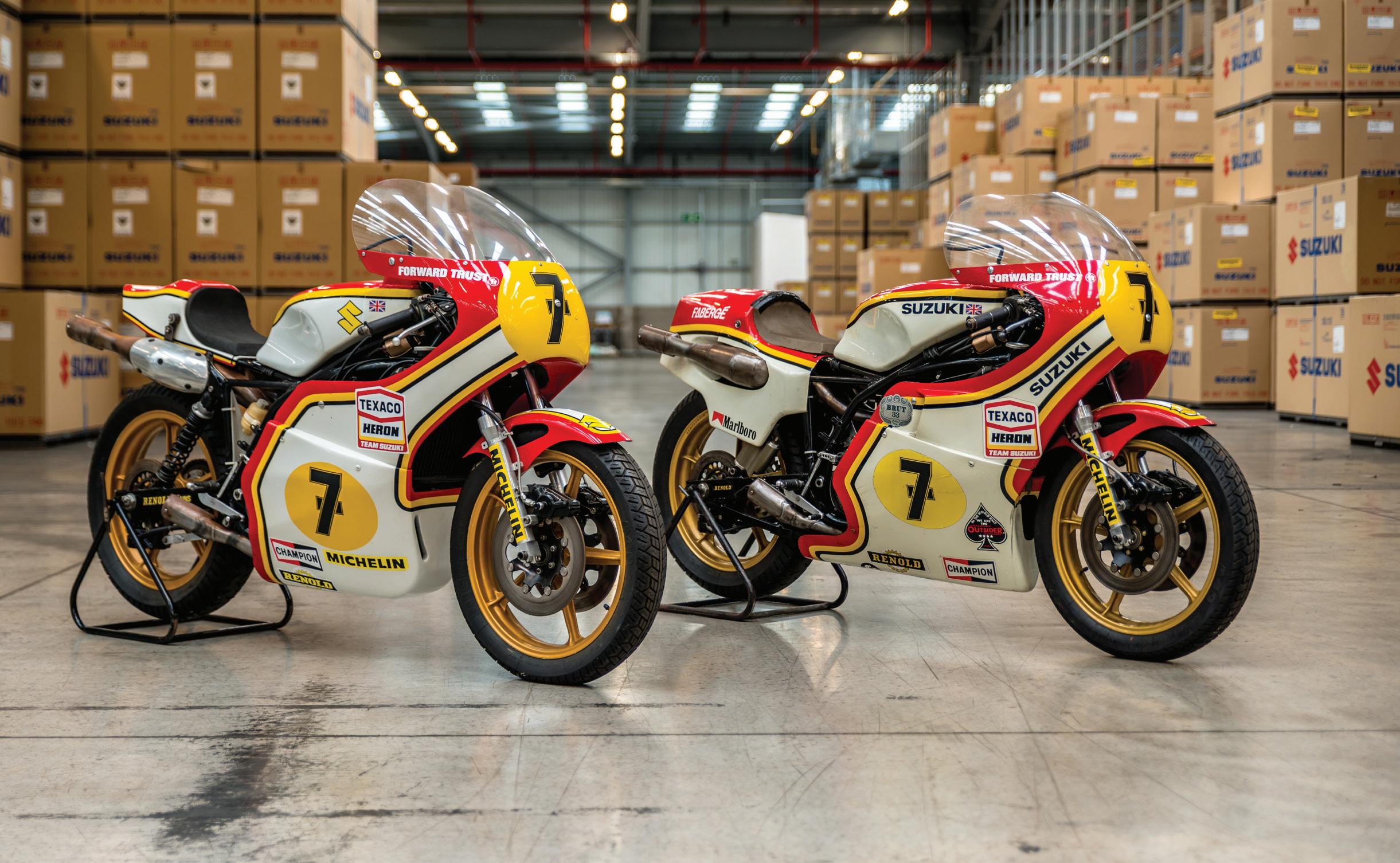
Suzuki had previously built a water-cooled 250 cc GP discvalve square four in the early 1960s to compete with Honda’s 16-valve works fours and Yamaha’s RD56 disc-valve twins. Introduced at the 1963 season-ending Japanese Grand Prix Suzuki’s RZ63 was built-up by pairing two 125 cc twin-cylinder engines, one behind the other, with a shared bottom end and innovative water-cooled cylinders and heads. The connected twin crankshafts had the front crank rotating clockwise and the rear crank counter-clockwise with the final drive coming from the rearward crank. The bore and stroke dimensions were 43 mm x 42.6 mm for a swept volume of 247.3 cc. Ignition was by magneto. Fitted with a six-speed gearbox and dry clutch, four 24 mm side-mounted Mikuni carbs and four expansion chambers, the bike generated a class leading 52 hp at 12,500 revs with a top speed of 225 km/h (140 mph).
This engine was mounted into a steel-tube cradle frame, which employed a telescopic front fork and a twin shock swingarm, rolled on 18-inch spoked alloy rim wheels fitted with drum brakes, the front one being a 4-leading-shoe double-drum unit. The bike had wicked straight-line speed, but over the 1964 and
68 Inside Motorcycles
‘65 seasons suffered from ill-handling at high speed, unreliability and was prone to sudden piston seizures at high speed. This unsettled its riders who came to refer to it as “whispering death.”
Multiple frame changes were made to sort out the bike’s handling while carb and other engine changes to the cooling system, ignition, etc., improved the its power output, rideability and top speed. The bikes were removed from GP competition after the Belgian GP both in 1964 and 1965. In its final RZ65 eight-speed version the bike produced 56 hp at 12,850 rpm with top speed of 238 km/h (148 mph). Its only two GP podiums were two third place finishes by Bert Schneider at the 1964 French GP and Frank Perris in the 1965 IoM 250 TT.
Despite the disappointing results achieved by the RZ 250s, the knowledge and experience gained by Suzuki racing them would prove very useful in the design and development of the RG500s. Similar benefits would also be gained from racing Suzuki’s 280-plus km/h (175 mph) tire shredding, frame flexing 100-plus hp TR750 triples beginning in 1972.

The original Suzuki Japan works RG500s, designated XR14, were ready for the opening French round of the 1974 FIM championship with Barry Sheene, Jack Findlay and Paul Smart the team riders. The design of the RG engine drew heavily on the layout of the earlier RZ 250s, the most notable difference being that each of the four cylinders had a separate crankshaft, barrel and head that shared a common crankcase. The tops of the four cylinder heads were all in the same slightly downward sloping plain. Each of the four cranks utilized an inboard gear to connect to a single wide gear located centrally in the engine block to provide drive via a six-speed gearbox to the rear wheel. The isolation of each of the four cylinders enabled mechanics to work on each cylinder separately without having to take the top off all four cylinders as was the case with the RZ 250s.
The bore and stroke measures for the 497.5 cc engine were 56 mm x 50.5 mm. The fuel-feed system employed four side-mounted 34 mm Mikuni carburetors each feeding a rotary-disc intake to five-port cylinders. The compression ratio was 8:1 with ignition provided by a Nippondenso CDI magneto. The front two cylinders had forward-facing exhaust ports with under-slung expansion chamber exhausts, while the rear cylinders had rearward-facing high exhausts exiting just below the rider’s thighs. The engine peak power was 90-plus hp at 10,500 rpm with a 2,500 rpm powerband starting at eight grand.
The bike’s chassis employed a double-cradle full-loop steeltube frame with the radiator mounted to the front downtubes. The RG500 engine was mounted in the frame at a forward inclined angle. The front suspension employed a Kayaba telescopic fork with a twin shock swingarm rear. The bike rolled on 18-inch wheels fitted with dual 270 mm disc front brakes and a smaller 250 mm single rotor rear unit. The bike weighed 135 kg (298 lb) dry and was good for 280-plus km/h (175 mph).
The 1974 and 1975 GP seasons were development years for the RG500 during which the reliability, handling and performance of the machines were improved. Suzuki Japan turned over the running of the team to Heron Suzuki GB in 1975 while it focused on the development of a much-improved special version of the works XR14. Those bikes had a 54 mm bore and stroke displacing 494.7 cc, produced 114 hp with a 7,000 to 11,000 rpm powerband, and were 5 kg (11 lb) lighter. Three of these racers were shipped to Texaco Heron Suzuki for the 1976 FIM 500 GP
series and were raced by Barry Sheene. Teammates John Newbold and John Williams rode the previous year’s works bikes. Suzuki Japan also produced an initial batch of 25 over-thecounter RG MkI production racers that were quickly scooped up by top privateers.
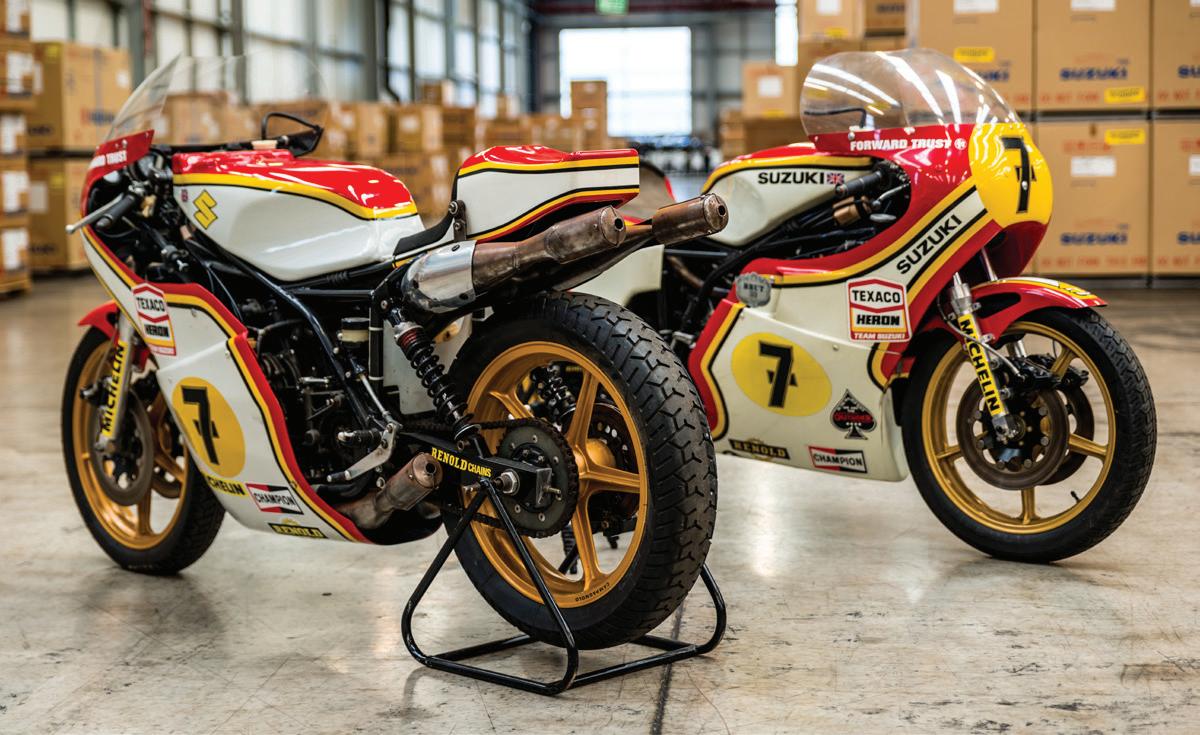
Sheene won the 1976 500 crown with victories in France, Austria, Italy, Holland and Sweden, plus a second in Belgium. The following top 11 GP points winners in the 1976 championship all rode RG500s. Sheene won the series again in 1977 with six GP wins. Yamaha racers Steve Baker, Johnny Cecotto and Giacomo Agostini finished in second, fourth and sixth place respectively. However, all except two of the remaining 26 GP points-winning racers in the championship rode RG500 square fours, mostly the 103 hp production MkI. Every following year up to 1987 the Mk customer bikes were upgraded with various changes to frames, suspension, carbs, exhausts, bodywork, etc., including stuff from the previous year’s works XR machines.
1978 would mark the arrival of Yamaha superstar Kenny Roberts with the Yamaha power-valve OW35 500 four. By then Suzuki had developed the RGA XR22 stepped version of the RG500 which had the two rear cylinders raised higher than the front two, an innovative casette gearbox, produced 120 hp, and
Opposite page, above top: Barry Sheene’s 1976 and 1977 world championship winning Suzuki RG500s side by side. Above: The move to dual front discs provided the stopping power required by the powerful RG500.
InsideMotorcycles.com 69
PHOTOS COURTESY OF TEAM CLASSIC SUZUKI.
was good for 300 km/h (186 mph). Roberts edged out Sheene for the championship by ten points, with Yamaha teamsters Cecotto and Katayama finishing third and fifth. All but three of the other 26 championship points-winning racers rode RG500s, mostly the MkII. That year Sheene’s American teammate Pat Hennen also got an XR22, as did Will Hartog (fourth overall) and then Michel Rougerie after Hennen was seriously injured at the IoM TT.
Virginio Ferrari was also supplied with an XR22 in 1978 for the season-ending German Grand Prix which he won thereby giving Suzuki its third consecutive 500 cc GP Manufacturers’ Championship. Suzuki would win the manufacturers’ crown with RG500s for four more years until Honda’s Freddie Spencer beat Kenny Roberts in 1983, Roberts’ last year as a GP racer.
By this point in time, it was clear that Suzuki’s production RG500 was the privateers’ bike of choice. In 1979 Kenny Roberts won his second 500 GP crown riding Yamaha’s works OW45. Finishing directly behind him in the title race were
CANADIAN RETAILER DIRECTORY
Island BMW - Victoria, BC
Tel: (250) 474-2088
Vi Powersports - Nanaimo, BC
Tel: (250) 754-6638
High Road Vancouver - Vancouver, BC
Tel: (604) 731-5505
High Road Langley Langley, BC
Tel: (778) 366-1999
Kelowna Powersports - Kelowna, BC
Tel: (250) 860-1111
Argyll Motorrad - Edmonton, AB
Tel: (780) 435-6811
Barnes Powersports Blackfoot - Calgary, AB
Tel: (403) 243-2636
FFUN Motorcycle Company -Saskatoon, SK
Tel: (306) 934-5390
Headingley Sport Shop - Headingley, MB
Tel: (204) 889-5377
BMW Motorrad Barrie - Barrie, ON
Tel: (705) 881-1420
Budds’ Motorrad - Oakville, ON
Tel: (905) 845-3577
Ferrari, Sheene and Hartog riding Suzuki’s 124 hp works RGB500 XR27B, plus six other Suzuki racers. Eighty-three percent of that year’s points winning racers rode square four Suzukis, most riding the now more rider friendly 54 mm x 54 mm MkIV with 110 hp at 11,000 and 275 km/h (170 mph) top speed.

Kenny Roberts made it three in a row in 1980 with Suzuki runners-up Randy Mamola, Marco Lucchinelli, Franco Uncini, Graziano Rossi and Wil Hartog now all riding works XR34s.
Suzuki’s last two RG500 square four rider and manufacturer GP crowns came in 1981-82 thanks to Italian teams managed by Roberto Gallina. Marco Lucchinelli won the 1981 title with Randy Mamola second using the 130 hp/312 km/h (194 mph) works XR35. Franco Uncini repeated the win convincingly in 1982. By then the MkVII had a 115 hp twin-crank, stepped engine. Suzuki would soldier on with its square four for five more years, but increasingly its day had passed. It would need a new V-four to win again. IM
BMW Toronto - Toronto, ON
Tel: (416) 623-4269
Maranello BMW Motorrad - Woodbridge, ON
Tel: (416) 213-5699
GP Bikes - Whitby, ON
Tel: (905) 428-8983
Wolf BMW - London, ON
Tel: (519) 951-9482
Ottawa Motorrad - Ottawa, ON
Tel: (613) 731-9071
Gabriel BMW Moto - Montréal, QC
Tel: (514) 712-7777
Moto Vanier - Québec, QC
Tel: (418) 527-6907
Estrie BMW - Sherbrooke, QC
Tel: (819) 821-3595
Carrier BMW - Drummondville, QC
Tel: (819) 395-2464
Nadon BMW - St-Eustache, QC
Tel: (450) 473-2381
Rallye Motoplex - Dieppe, NB
Tel: (506) 383-1022
Rallye Motoplex NS - Halifax, NS
Tel: (800) 572-5593
Avalon Motorrad - St John’s, NL
Tel: (709) 726-6500
70 Inside Motorcycles
Above: Sheene piloted this RG500 to the 1976 world championship scoring victories in France, Austria, Italy, Holland and Sweden. He would go on to defend his title in 1977 with six GP wins.
PHOTO COURTESY OF TEAM CLASSIC SUZUKI.
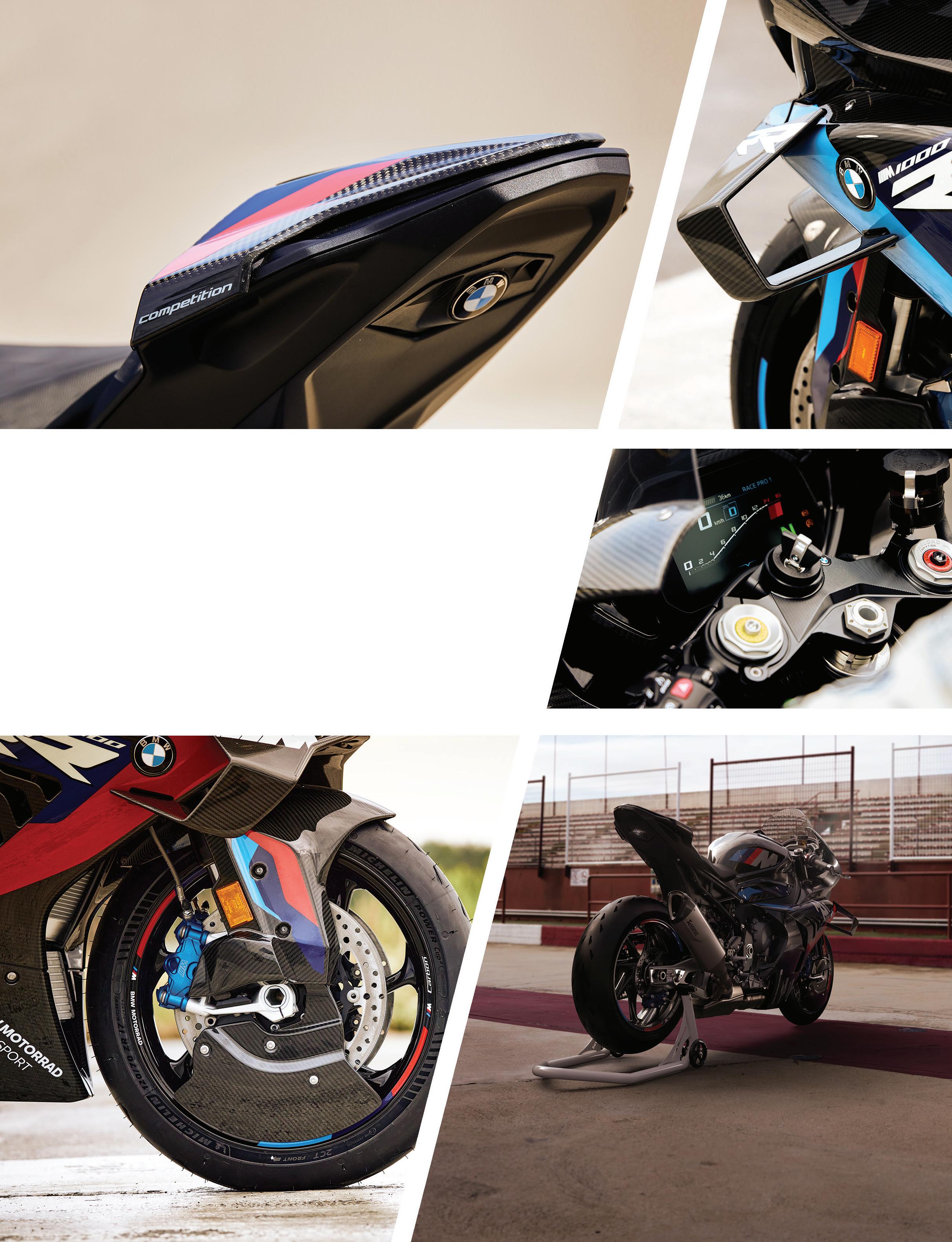
ADMIRED FROM ALL ANGLES… MOSTLY SEEN FROM BEHIND MAKE LIFE A RIDE © 2023 BMW Motorrad Canada. “BMW”, the “BMW Logo”, all BMW model designations and all other related marks, images and symbols are the exclusive properties and/or trademarks of BMW AG, used under licence. Scan to find a Retailer.
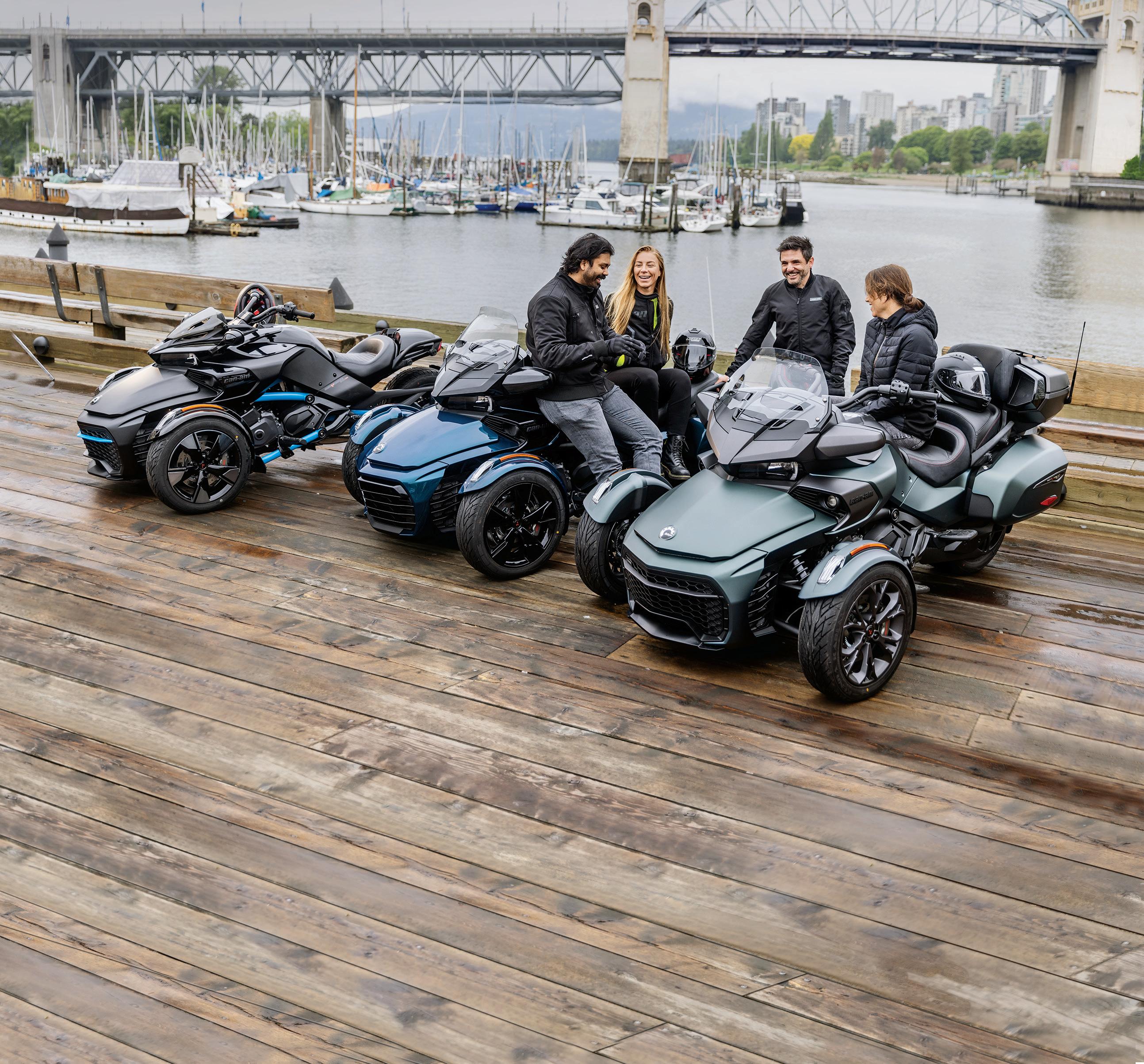



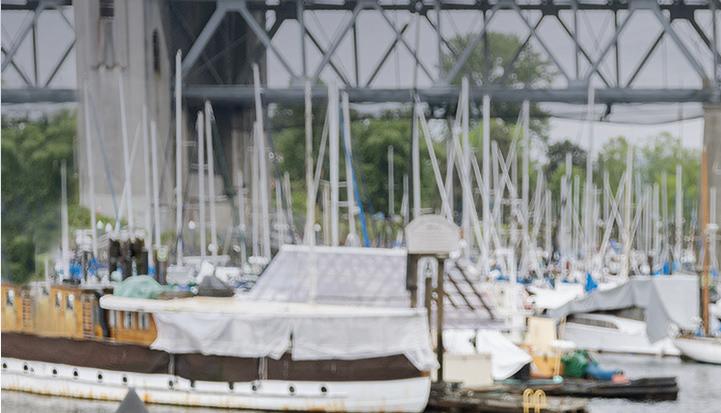
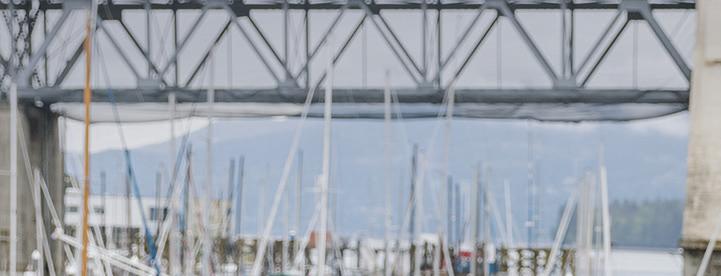


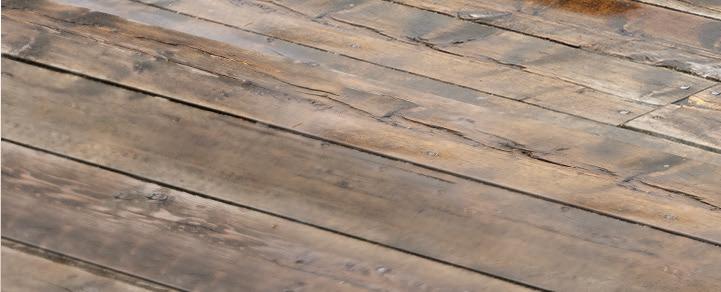
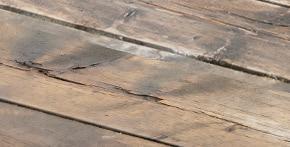


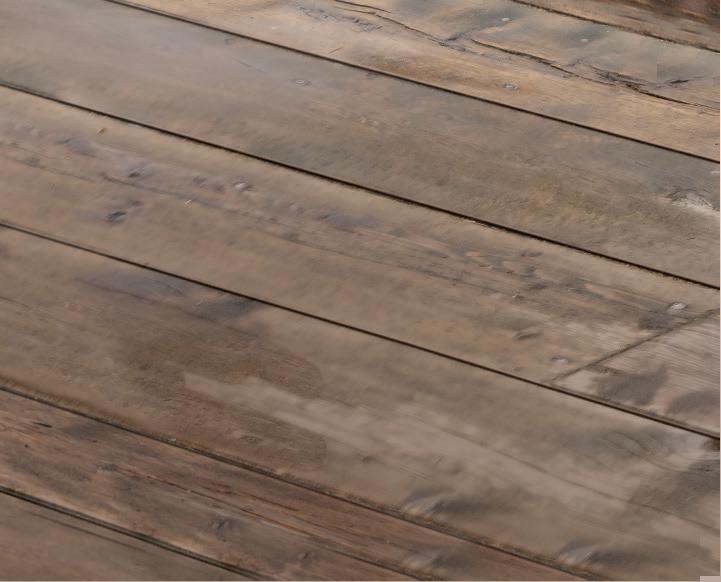
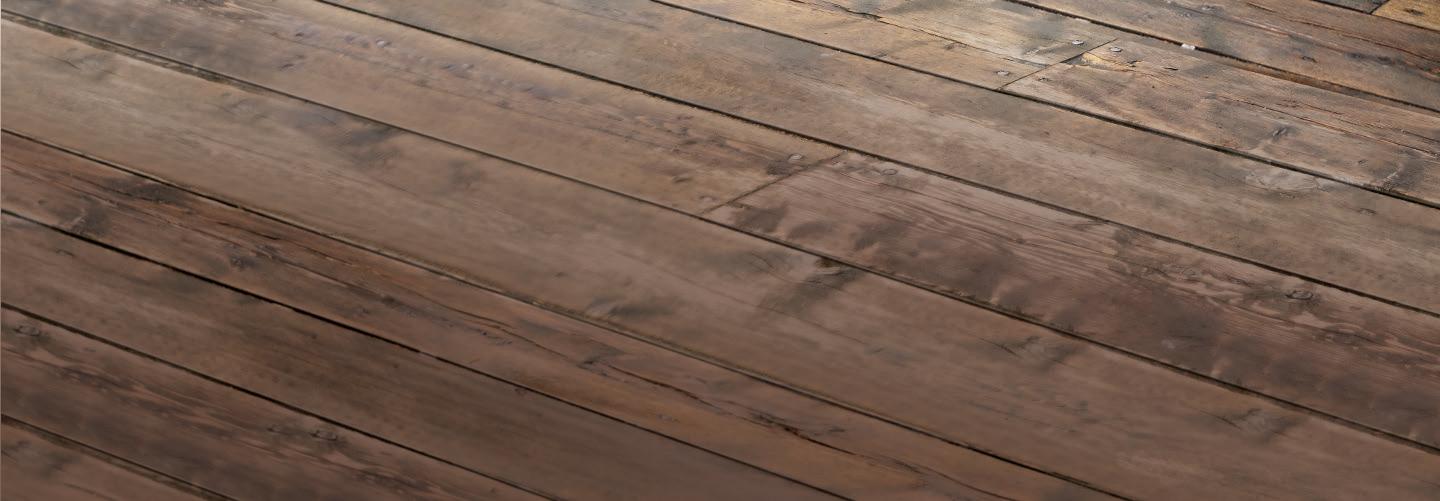

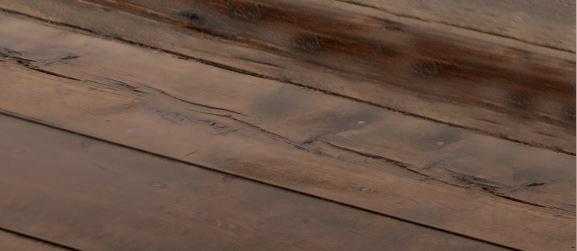
more at canamonroad.ca/models
Learn
thrilling ride ©2023 Bombardier Recreational Products Inc. (BRP). All rights reserved. ®, ™ and the BRP logo are trademarks of BRP or its a liates. †All other trademarks are the property of their respective owners. BRP reserves the right to discontinue or change speci cations, prices, designs, features, models or equipment without incurring obligation. Some models depicted may include optional equipment. Carefully read the operator’s guide and safety instructions. Observe applicable laws and regulations. Always wear appropriate protective clothing, including a helmet. Riding, alcohol and drugs don’t mix. Always ride responsibly and safely. See your authorized BRP dealer for detailsand visit canamonroad.ca.
WE CAN ALL find a































































 2023 BMW R 1250 RS
2023 BMW R 1250 RS














 2023 Suzuki GSX-8S
2023 Suzuki GSX-8S





























 Hwy 28 hugs the shore of Upper Campbell Lake on the way to Gold River.
Mixing it up on the Sea to Sky Highway with seven Lamborghini was a highlight.
BC Ferries provides wedge blocks to stabilize your bike while crossing the Strait of Georgia.
Hwy 28 hugs the shore of Upper Campbell Lake on the way to Gold River.
Mixing it up on the Sea to Sky Highway with seven Lamborghini was a highlight.
BC Ferries provides wedge blocks to stabilize your bike while crossing the Strait of Georgia.




 (Top) Hester Creek Estate Winery features a restaurant, and a villa with six suites that provide one of the best views in the Okanagan wine county. (Above) For racing fans visiting the Hester Creek Estate, Area 27 Motorsports Park (above) is just an 11-minute drive away from the winery. PHOTOS COURTESY HESTER CREEK ESTATE WINERY AND PATRICK LAMBIE
(Top) Hester Creek Estate Winery features a restaurant, and a villa with six suites that provide one of the best views in the Okanagan wine county. (Above) For racing fans visiting the Hester Creek Estate, Area 27 Motorsports Park (above) is just an 11-minute drive away from the winery. PHOTOS COURTESY HESTER CREEK ESTATE WINERY AND PATRICK LAMBIE






















































 By John Sharrard
By John Sharrard
















 Photo: Michael Lekas
Photo: Michael Lekas













































